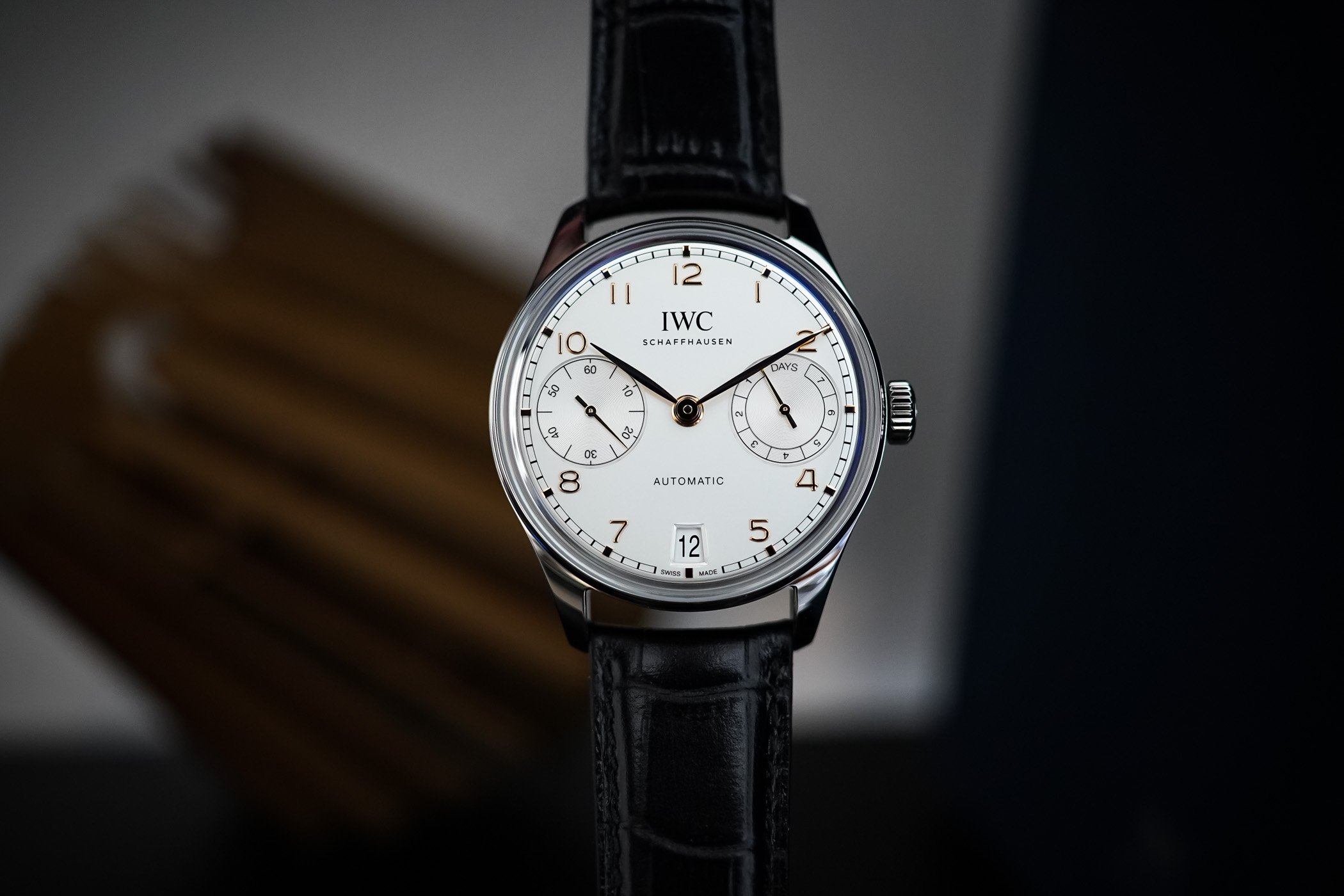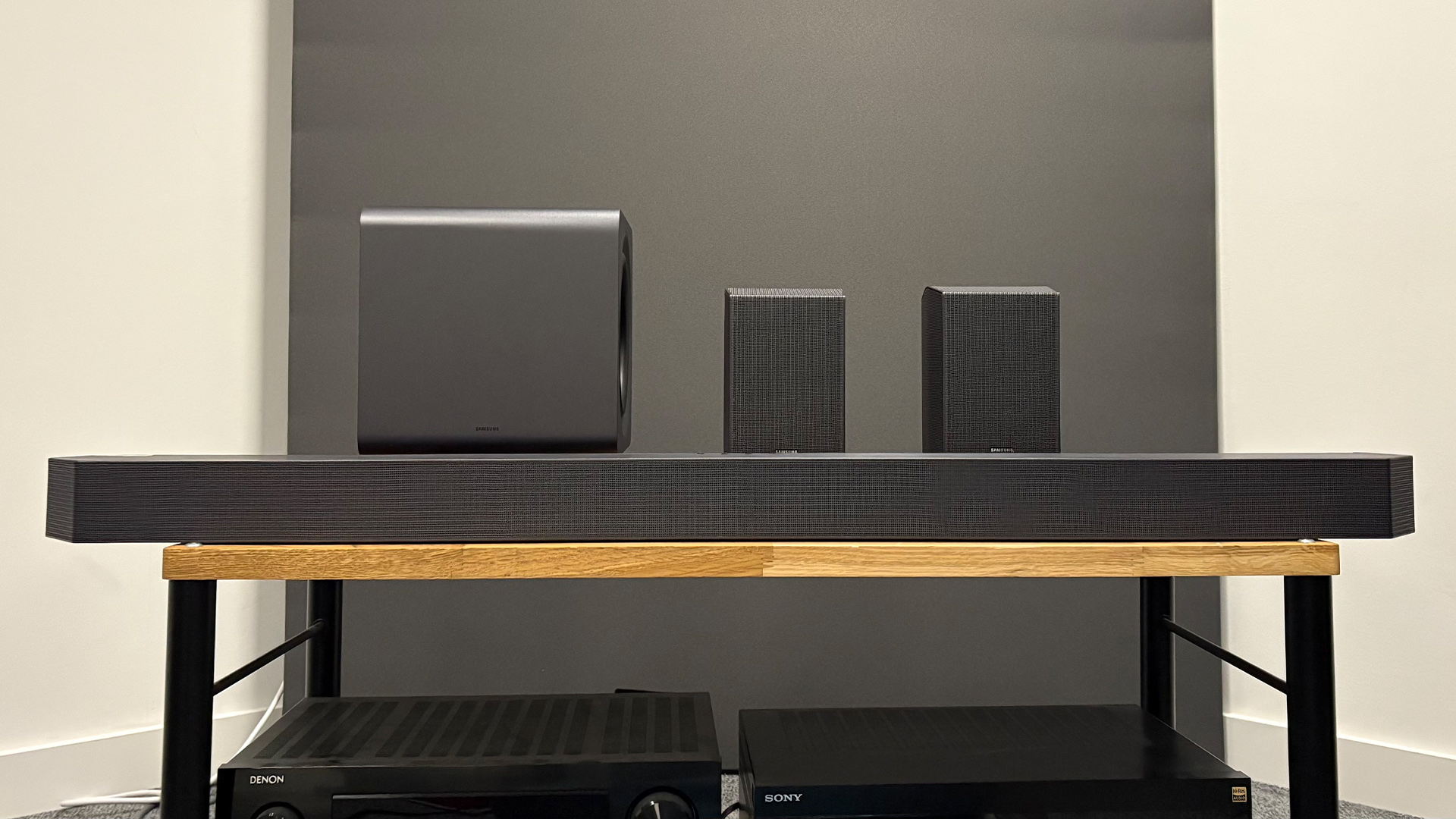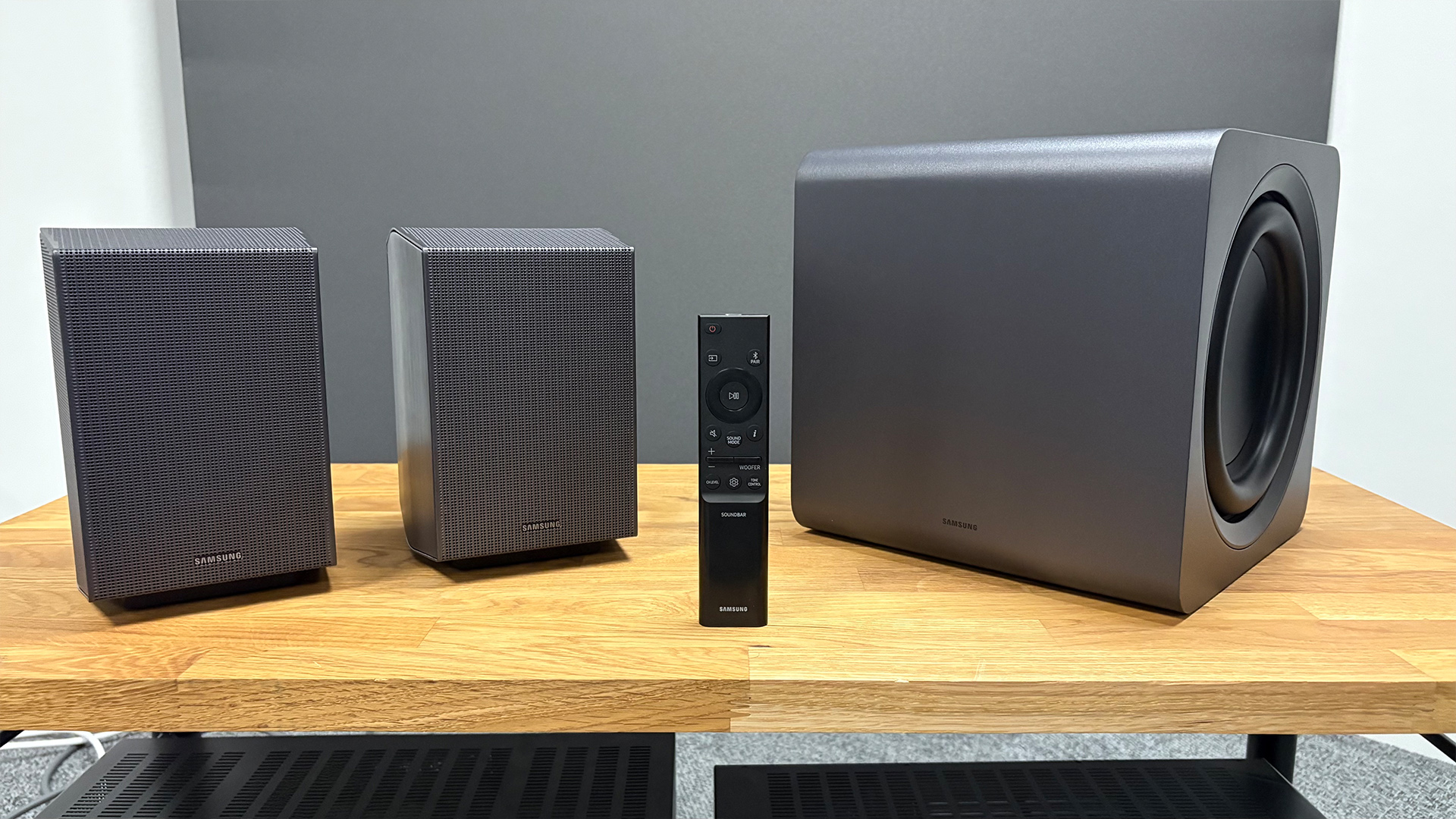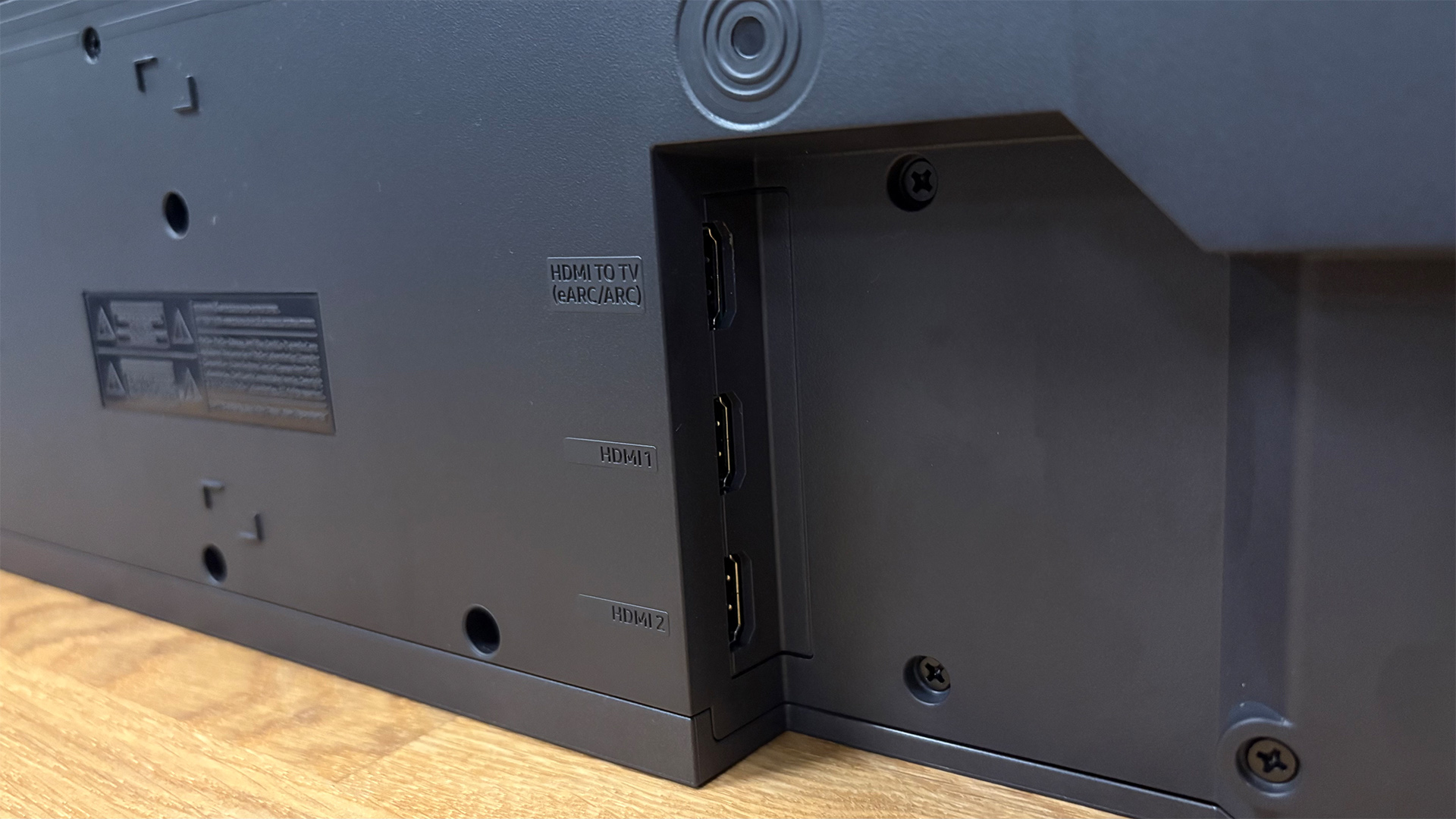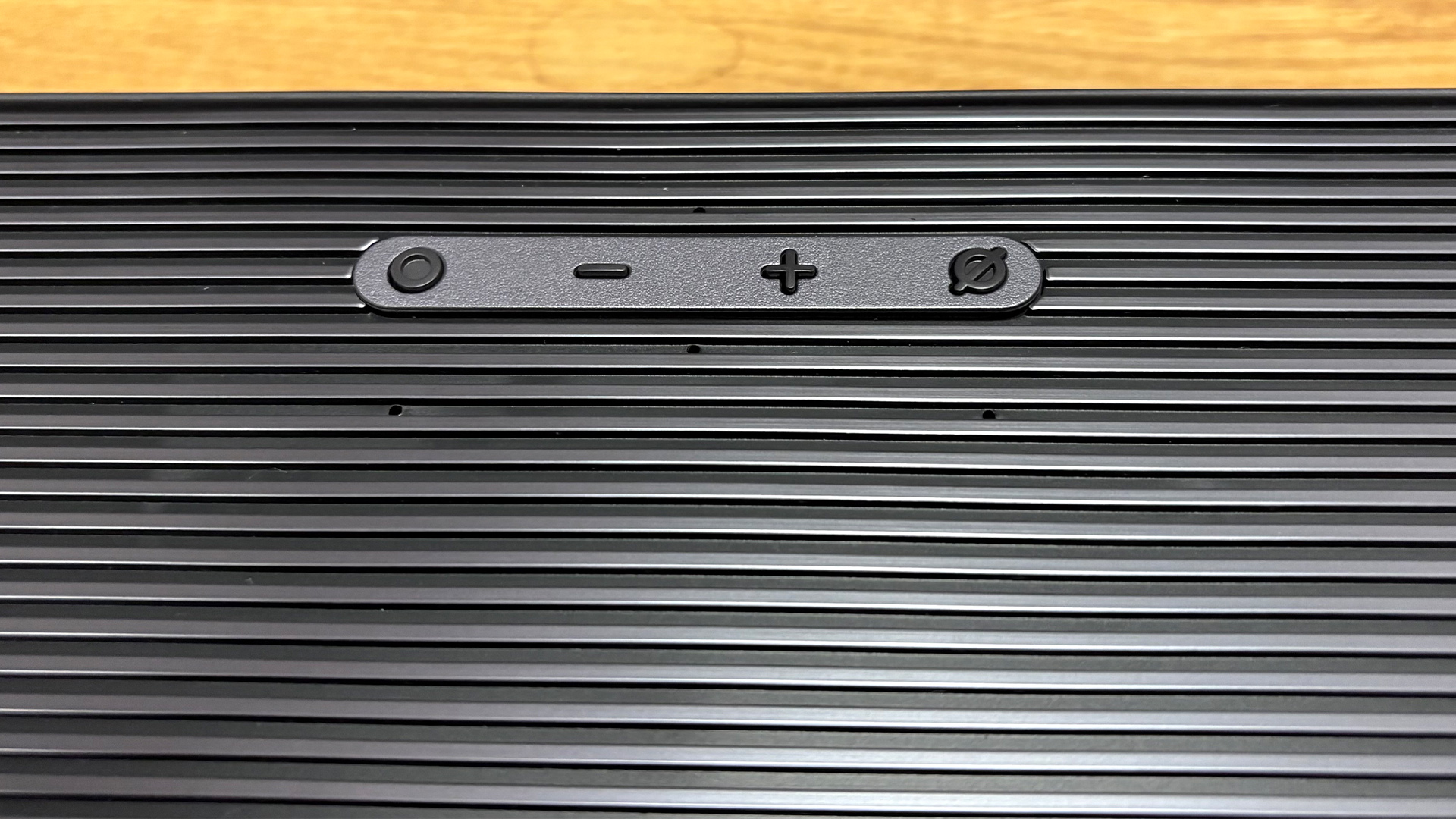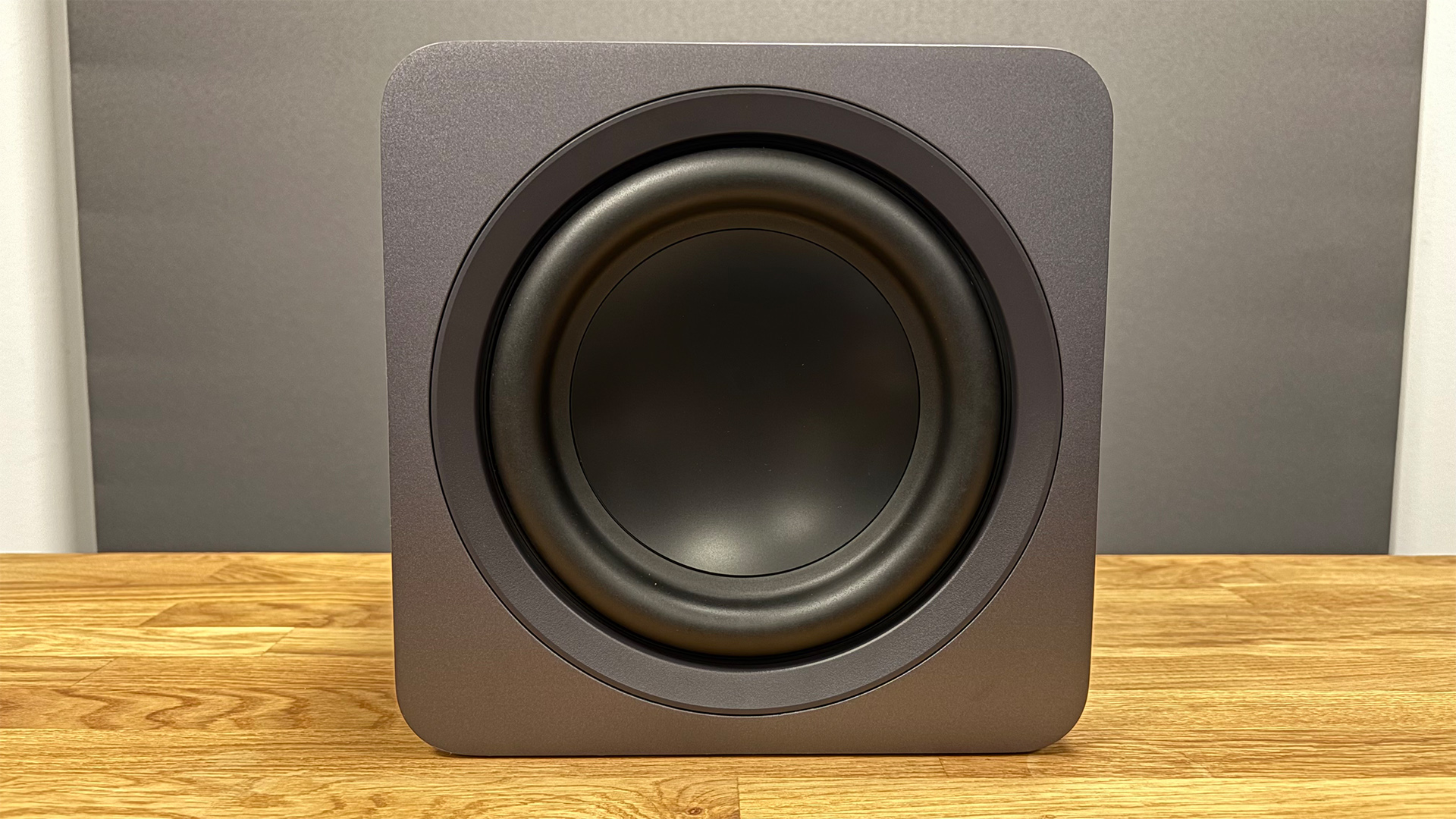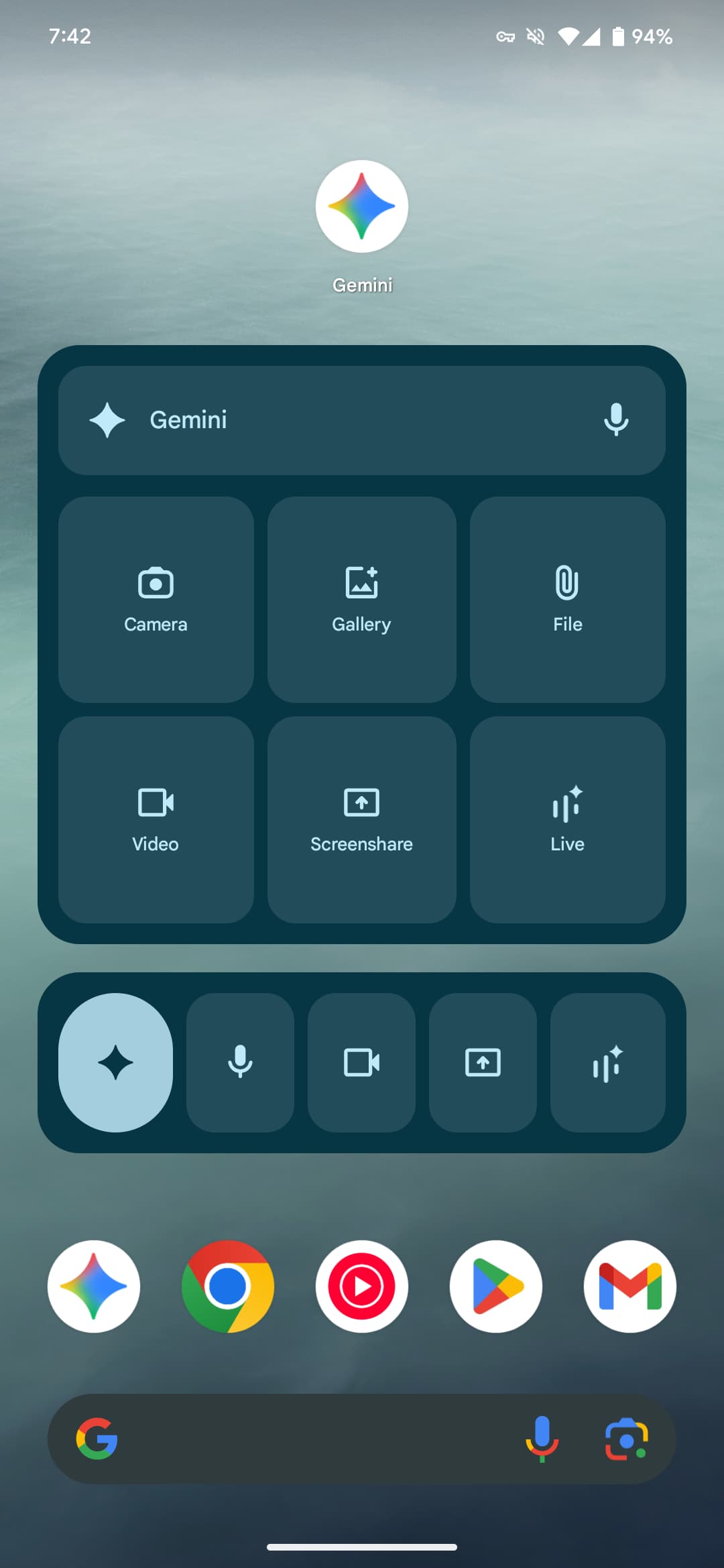Last year marked the 85th anniversary of one of IWC Schaffhausen‘s most important collections, the Portugieser. Originally created in the late 1930s, the story of this wristwatch series begins with a special request from two Portuguese wholesalers, Rodrigues and Teixeira. They approached IWC with a simple but ambitious goal: to create a wristwatch with the precision of a marine chronometer. The result would become Reference 325, the foundation of the Portugieser series, although its early story is more exciting than often retold.
Ukraine First, Portugal Later
At its inception, the watch was not known as the Portugieser, or even Portuguese. However, in deference to the German-speaking home town of IWC in Schaffhausen, we shall refer to it as the Portugieser, even though the company preferred the English variant for quite some time after officially naming the series. Instead, it was catalogued by IWC under its case designation, Mod. 228. The 325 reference number would only appear later once the model gained more definition. The first delivery was not made to Portugal; the very first watches were delivered in February 1939 to a Ukrainian wholesaler, L. Schwarcz, in Odessa. A few months later, further units were shipped to Lviv (then part of Poland, now Ukraine).
It would take three more years for the watch to arrive in Portugal. The first documented delivery was on 2 February 1942 to the wholesaler Pacheco, followed by a shipment on 17 June 1942 to Rodrigues & Gonçalves in Lisbon. Even then, IWC’s sales records still listed these watches under Mod. 228, the case model number. The company subsequently began referring to the watch as Reference 325 to eliminate confusion.
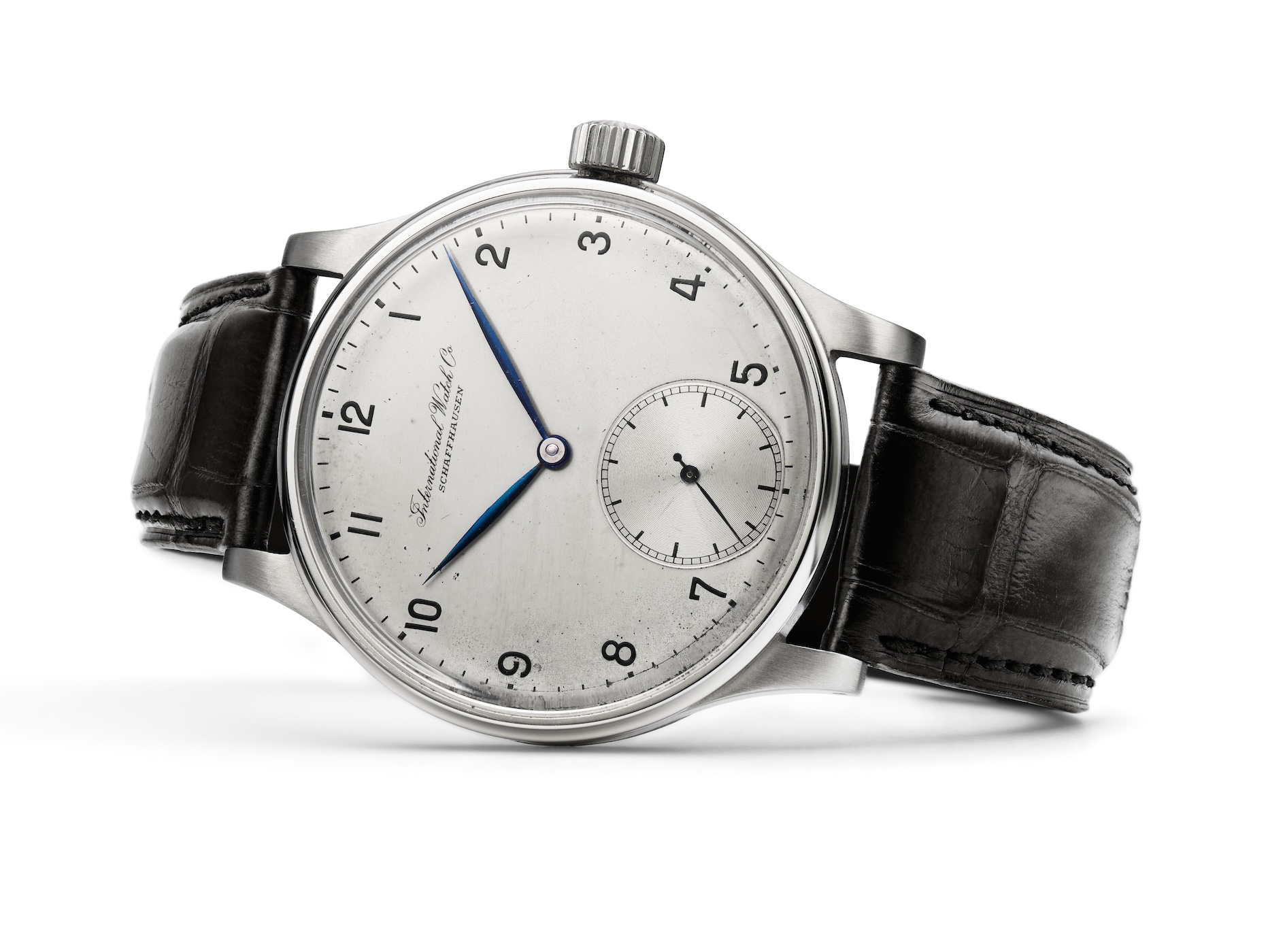
Global conflict played a role in shaping early distribution. During World War II, most of the Reference 325 watches were sent to Eastern Europe, particularly to two retailers in Bratislava: Kuchar & Wittmann and Weinstabel. In the following years, even as peace returned, the model remained relatively obscure. Between 1939 and 1981, IWC produced just 690 examples of the Reference 325. Of those, 141 made it to Portugal, and they can be identified today by a distinctive hallmark on the right lug, mandated by Portuguese customs regulations at the time.
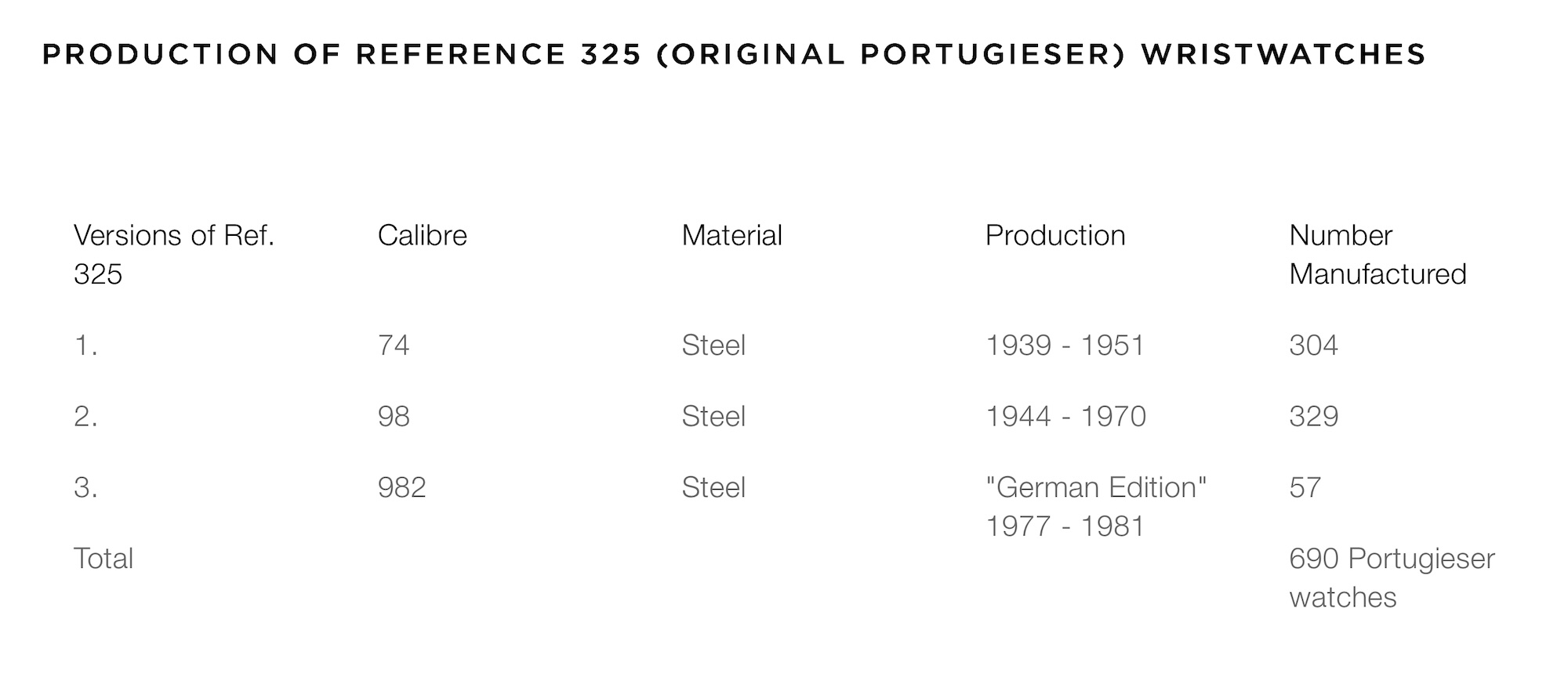

Contrary to its importance today, the precursor to the Portugieser line was left undisturbed for quite some time until circumstances played in its favour. Still, before exploring the collection’s modern rebirth in the 1990s, it’s worth examining the early models more closely in terms of case and movement.
1939-1951 – Reference 325 Calibre 74
From 1939 to 1951, IWC manufactured 309 watches of Reference 325 using the Mod. 228 case, paired with the Calibre 74 movement. Measuring 41.5mm in diameter and 9.5mm thick, the case was produced by Wyss & Cie, a case maker based in Biel. Crafted in Staybrite stainless steel, the case was corrosion- and scratch-resistant and featured a three-part construction: grooved bezel, mid-case, and a snap-on steel caseback, with no water resistance. The mid-section had a satin finish, while the lugs and bezel were polished. A generously sized crown ensured easy winding, a detail that would become a design signature of the Portugieser line.
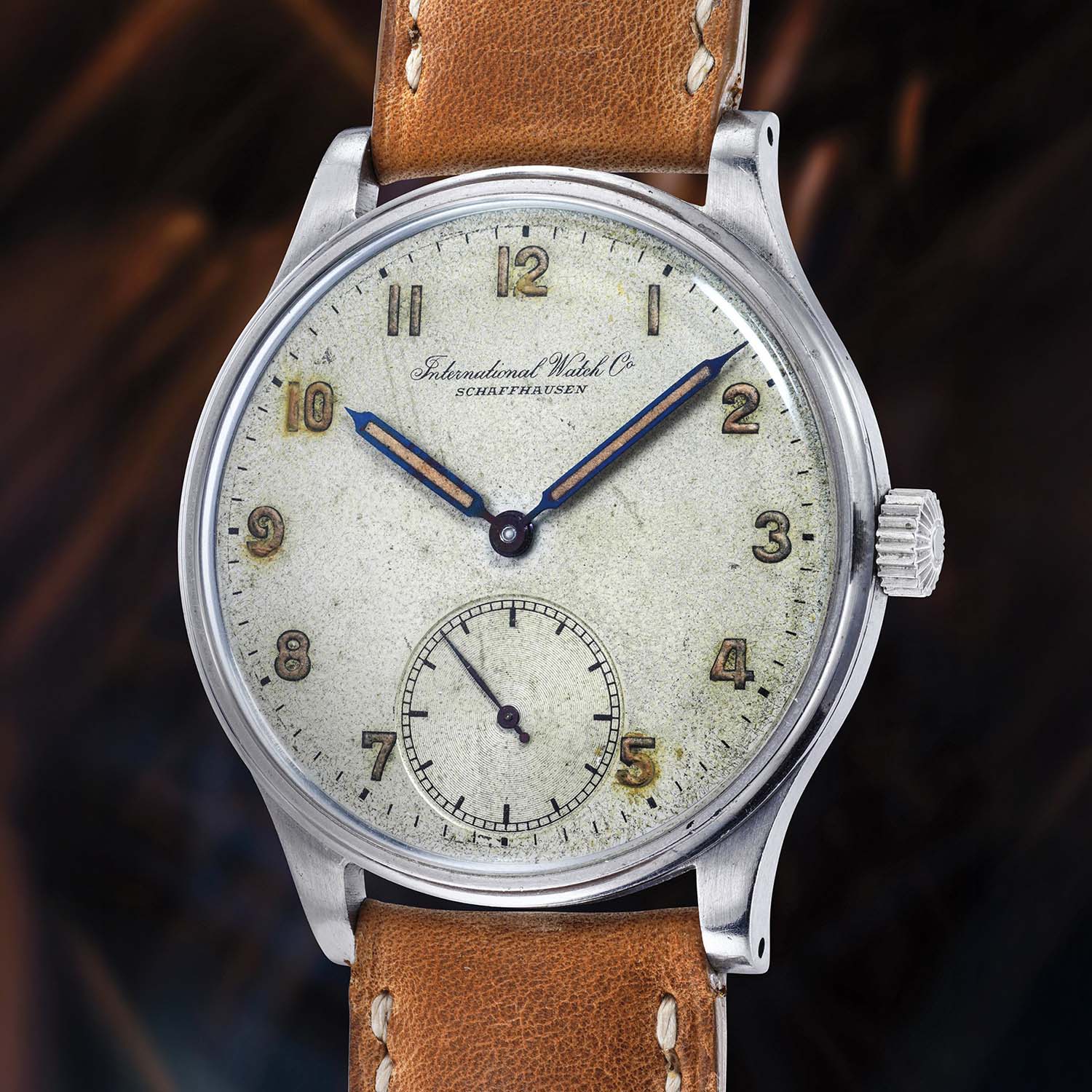

Calibre 74 was a 17-ligne hand-wound pocket watch movement introduced in 1913 and produced until 1931. Measuring 38mm in diameter and 4.2mm thick, it ran at 18,000 vibrations per hour, had a 30-hour power reserve, and featured 16 jewels, a Breguet hairspring, and a bimetallic screw balance with four regulation screws. It also used IWC’s patented large bearings for the crown and ratchet wheels. Initially intended for hunter-case pocket watches (with a crown at 3 o’clock and small seconds at 6), it translated seamlessly into a large, highly legible wristwatch, a perfect match for the ambitious concept.
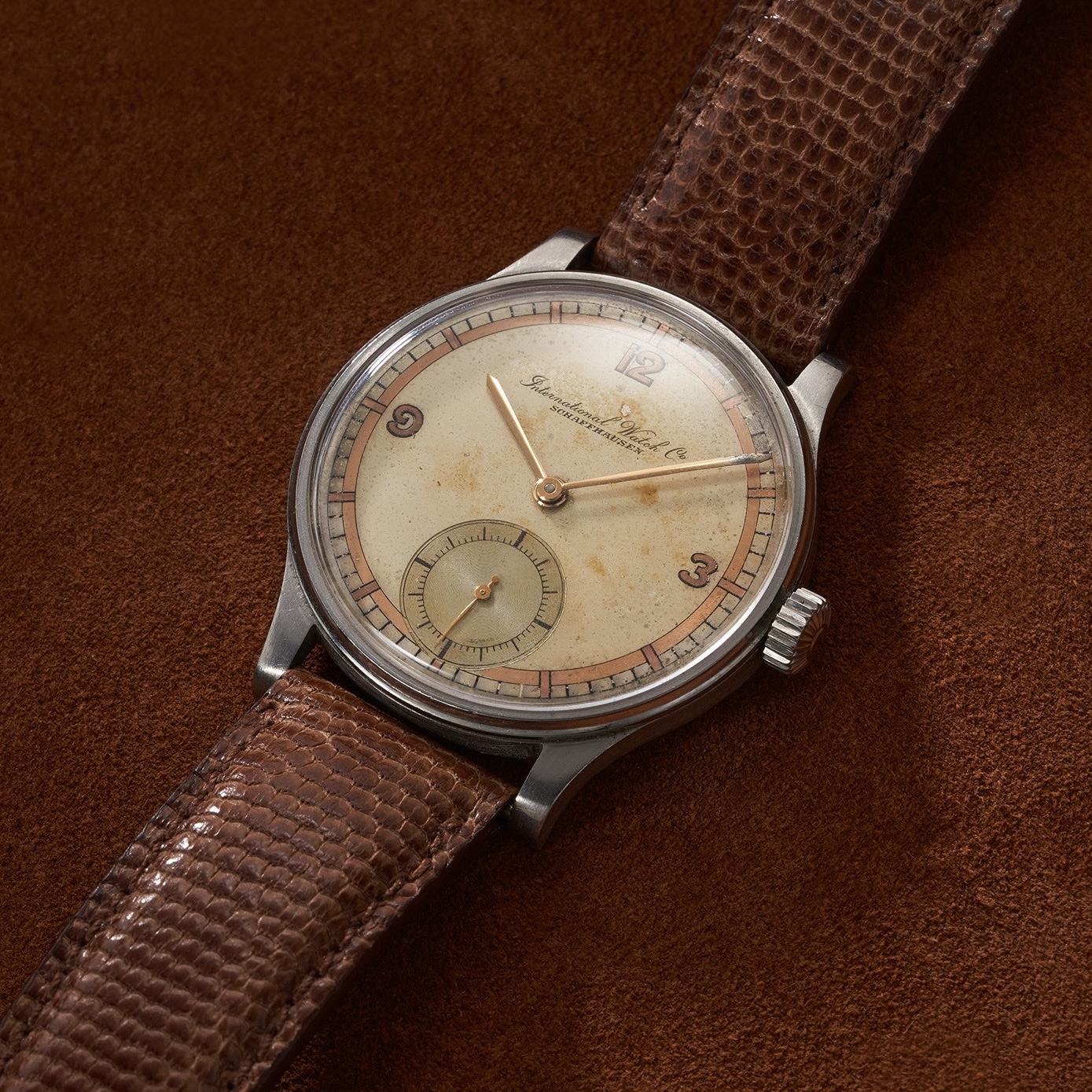

1944-1970 – Reference 325 Calibre 98
Shortly after the first Ref. 325 models were delivered with Calibre 74, IWC began fitting the reference with another movement: Calibre 98, produced from 1936 to 1946. Another Savonette-type pocket watch movement, Cal. 98, shared many characteristics with Cal. 74, including nearly identical dimensions (37.8mm x 4.43mm) and the same frequency (18,000 vph); it also lacked shock protection. However, it was nickel plated and better finished, featuring circular graining and Geneva stripes, whereas the earlier Cal. 74 was only brushed. Otherwise, from the outside, the watches were identical. Between 1944 and 1970, IWC produced 329 examples of the Ref. 325 using Calibre 98.
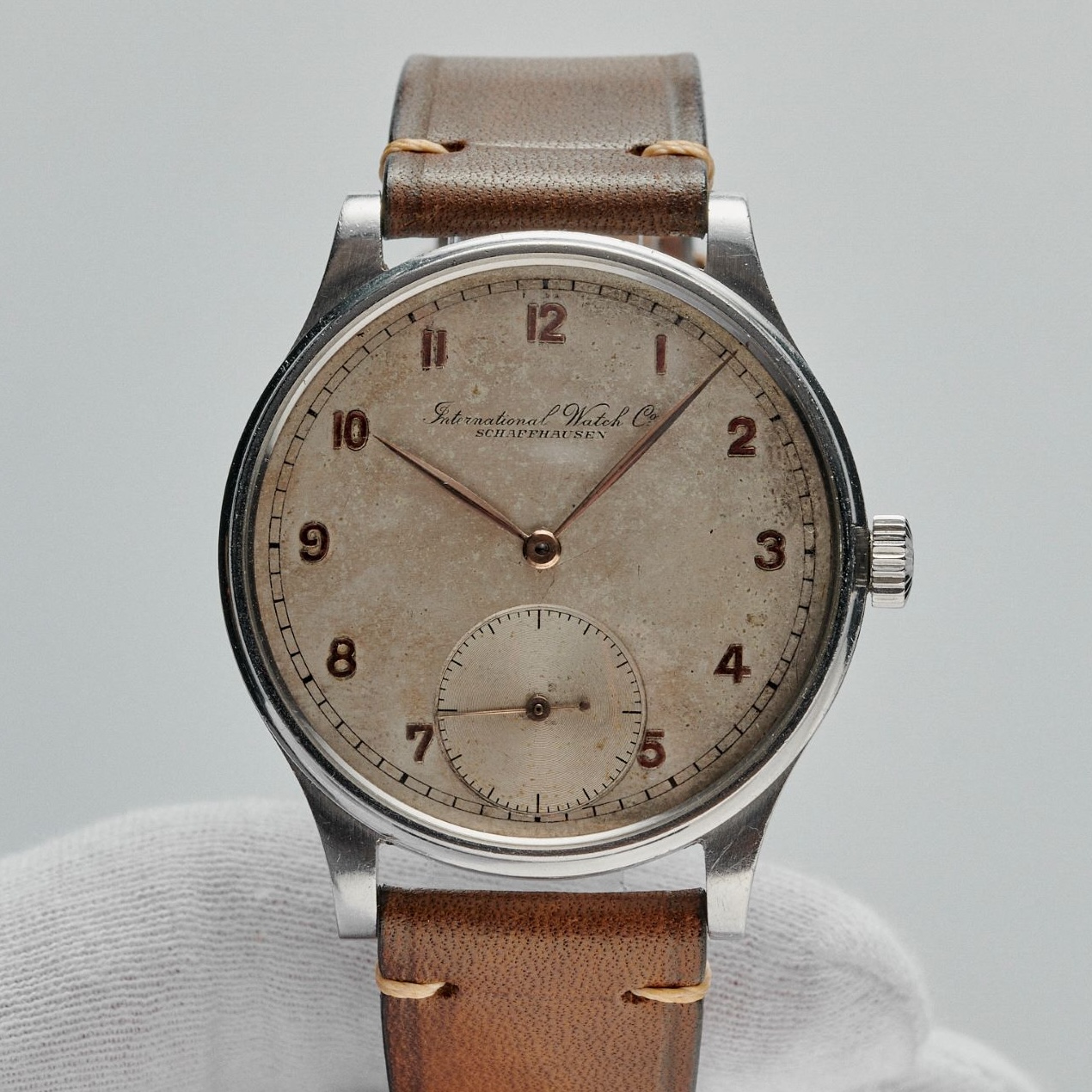

These early models’ dials varied as IWC used multiple styles, including silver-plated and black dials, Arabic or Roman numerals, printed or applied, plain Bauhaus-inspired layouts, and Art Deco-style sector dials. These designs mirrored the aesthetics of IWC’s pocket watches of the late 1930s and provided the Ref. 325 with its understated elegance and functional charm.
1977-1981 – Reference 325 German Edition or Missing Link
The third and final series of IWC’s Reference 325, known as the “German Edition” or the “Missing Link,” was produced between 1977 and 1981. This limited run was originally intended for the Geneva-based dealer Golay Fils & Stahl, but the order fell through. The limited run of 57 watches was eventually sold to a retailer in Frankfurt, giving the series its name, with a few pieces landing elsewhere.
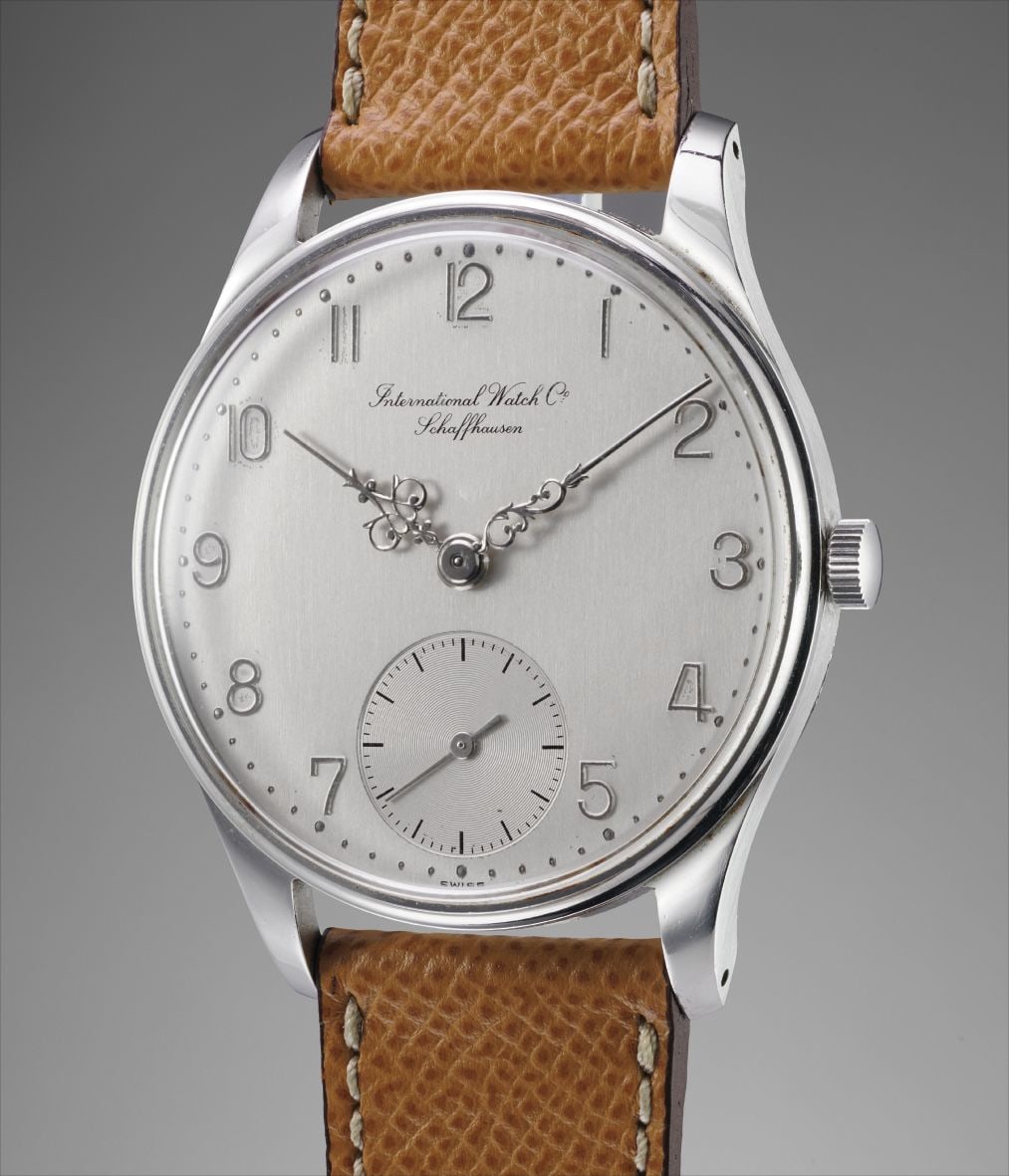

While the German Edition retained the original case design of the Ref. 325, it introduced new dials featuring Louis XV-style details. Inside, it housed the Calibre 982, a refined version of the pocket watch-based Calibre 98 used in earlier Ref. 325 models. Cal. 982, developed in 1967 and produced through 1973 with a total run of 3,600 units, added several upgrades: a shock absorption system, a monometallic Glucydur balance wheel, a swan-neck regulator, and additional balance-arm adjustment cams for fine tuning. These 57 watches marked the end of the original Ref. 325 production until IWC revived the concept in 1993 to celebrate the company’s 125th anniversary.
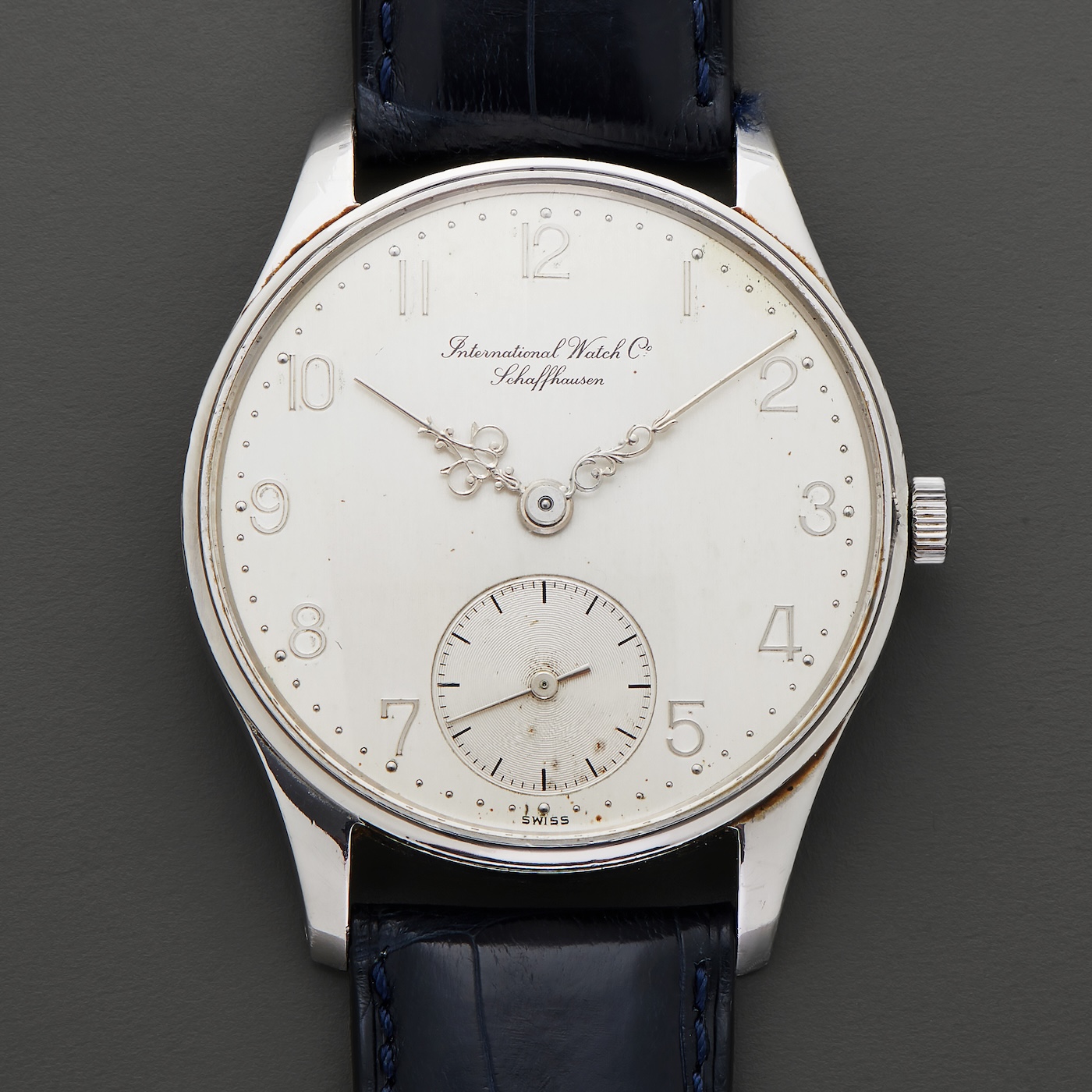

Several accounts offer different takes on what exactly sparked the return of the IWC Reference 325, often citing key figures like Hannes Pantli, then Sales and Marketing Director; master watchmaker Kurt Klaus; and, of course, Günter Blümlein, the visionary behind the resurgence of mechanical watchmaking and IWC’s CEO at the time. Whatever the exact motivation, the timing made sense. By the early 1990s, IWC had weathered the worst of the quartz crisis and emerged stronger, having launched the highly successful Da Vinci Perpetual Calendar in 1985 and the ambitious Grande Complication Ref. 3770 in 1990. Reviving the historic Ref. 325 must have felt logical, symbolic, and a way to honour IWC’s legacy while building momentum for its mechanical future.
1993 – Portugieser Ref. 5441, the Jubilee edition and the rebirth
The 125th anniversary of IWC in 1993 provided the perfect opportunity to revive Ref. 325 with a commemorative model to start a new collection name as we know it: the Portugieser Reference 5441, widely known as the Jubilee edition. Closely following the design of the original, the watch featured a 42mm diameter and a slim 9mm profile, with a matte silver dial showcasing a recessed small seconds sub-dial, dotted minute track, raised Arabic numerals, and slender leaf-shaped hands. Also, it retained the old IWC logo in English script. A sapphire caseback offered a view of the movement, Calibre 9828, a refined version of the pocket watch-based Cal. 982, distinguished by nickel-plated bridges engraved with “International Watch Co. 1868-1993.”
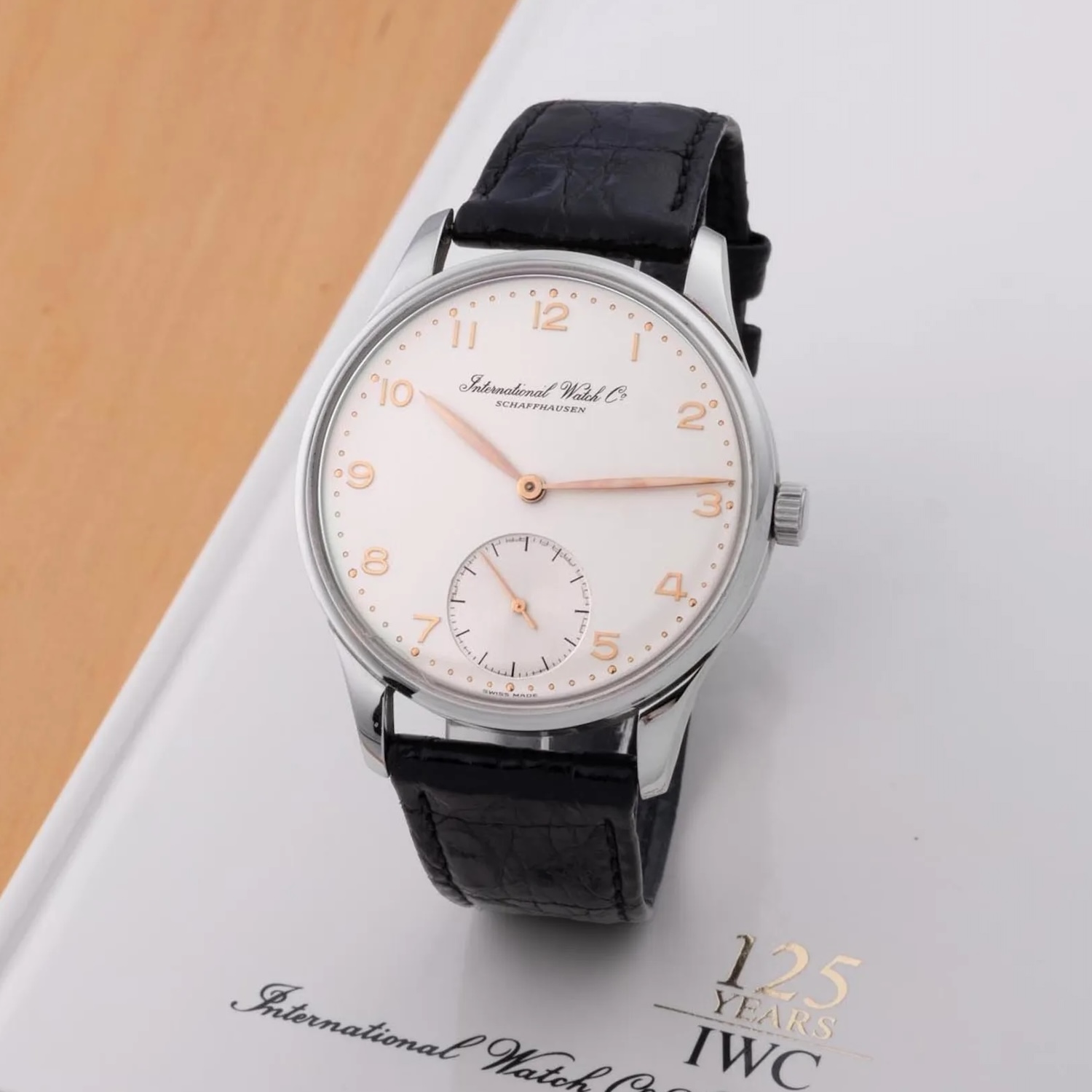

The Portugieser Jubilee was produced in 1,750 pieces: 1,000 in stainless steel, 500 in rose gold, and 250 in platinum, each individually numbered. A special set of 125 box editions containing all three metals was also offered. Despite the relatively generous production, demand quickly outpaced supply, underscoring the model’s immediate success and collector appeal. Additionally, a limited run of 50 pieces was produced for retailer Pisa, featuring cursive blue Breguet numerals and a railroad minute track.
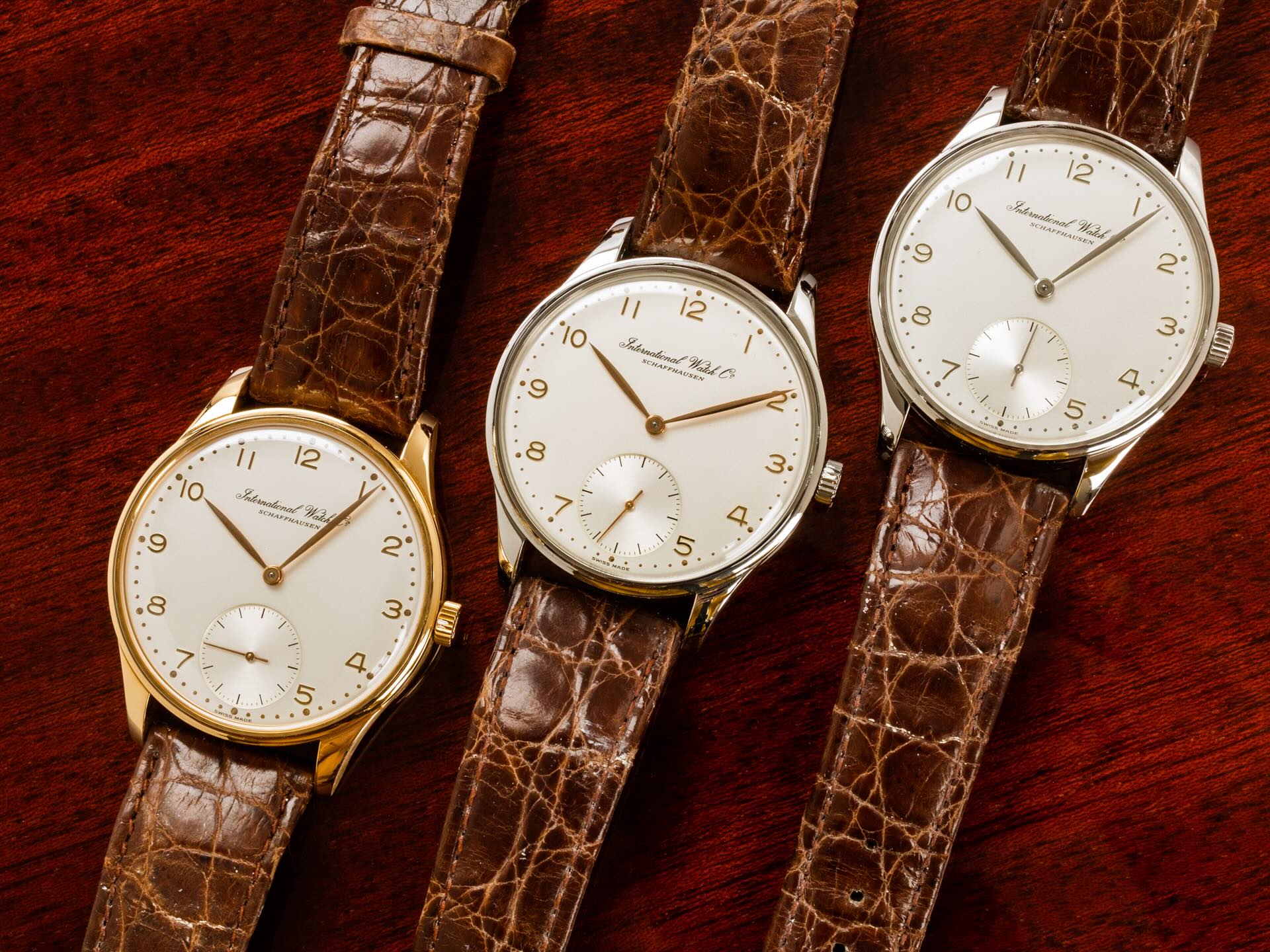

Thus, despite its very modest commercial success, the early Reference 325 laid the groundwork for what would later become the important Portugieser collection. With its oversized case, minimalist dial, and precision-driven movement, it quietly pioneered a design language that would become appreciated and fully blossom in the 1990s. Still, when it did, it became one of the most enduring collections in modern watchmaking.
1993 – Portugieser Minute Repeater Ref. 5240
The time-only Jubilee edition 5441 of 1993 laid the foundation for an entirely new family within IWC, the Portugieser, and arguably helped popularise the trend for larger wristwatches. Building on the technical know-how acquired through the complex Grande Complication Ref. 3770, IWC was ready to push further. That earlier model combined a Valjoux 7750 base with Kurt Klaus’s perpetual calendar module and a minute repeater mechanism developed by Renaud & Papi. The same concept, enhanced with a tourbillon and manual winding, became the ultra-complicated Il Destriero Scafusia (1993), or “The Warhorse of Schaffhausen,” a 125-piece limited edition that cemented IWC’s reputation in high complications.
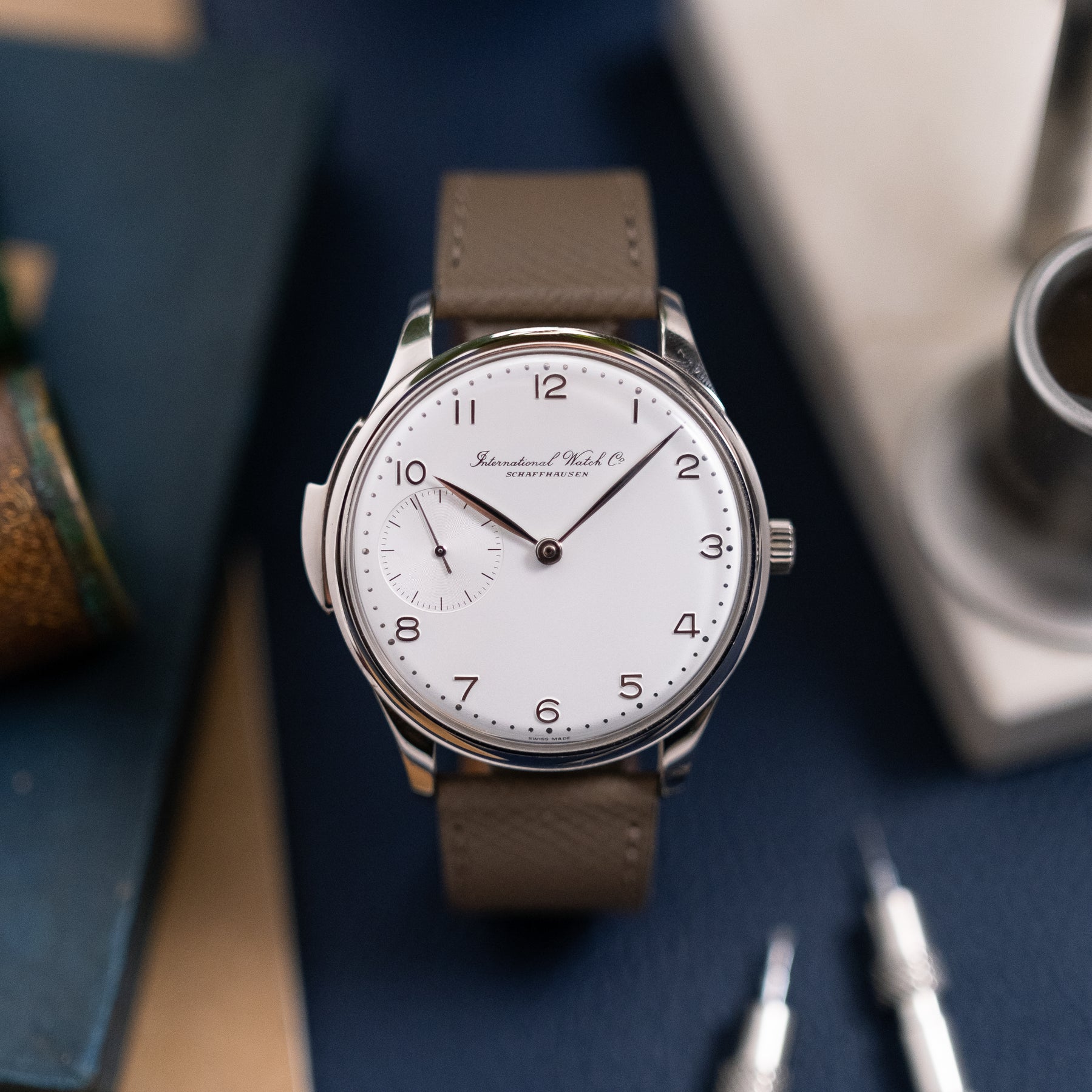

This technical groundwork led directly to the introduction of the Portugieser Minute Repeater Ref. 5240 in 1995, a significant expansion of the Portugieser line that remained true to the refined design language of the Jubilee model. Despite the additional complication, the 43mm case (only 1mm larger than the Jubilee) retained the elegant proportions, slim bezel, narrow caseband, integrated lugs, and signature design elements: logo in English script, Arabic numerals, dotted minutes track, leaf-shaped hands, and small seconds, relocated to 9 o’clock to accommodate the chiming mechanism, revealed only by the discreet repeater slide.
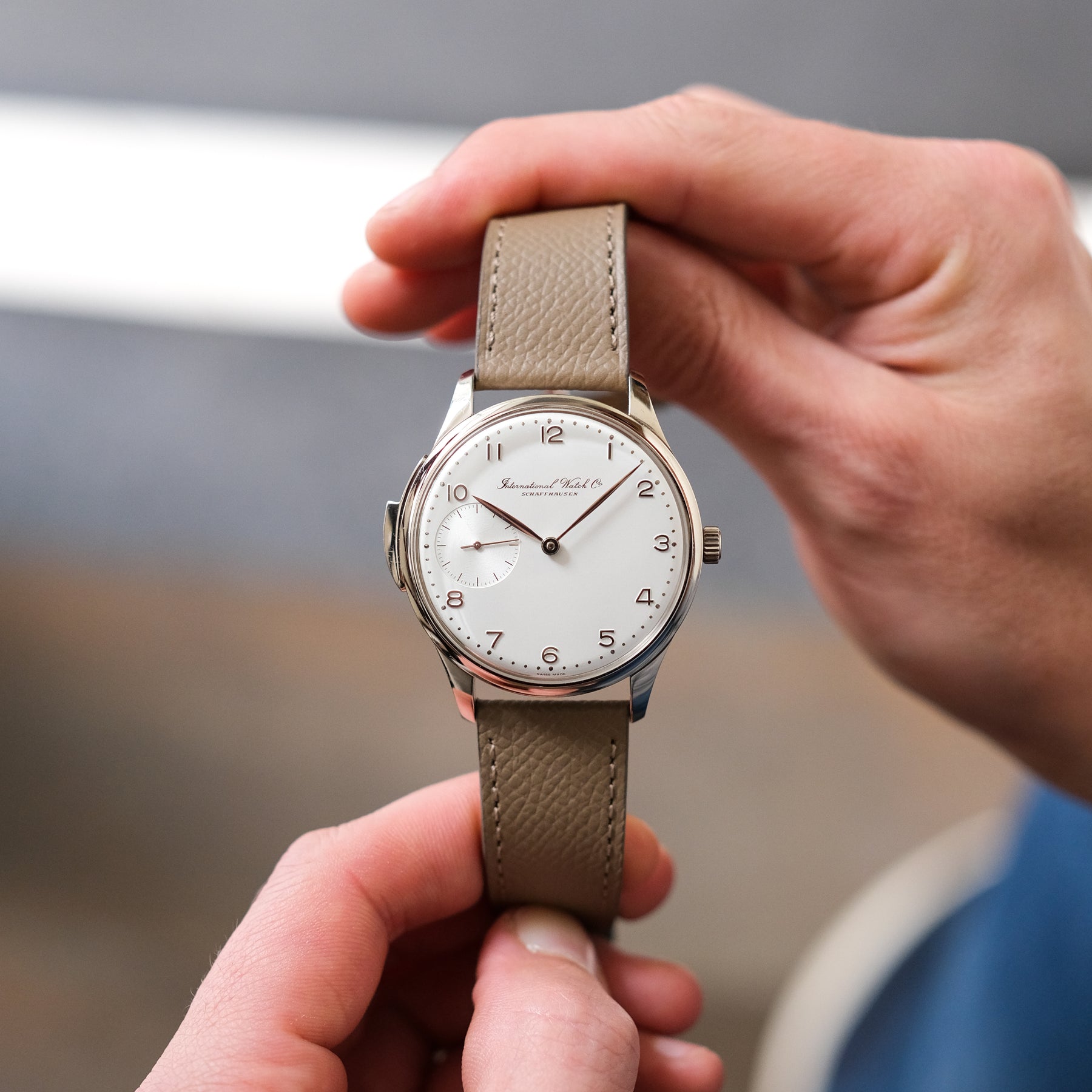

Produced between 1995 and 2005 in a total of 550 pieces (50 in platinum, 250 in rose gold, and 250 in yellow gold), the Minute Repeater featured a Plexiglas front crystal and a sapphire display caseback, a rarity for chiming watches at the time.
Inside was the hand-wound Calibre 95290, based on the classic pocket-watch Cal. 95 architecture. Measuring 37.8mm across and beating at 18,000 vibrations/hour, it was adjusted in five positions, featured a large hacking lever for precise time setting and offered 54 hours of power reserve. A specially developed dial-side chiming module by Renaud & Papi transformed the movement into a repeater. The movement was cleanly and functionally finished, reflecting its roots in robust pocket-watch engineering.
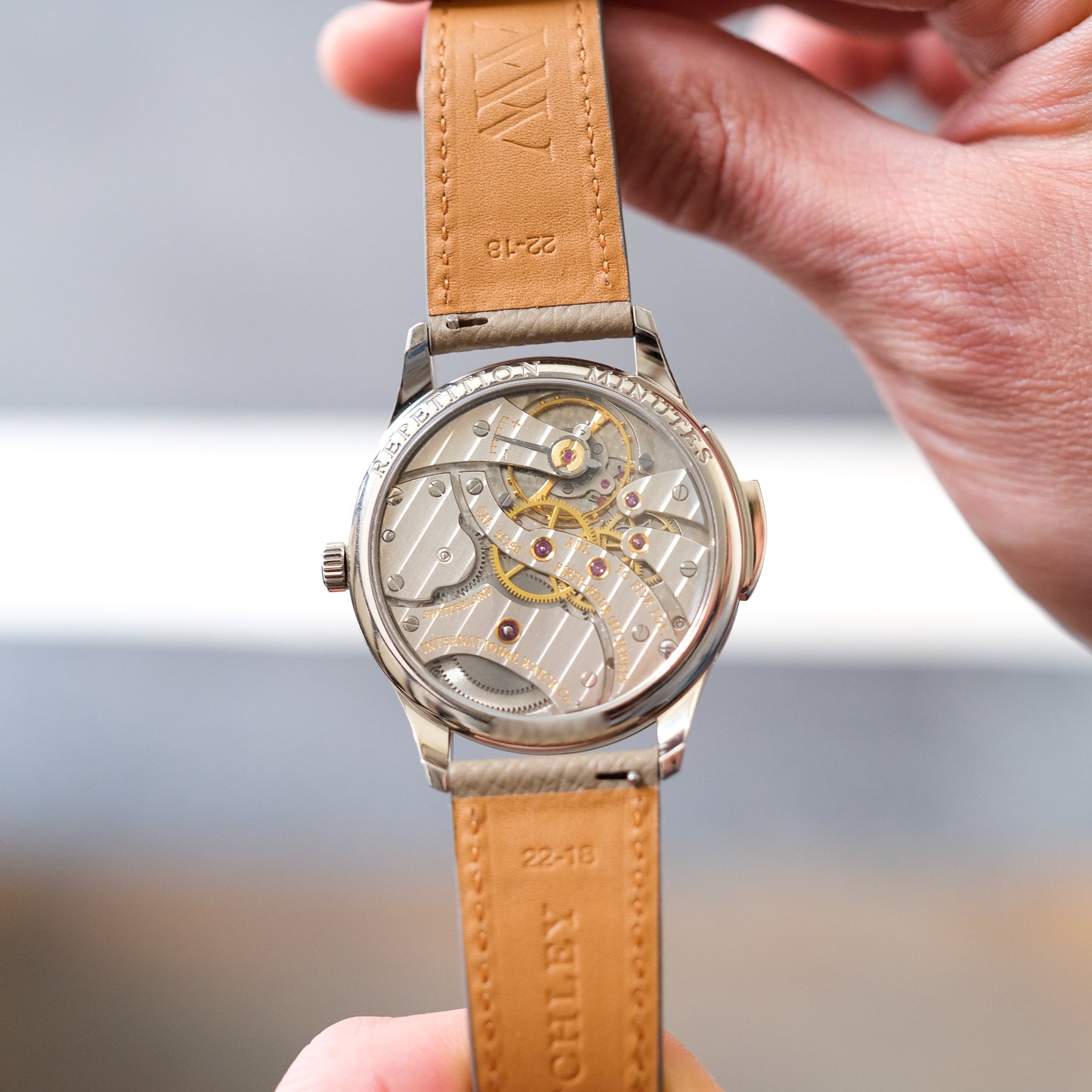

The Ref. 5240 was where the elegance of the Portugieser met the complexity of haute horlogerie, and if it signalled the brand’s renewed technical confidence in the post-quartz era, the Portugieser Chronograph Rattrapante, introduced the same year, cemented it further.
1995 – Portugieser Chronograph Rattrapante Ref. 3712
The IWC Portugieser Chronograph Rattrapante was launched in 1995 as Reference 3712 and was the first to feature the new IWC logo on its dial. Immediately applauded for its look, a rather conservative evolution of the Portugieser, with the same iconic design and great discretion, this watch entered the pantheon of icons mainly for its movement. While the concept of a split-seconds chronograph usually means immense complexity in the development and manufacturing process, here, it is different. The Calibre 76240 was based on a Valjoux 7760 (the hand-wound version of the 7750 and relied on an additional split-seconds module developed by Richard Habring, an employee of the Schaffhausen-based manufacturer at that time. This movement, the Doppelchronograph, made accessible a complication that was usually extremely costly and hard to produce.
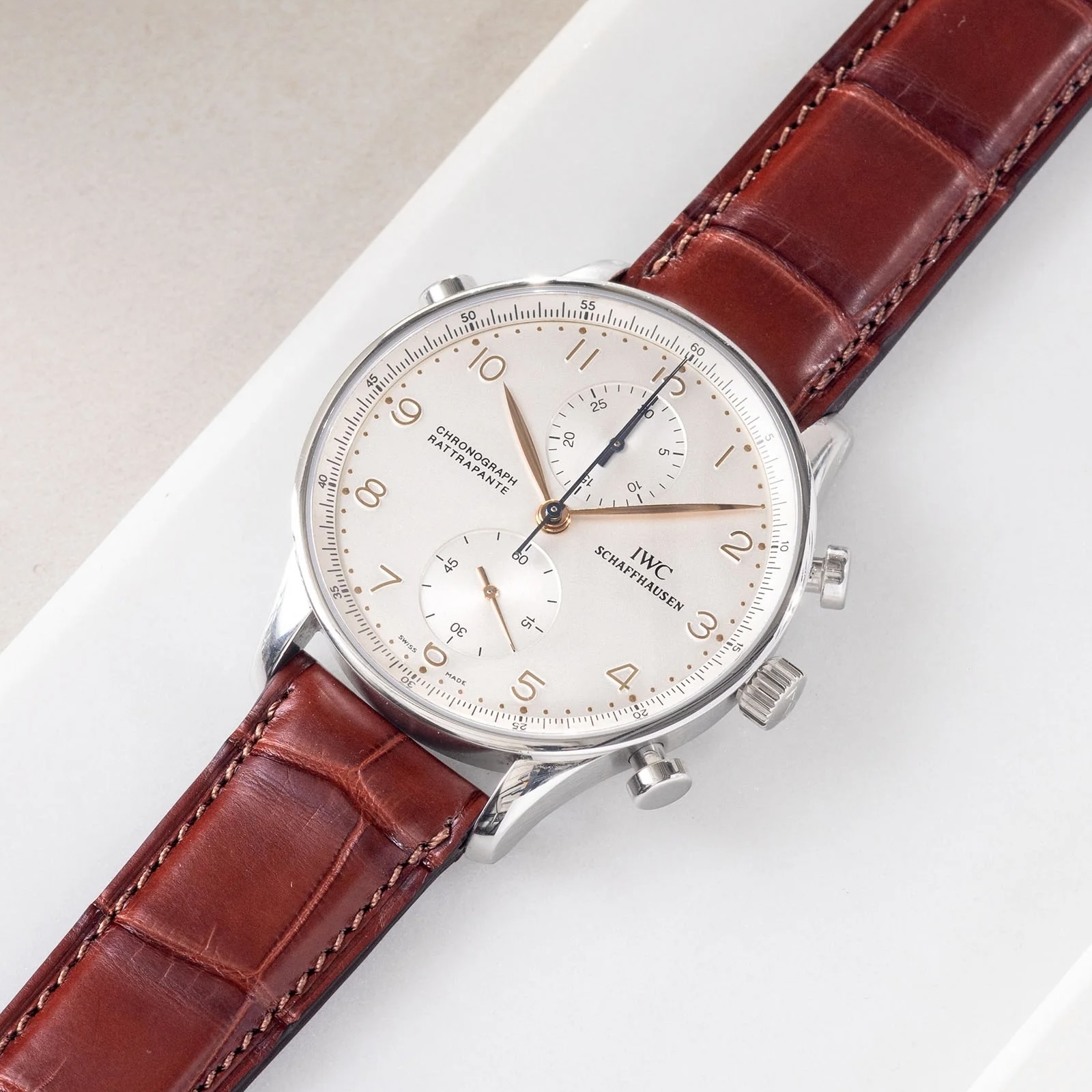

The manual winding Chronograph Rattrapante ref. 3712 was followed by the Automatic Chronograph, Ref. 3714, which, thanks to the perfectly organised dial layout and the sporty elegance of the 40.9 mm case, became the most successful IWC watch ever produced.
1998 – Portugieser Chronograph Ref. 3714
The IWC Portugieser Chronograph Ref. 3714, introduced in 1998, was a foundational model in the brand’s catalogue until 2020, offering a mechanically simplified yet visually faithful continuation of the earlier Ref. 3712 Rattrapante. By removing the split-seconds mechanism to create a more accessible automatic chronograph movement, IWC crafted a watch that balanced technical reliability with timeless aesthetics, contributing to its nearly two-decade production run with minimal changes. It survived the regular updates to the collection (that made quite a few Portugieser references short-lived) and for a good reason.
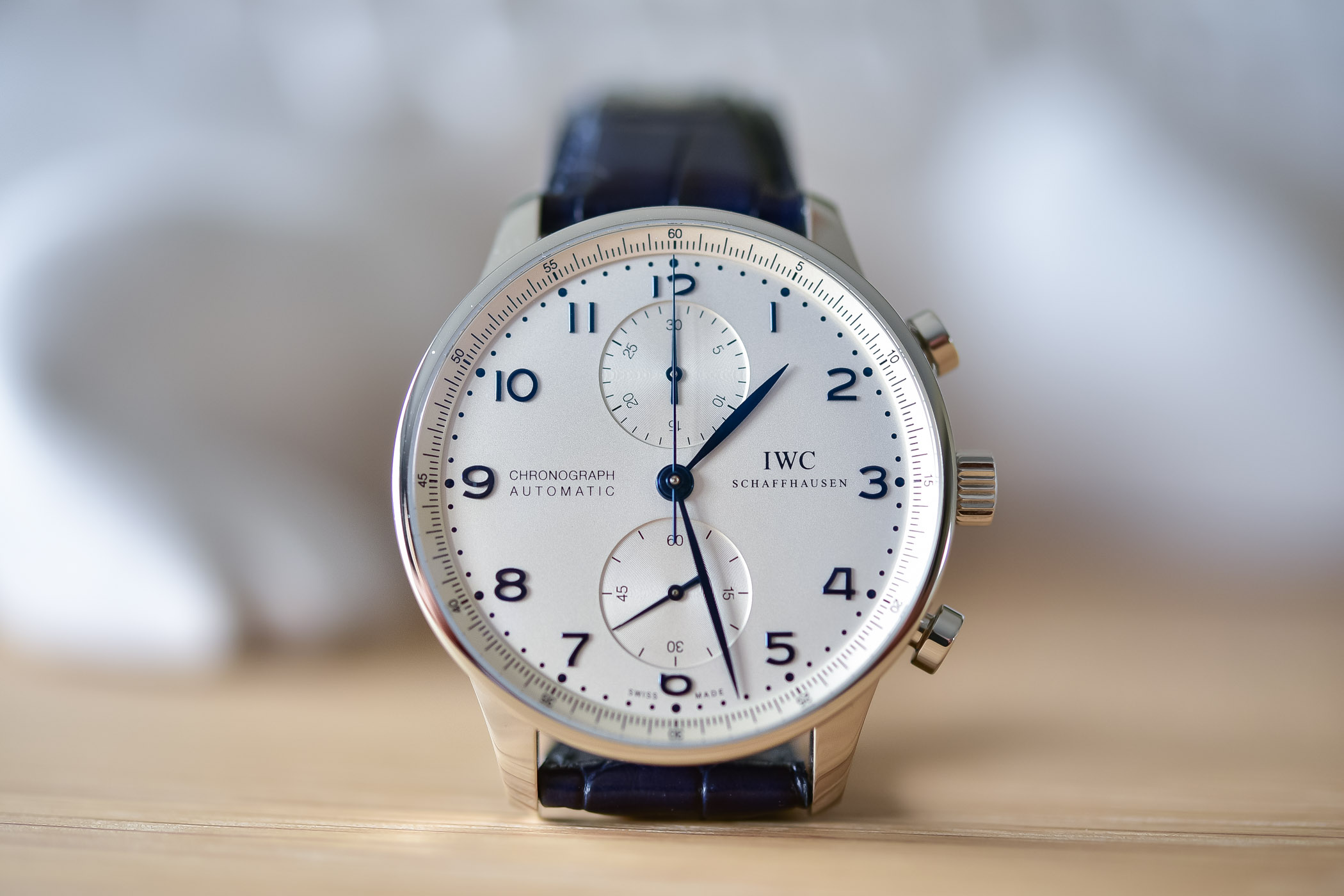

The 3714 came housed in a 40.9mm stainless steel case with a height of 12.6mm and a lug-to-lug span of 47mm. The case construction is straightforward: a central container with integrated lugs, topped by a fixed bezel and a domed, anti-reflective sapphire crystal. The caseback was screwed, and the watch offered a nominal water-resistance of 30m.
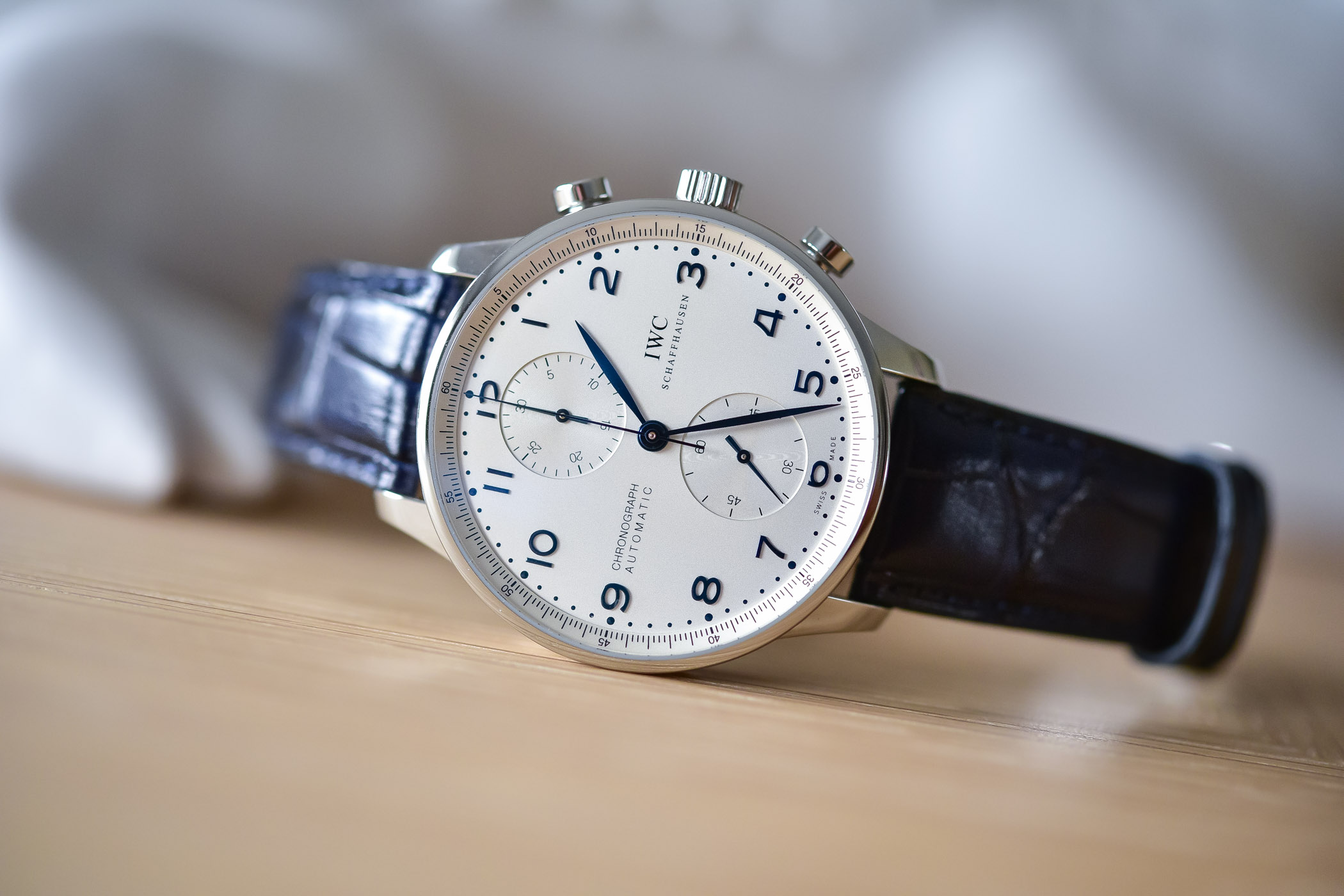

Dial execution remained central to the 3714’s appeal. This reference followed the classic Portugieser formula: applied Arabic numerals, feuille (leaf-shaped) hands, and a clean bicompax layout with recessed sub-dials. The small seconds sat at 6 o’clock, while a 30-minute chronograph register was located at 12 o’clock. Crucially, the absence of a date window maintains visual symmetry.
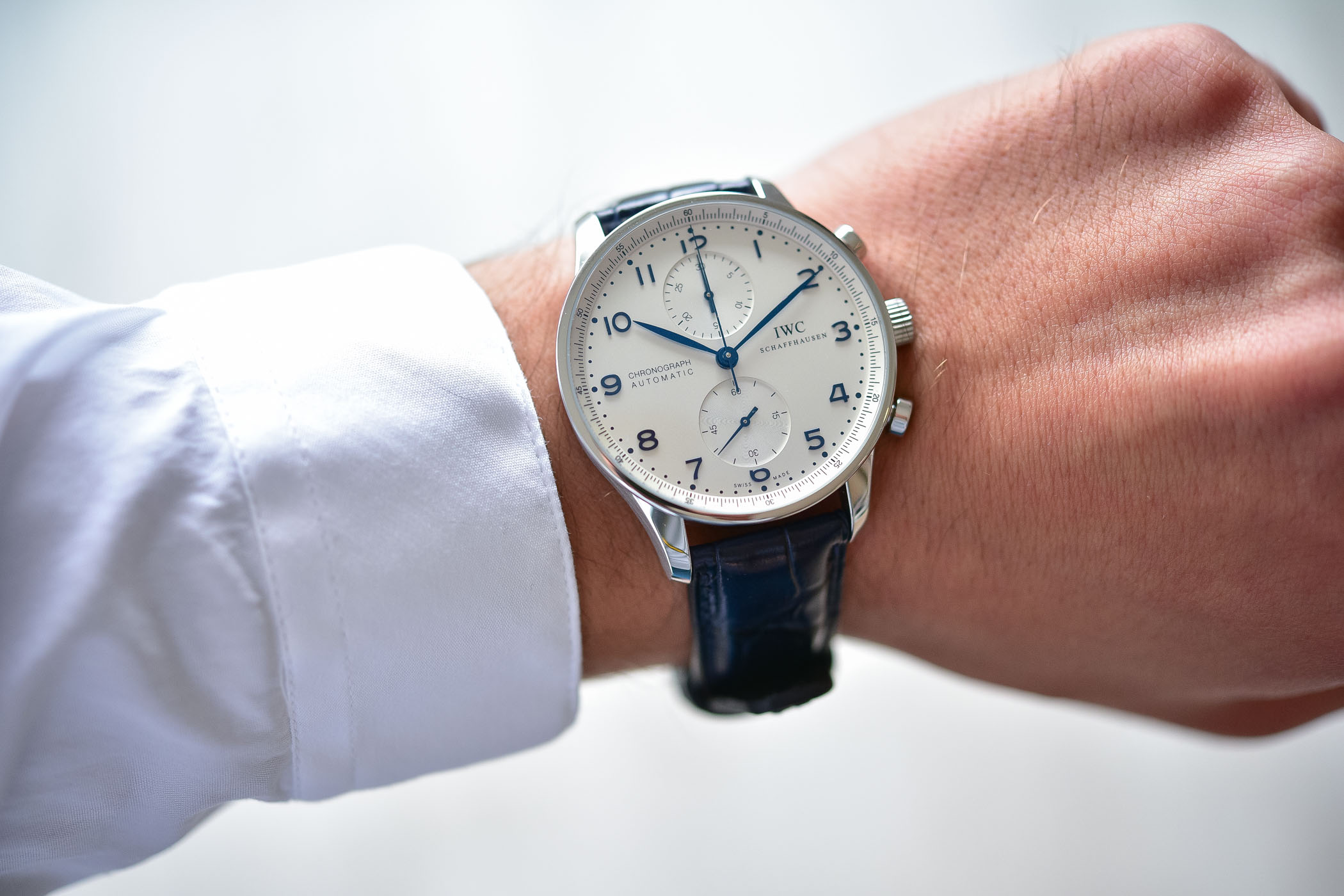

The watch was powered by the IWC Calibre 79350, a reworked version of the Valjoux 7750 base. This movement omitted the 12-hour counter and date function and relocated the small seconds from 9 to 6 o’clock. IWC’s modifications also included upgrades to the escapement components, and the jewel count increased from 25 to 31. Operating at a frequency of 28,800 vibrations/hour, the calibre delivered a 44-hour power reserve. While the movement was decorated with Geneva stripes and perlage, it remained hidden beneath the solid steel caseback.
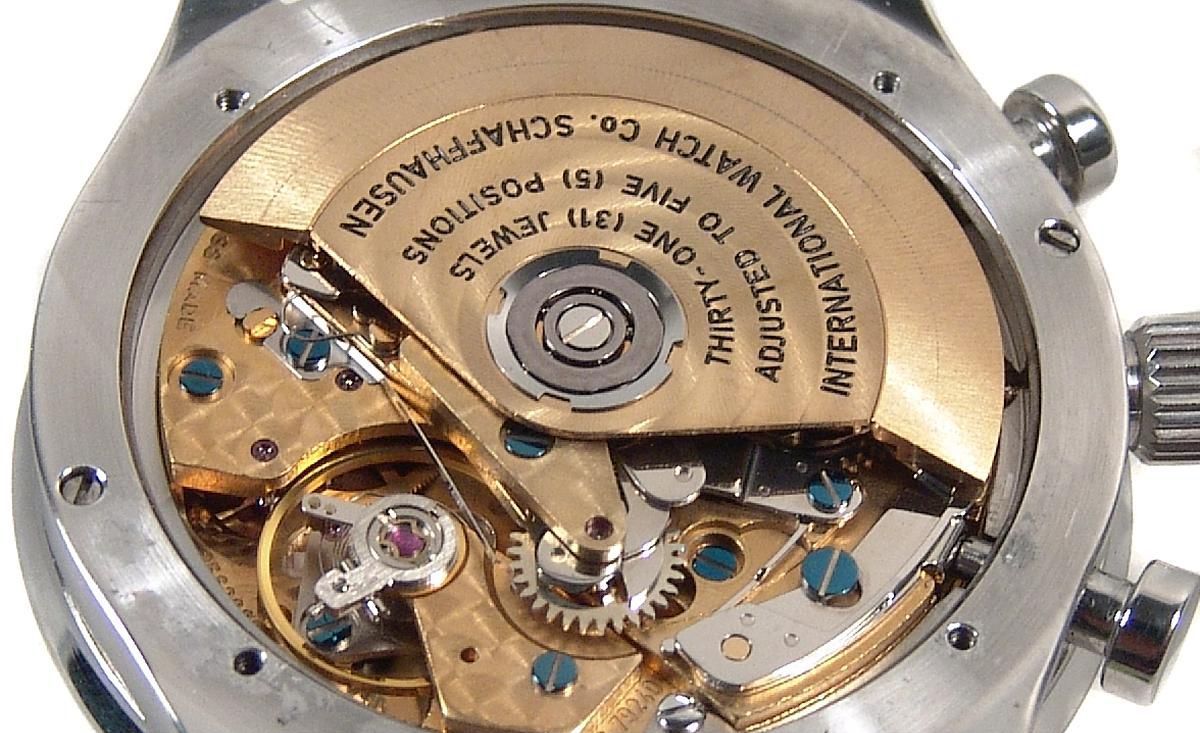

The IWC Portugieser Chronograph Ref. 3714 remains an exceptional watch in the brand’s history, not for groundbreaking complications but for its disciplined execution of core design and chronograph functionality. It represents a highly refined take on a utilitarian complication, wrapped in proportions and aesthetics that have proven enduring, the essential Portugieser.
2000 – Portugieser Automatic Ref. 5000
In 2000, IWC introduced the Portugieser Automatic, marking a significant milestone in the collection’s evolution. Housed in a 42.3mm case, the watch debuted the newly developed in-house Calibre 5000, an impressive automatic movement that signalled the brand’s return to full in-house mechanical watchmaking. Initially released as a 2000-piece limited edition in stainless steel, pink gold, and platinum, the Portugieser Automatic retained the hallmark traits of the collection, such as the case design, a clean, legible dial with Arabic numerals and leaf-shaped hands, but added practical functionality with a pair of horizontal sub-dials: small seconds at 9 o’clock and a power reserve indicator at 3 o’clock. This layout ensured visual balance but also left space for future complications.
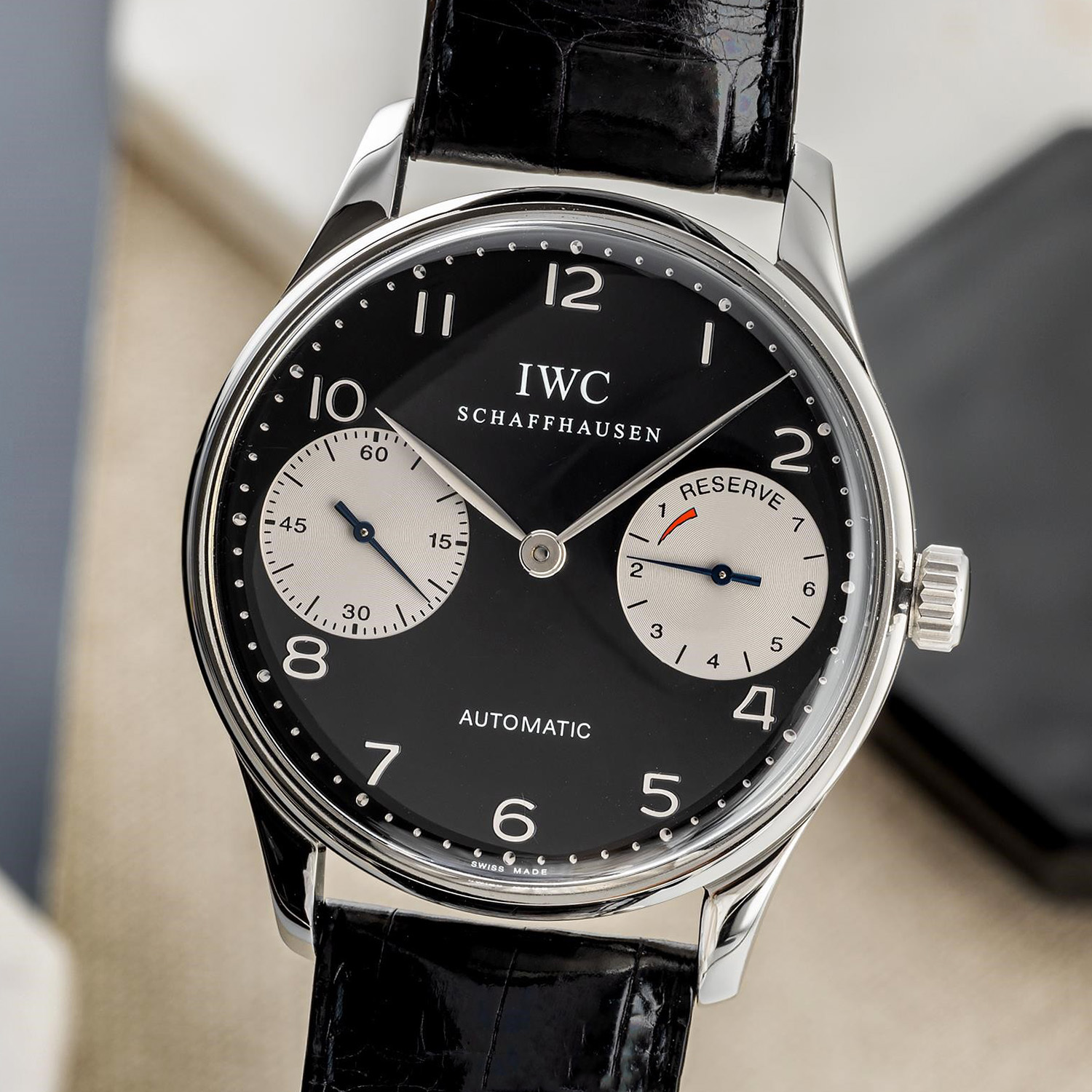

Calibre 5000 was notable for its size and upgrades. At 37.8mm wide and 7.15mm thick, it was purpose-built to fill the large Portugieser case and support a 7-day (8-day, limited to 7) power reserve. The energy came from a massive mainspring barrel, efficiently wound by an upgraded version of IWC’s famed Pellaton system. This modernised mechanism featured dual pawls that engaged in both directions of rotor movement, significantly improving winding efficiency. The calibre also included a large balance wheel, ticking at a traditional 18,000 vibrations per hour, and paired with a unique dual-regulation system. Fine adjustments could be made via both balance screws and a conventional index regulator.
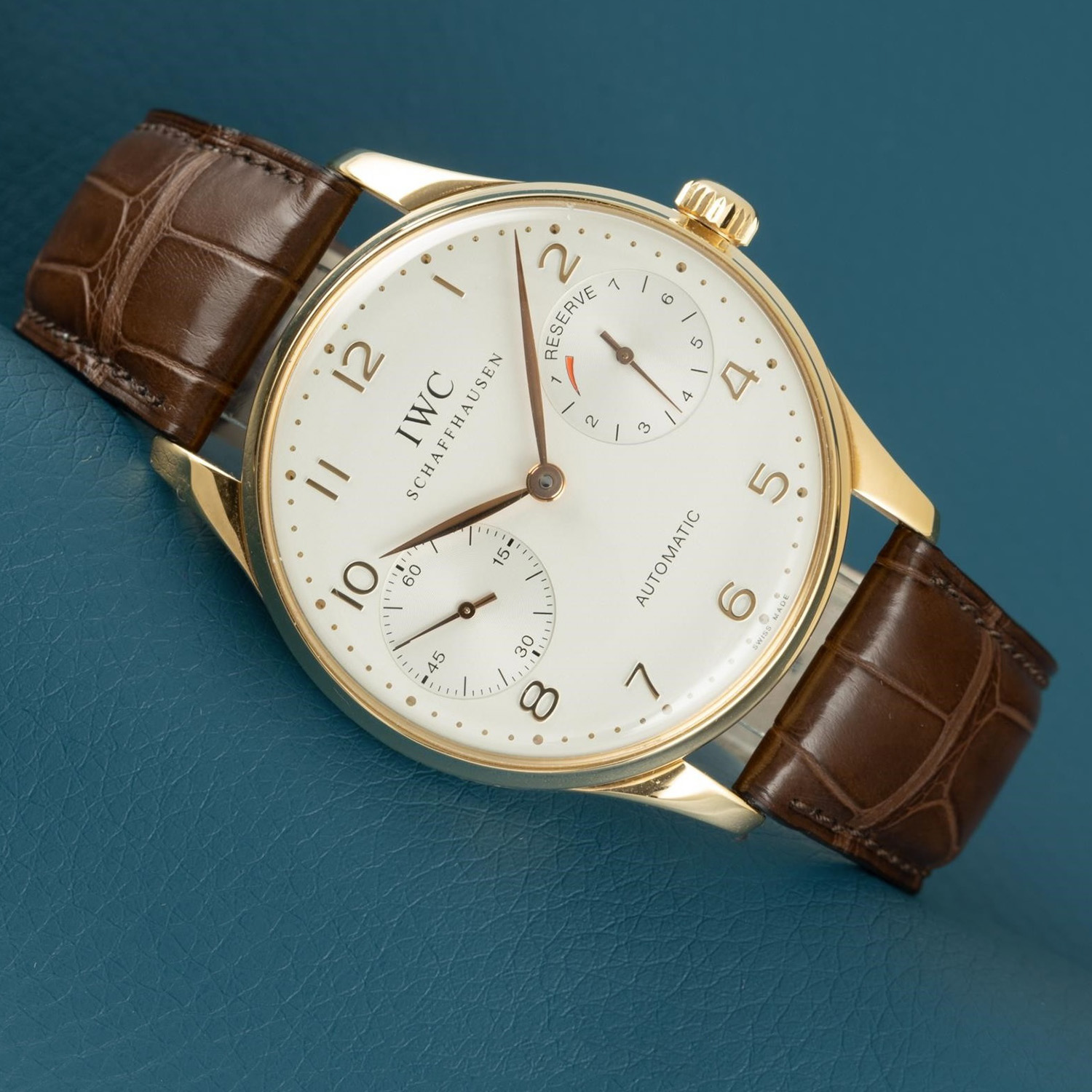

Image by Zeitauktion
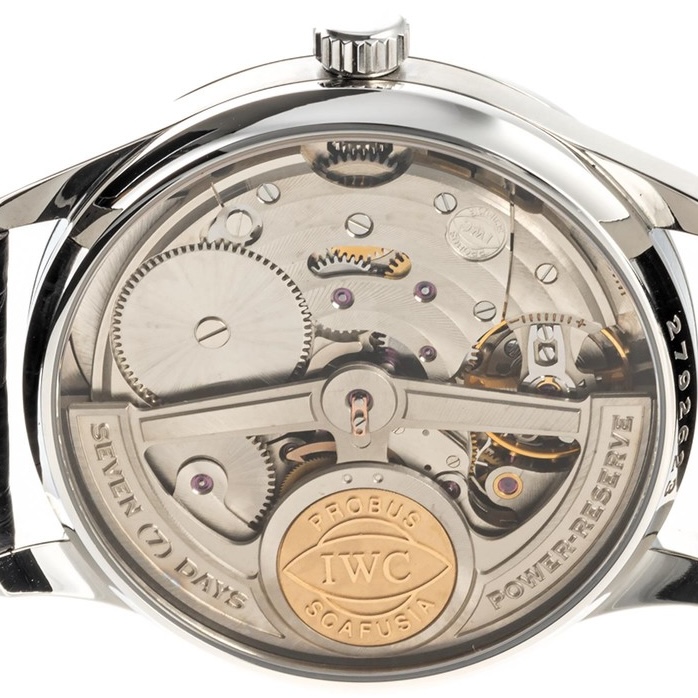

Image by Zeitauktion
Over the years, the movement continued to evolve. In 2004, it became Calibre 50010, and by 2005, it was updated to Calibre 51010 with a faster 21,600 vibrations/hour beat rate. In 2007, the Calibre 51011 was introduced, bringing further refinements. Eventually, the architecture gave rise to the 52000 series with twin barrels for more consistent torque delivery over the full 7-day reserve.
2003 – The Portugieser Perpetual Calendar Ref. 5021/5032
The IWC Portugieser Perpetual Calendar, introduced in 2003, made the Portugieser version iconic. It successfully merged mechanical innovation with classical design, making it a technical and aesthetic benchmark within the collection. It retained the original spirit of the Portugieser, a wristwatch born of pocket-watch proportions and legibility, while introducing one of horology’s most revered complications in a clean, timeless execution.
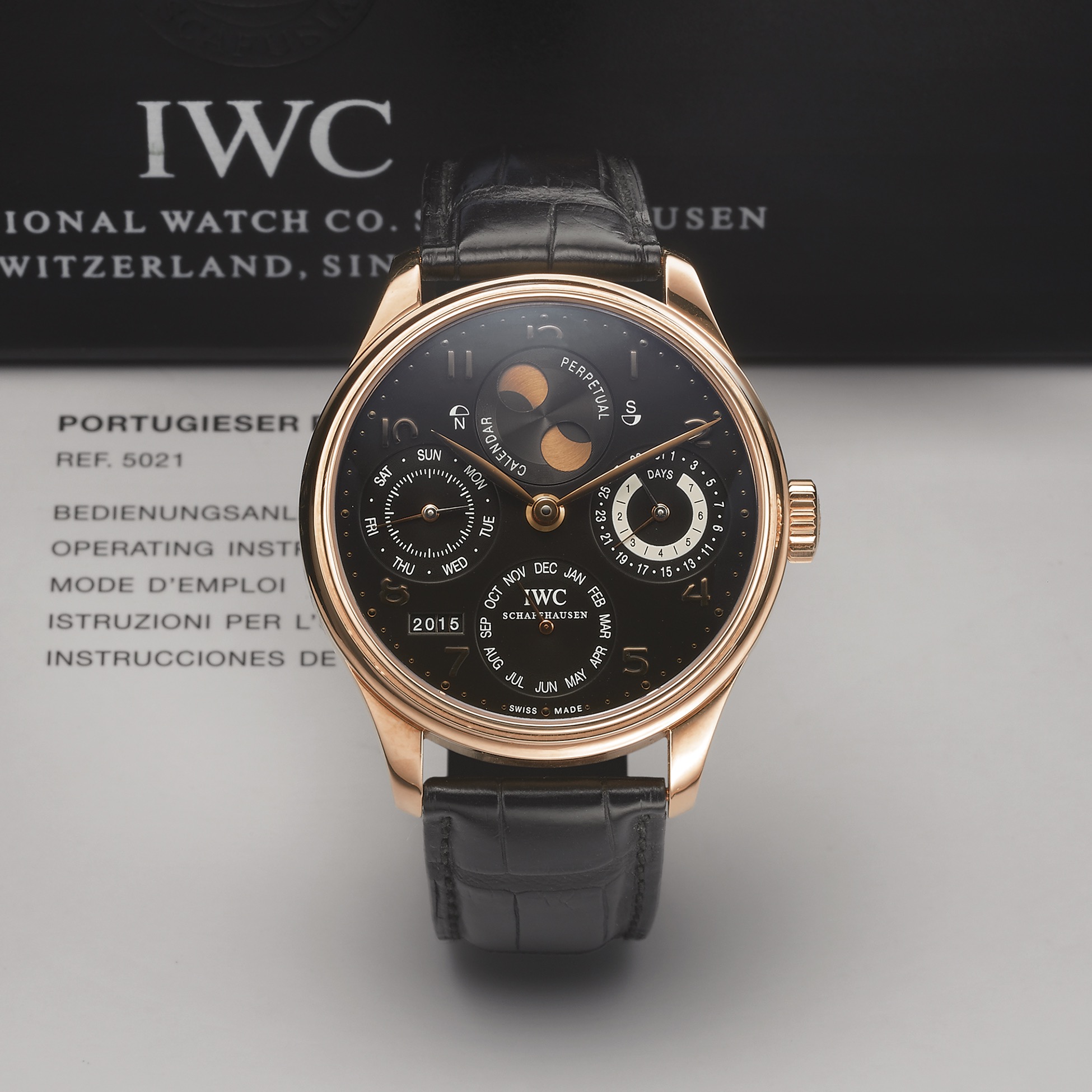

While IWC first introduced the perpetual calendar in the groundbreaking 1985 Da Vinci Ref. 3750, the 2003 Portugieser version refined the concept. It brought it into the brand’s most elegant and historically significant collection. The leap from the baroque Da Vinci case to the clean lines of the Portugieser resulted in one of IWC’s most enduring and technically impressive watches.
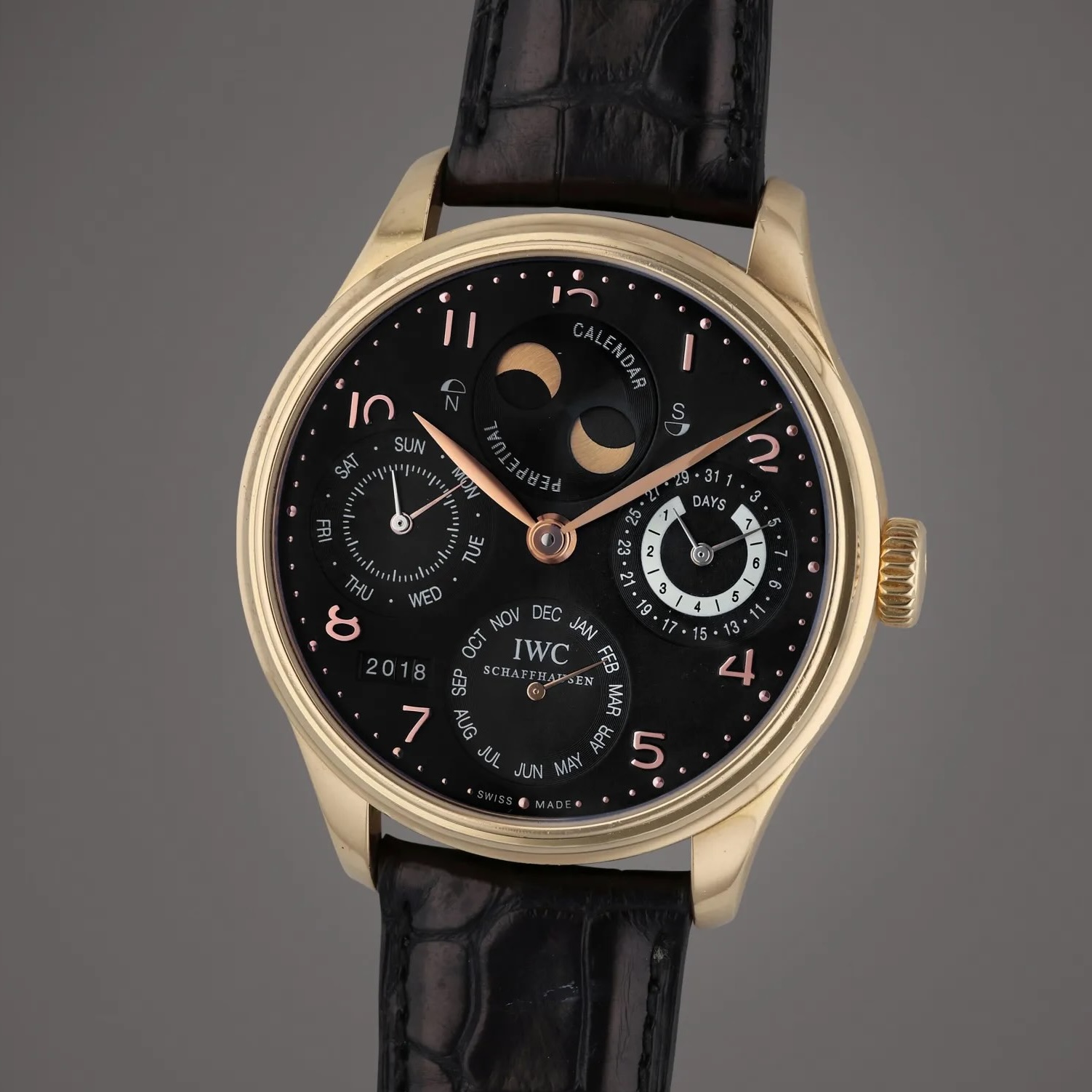

The foundation for the modern IWC perpetual calendar was laid by master watchmaker Kurt Klaus during the height of the quartz crisis. Klaus developed an ingenious perpetual calendar mechanism in the early 1980s, a system with all indications (day, date, month, year, and moon phase) adjustable via the crown alone. The module required no additional pushers and was mechanically programmed for 577 years. Initially mounted on a chronograph movement for the Da Vinci, this module was later adapted to fit IWC’s proprietary 7-day automatic calibre for the Portugieser, enhancing performance and power reserve.
The Portugieser Perpetual Calendar of 2003 debuted in a 42.3mm case with classic proportions, crafted in precious rose gold or platinum, with IWC’s signature thin bezel and expansive dial opening that amplified legibility – a cornerstone of the Portugieser line.
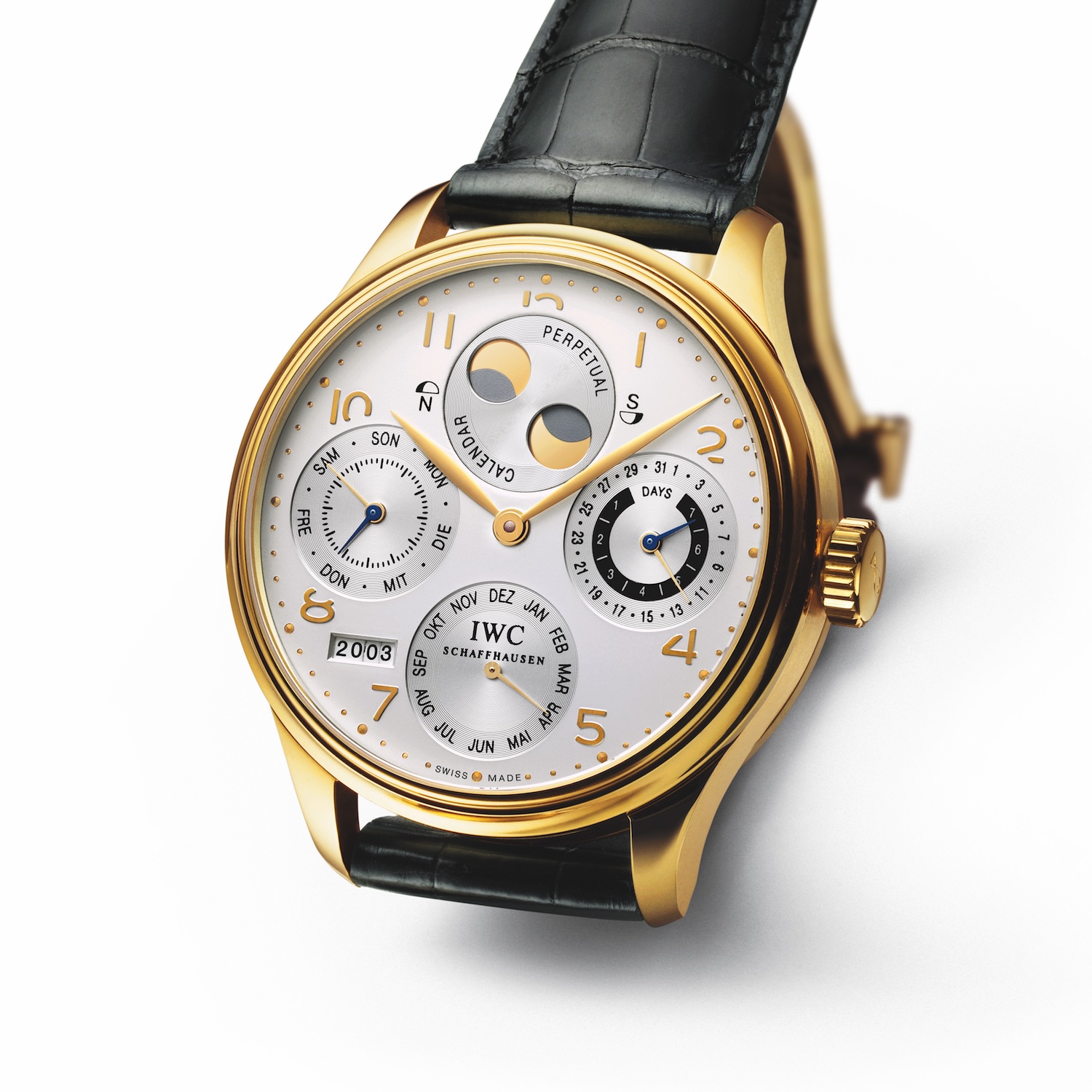

The dial layout was equally elegant and functional. Four symmetrically arranged sub-dials presented the complete calendar information: the day at 9 o’clock, the date and power reserve at 3, the month at 6, and the moon phase at 12. Notably, the moon phase display in the Portugieser version was upgraded to deliver extraordinary accuracy, deviating by just one day in 577.5 years – a significant improvement over the already impressive 122-year moon phase of the Da Vinci – and included a moon for the second hemisphere, with both moons correctly oriented. The perpetual calendar was programmed to run without intervention until 2499, indicating the current year in the dial aperture at 7 o’clock, in digital format.
Inside the watch was the IWC calibre with a 5000-series base, Cal. 50611. For the new dimensions of the case and movement, Kurt Klaus rebuilt his module by adding a few additional wheels, including an intermediate wheel with a larger number of teeth, to enable a more precise moon phase display. Cal. 50611 was updated in 2005 with a faster operating frequency of 21,600 vibrations per hour to become Cal. 51612, further updated in 2007 as Cal. 51614. Also, Cal. 51610 was introduced in 2006 with a single moon phase indicator, updated to Cal. 51613 in 2007.
2004 – Portugieser Tourbillion Mystère Ref. 5042 and Minute Repeater Squelette Ref. 5241
In the year following the introduction of the Portugieser Perpetual Calendar, IWC unveiled two standout models, one of which was the Portugieser Tourbillon Mystère Ref. 5042. Drawing on IWC’s expertise from the Il Destriero Scafusia of 1993, the watch incorporated a refined flying tourbillon escapement with a lightweight titanium cage, an advanced construction developed in-house during the 1990s. It was integrated into the large Calibre 50900, an automatic movement featuring IWC’s Pellaton winding system, a Breguet overcoil hairspring, and a 7-day power reserve.
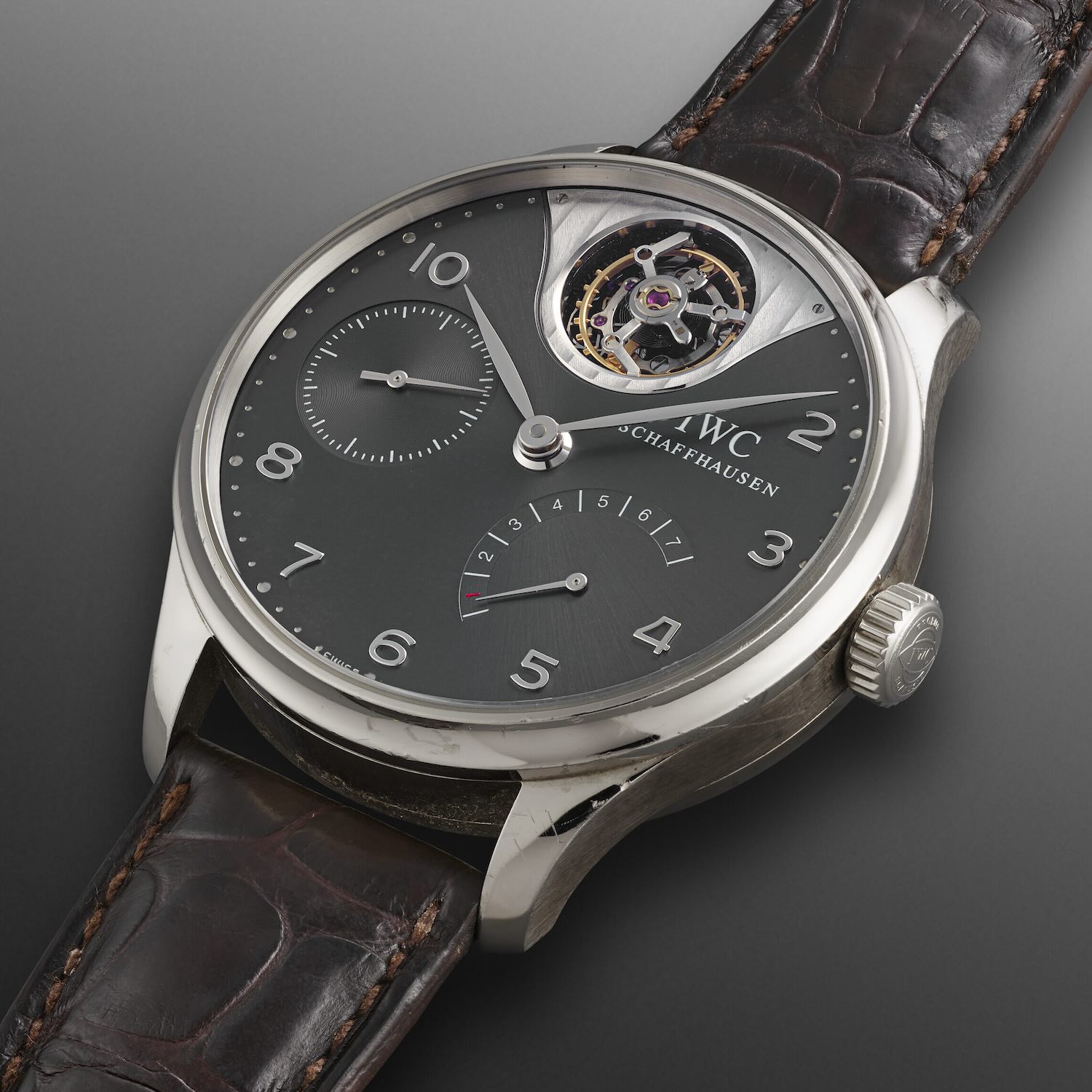

While the tourbillon introduced visual drama and horological prestige, the movement also delivered practical utility with a power reserve display and small seconds at 9 o’clock. Encased in a 44.2mm case made in platinum (50 pieces) or red and white gold (250 pieces each), the watch retained the signature aesthetics of the Portugieser line: clean dials in silver or slate grey, applied Arabic numerals, and elegant feuille hands.
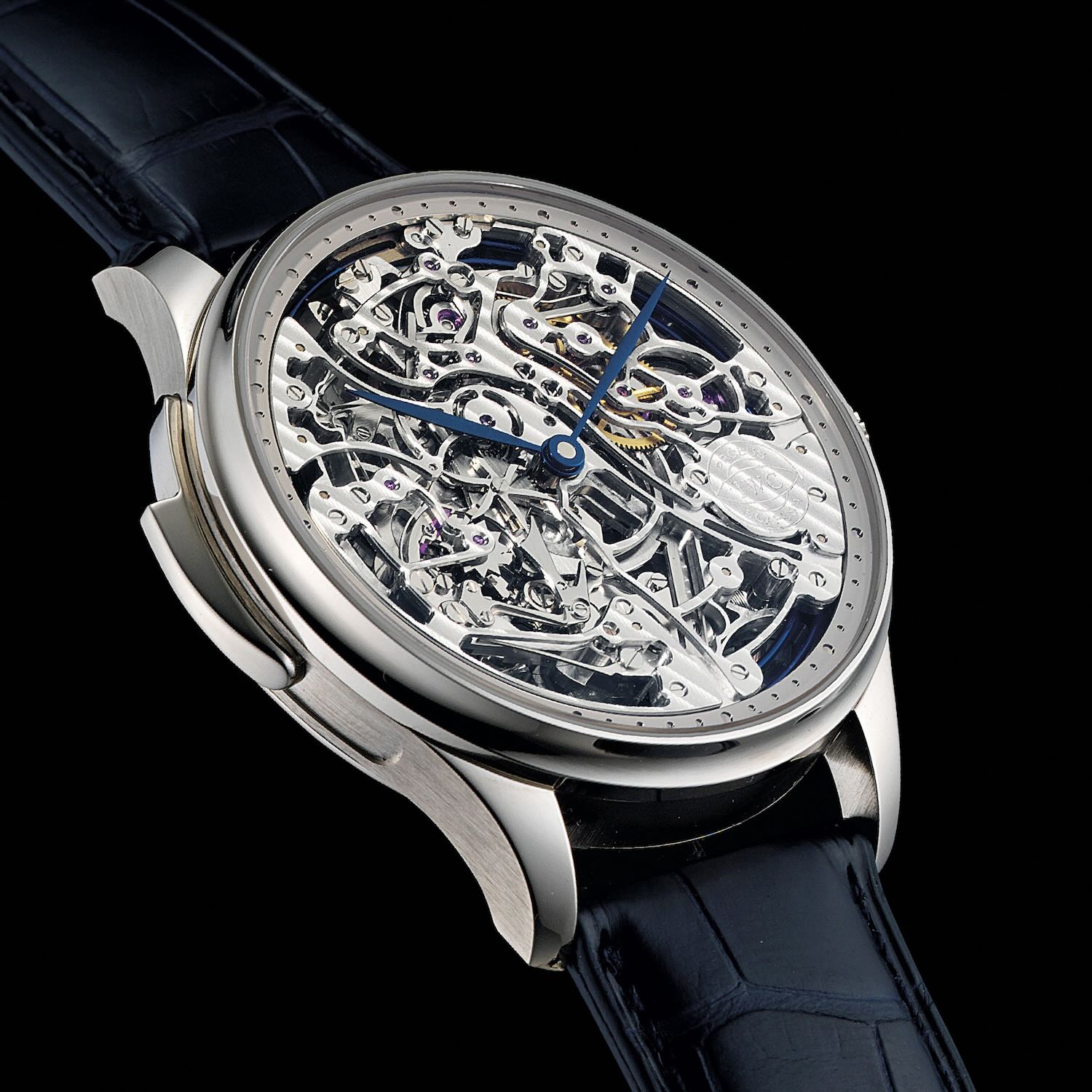

The IWC Portugieser Minute Repeater Squelette 5241 came as a rare and highly refined expression of mechanical artistry within the Portugieser collection. Limited to 50 pieces each in red and white gold and measuring 42mm diameter x 12.3mm thick, this watch showcased a skeletonised interpretation of the hand-wound minute repeater Calibre 95911 (operating at 18,000 vibrations/hour, with a 43-hour power reserve, composed of 250 parts), offering a clear view of its intricate architecture through a dramatically openworked design. The dial was reduced to a narrow peripheral ring, while the bridges and components of the repeater mechanism were exposed and minimised to their essential structure.
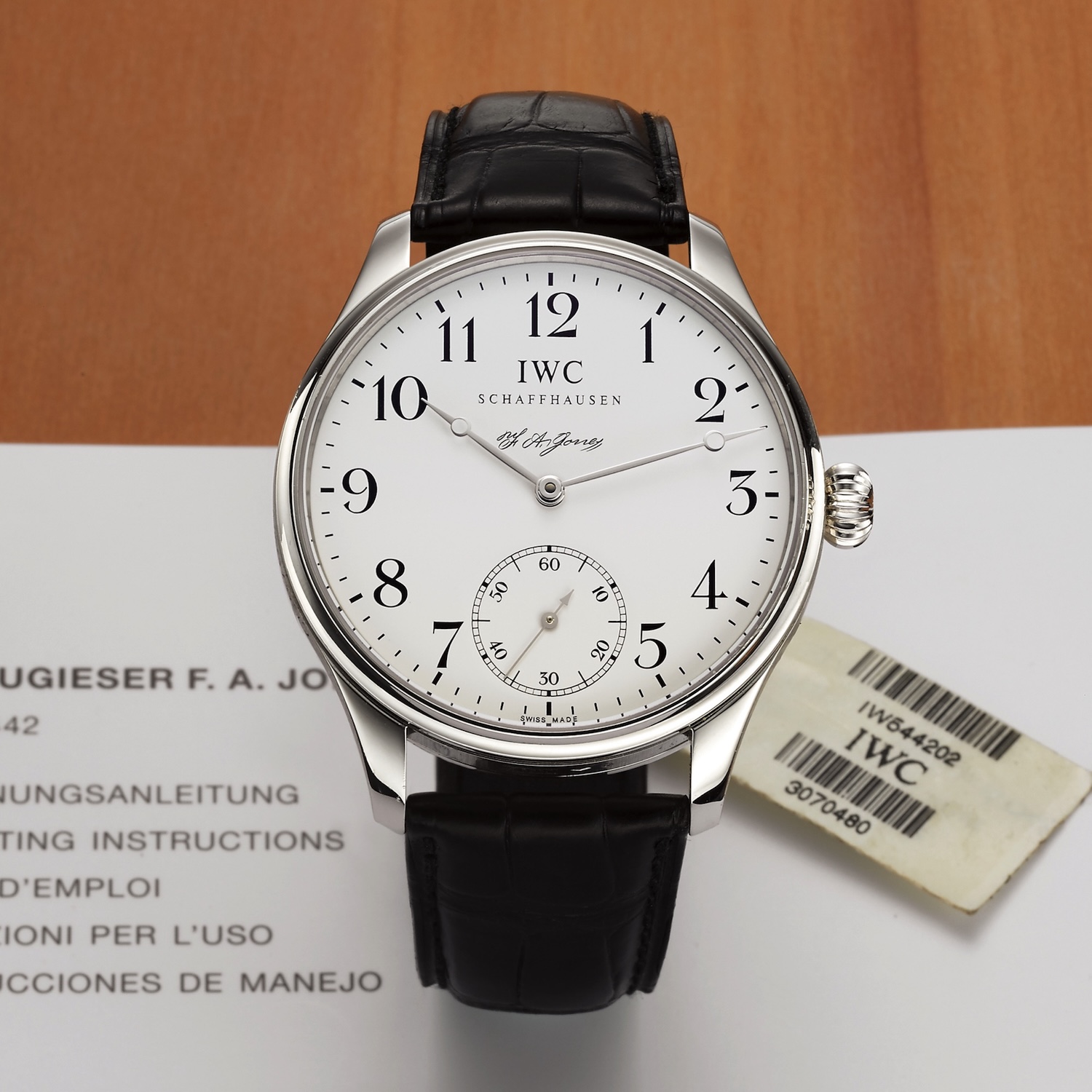

Before moving on, let’s mention in this limited editions context a 2005 Portugieser F.A. Jones Edition (Ref. 5442) released in a 43mm case featuring an onion-style crown, with 3,000 pieces in steel, 1,000 in gold, and 500 pieces in platinum, powered by the Cal. 98290. Displaying time only, the Portugieser F. A. Jones Edition charmingly rendered the dial with Breguet hands, outsize numerals, and a copy of F. A. Jones signature.
2005 – Portugieser Régulateur Ref. 5444
In the mid-2000s, IWC expanded its celebrated Portugieser line with a striking interpretation of classic horology: the Portugieser Régulateur. The watch separated the hour, minute, and second displays into distinct registers. At the heart of the Régulateur was the IWC-manufactured Calibre 98245, a hand-wound movement derived from the historic Calibre 98. Cal. 98245 featured a three-quarter plate made of nickel silver. Beating at 18,000 vibrations/hour and providing a 46-hour power reserve, the movement offered traditional architecture and excellent timekeeping performance. A Jones-style elongated adjustment index further elevated its technical finesse. The movement was visible through a sapphire caseback, showcasing traditional decoration.
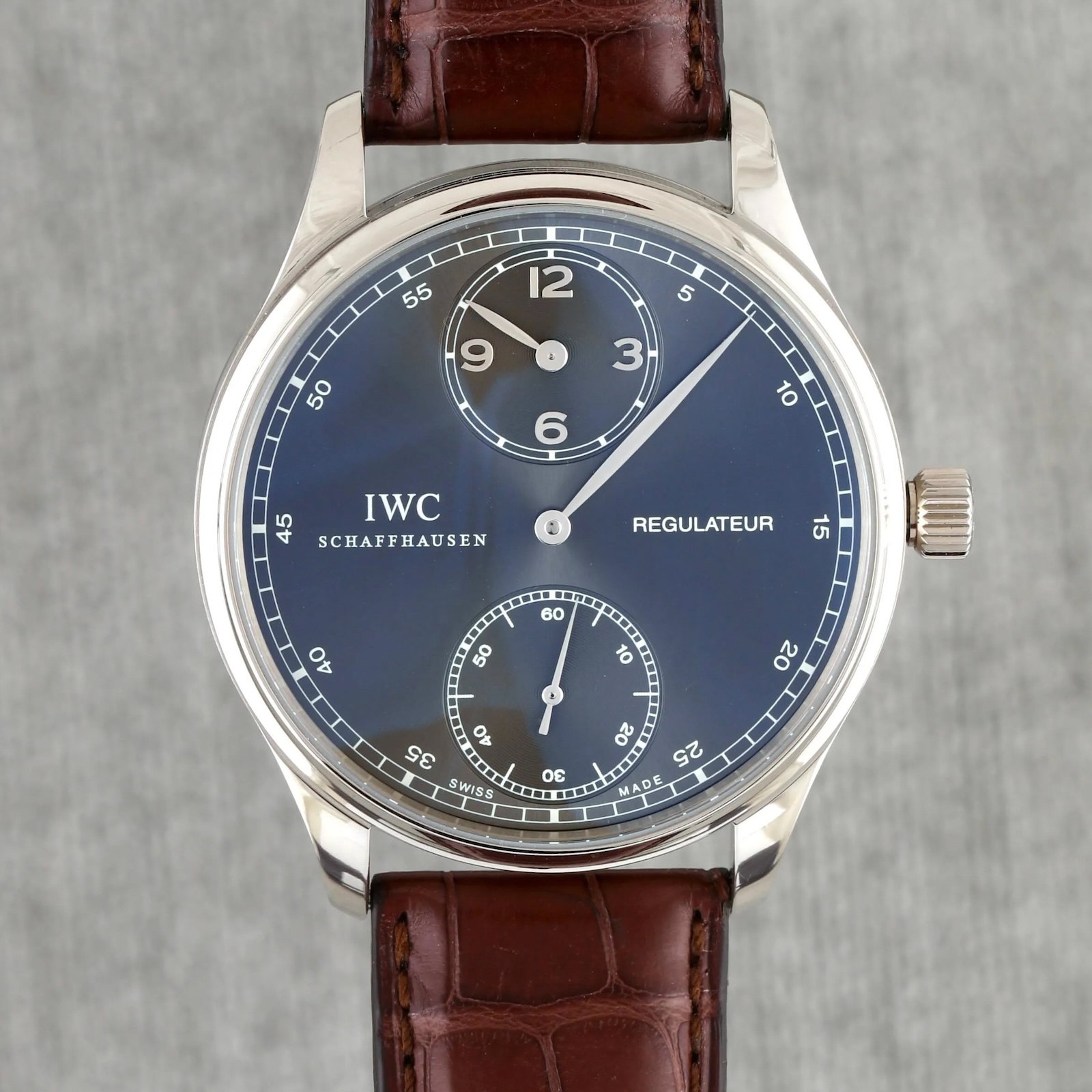

Housed in a 43.1mm case with a height of 11.8mm, the Portugieser Régulateur was offered in stainless steel, rose gold, white gold, or platinum. The dial, available in silver or anthracite depending on the version, was home to blued or gold hands and featured a vertical layout: minutes displayed centrally, hours at 12 o’clock, and small seconds at 6.
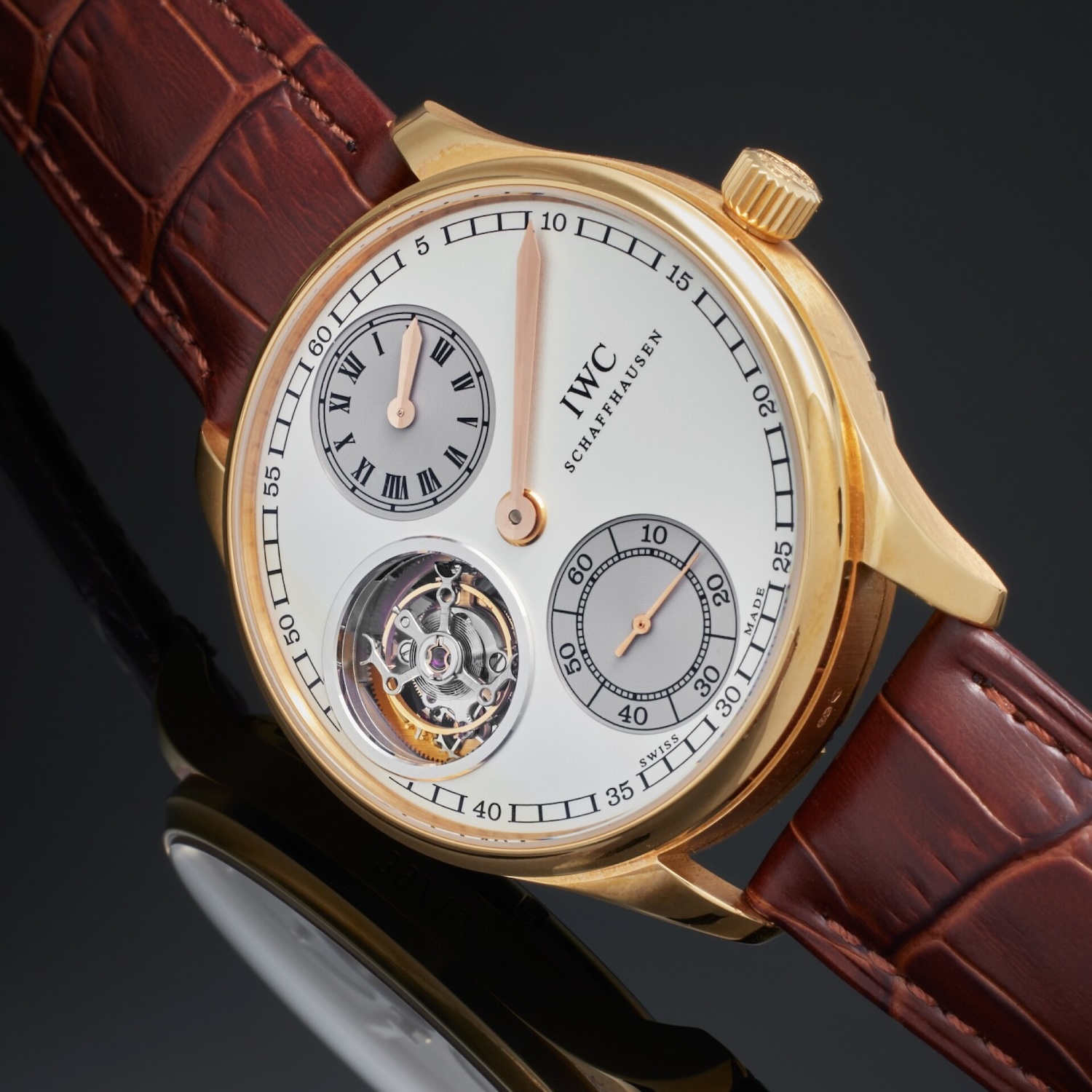

In 2007, IWC introduced the limited-edition Portugieser Régulateur Tourbillon in a 43.1mm case made of platinum, white gold, or rose gold. It was powered by the hand-wound Calibre 98845, an elaborately finished movement derived from the brand’s historic pocket watch calibres, but upgraded to beat at a higher frequency of 28,800 vibrations per hour, making it one of the fastest in this lineage. The flying tourbillon was prominently displayed through an aperture at 9 o’clock, creating a visually balanced layout alongside the separate hour and seconds displays typical of a regulator dial.
2008 – Portugieser Hand-Wound Vintage Collection Ref. 5445
In 2008, IWC paid tribute to its earliest Portugieser models with the release of the Portugieser Hand-Wound from the Vintage Collection, a faithful reinterpretation of the 1939 original, updated with modern mechanical precision. Visually, the watch echoed the classic design language that defined the Portugieser line: a clean silver dial with Arabic numerals, a traditional railway track chapter ring, and a domed sapphire crystal with anti-reflective coating on both sides, subtly modernising the historical look.
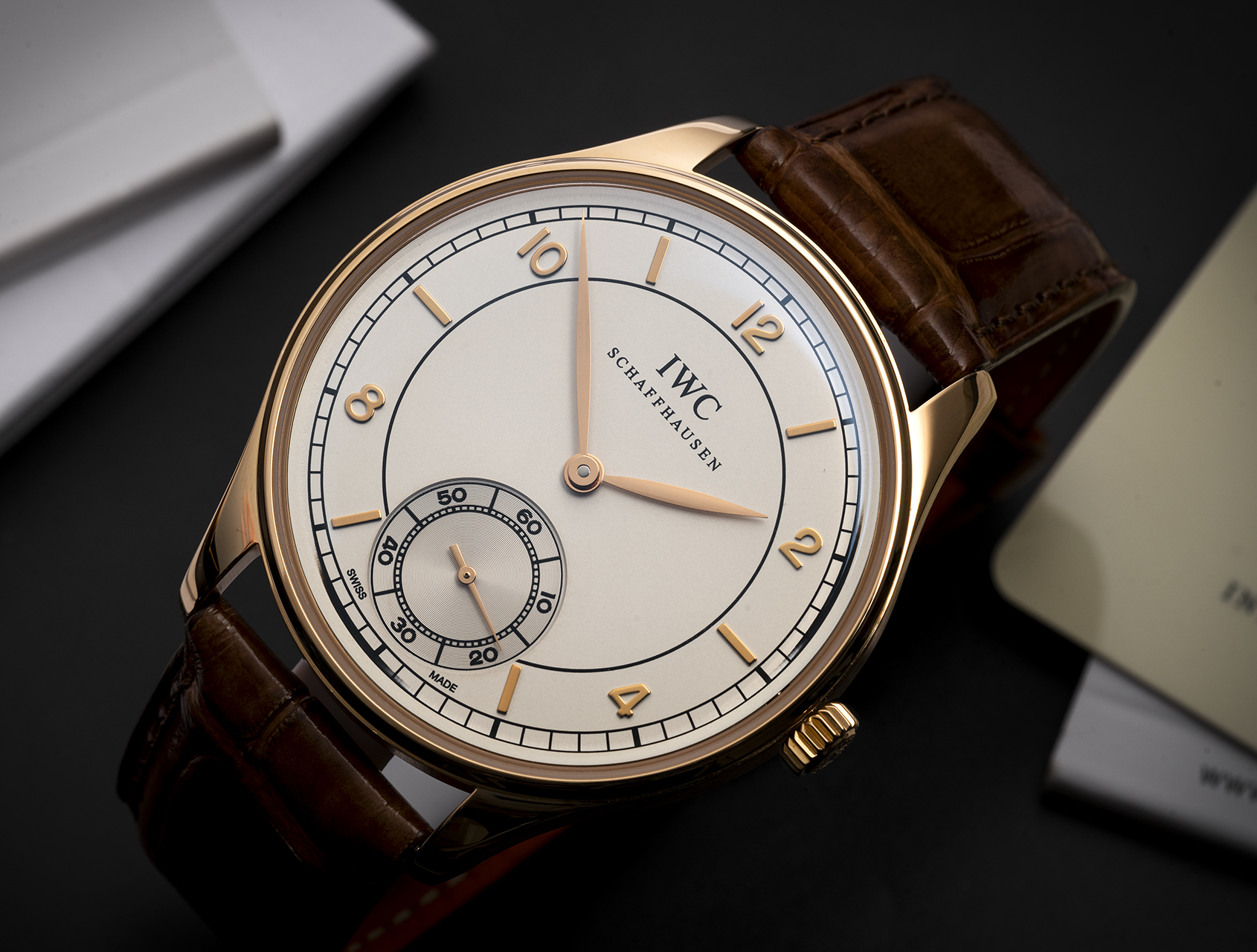

Beneath the vintage-inspired exterior lay the hand-wound Calibre 98295, a movement directly descended from IWC’s historic pocket watch Calibre 98. Evolved over seven decades, this updated version featured a large Glucydur balance with weight-compensation screws, a Breguet hairspring, and a Jones-style elongated fine adjustment index. Beating at 18,000 vibrations per hour, the movement delivered a 46-hour power reserve and was visible via the sapphire caseback.
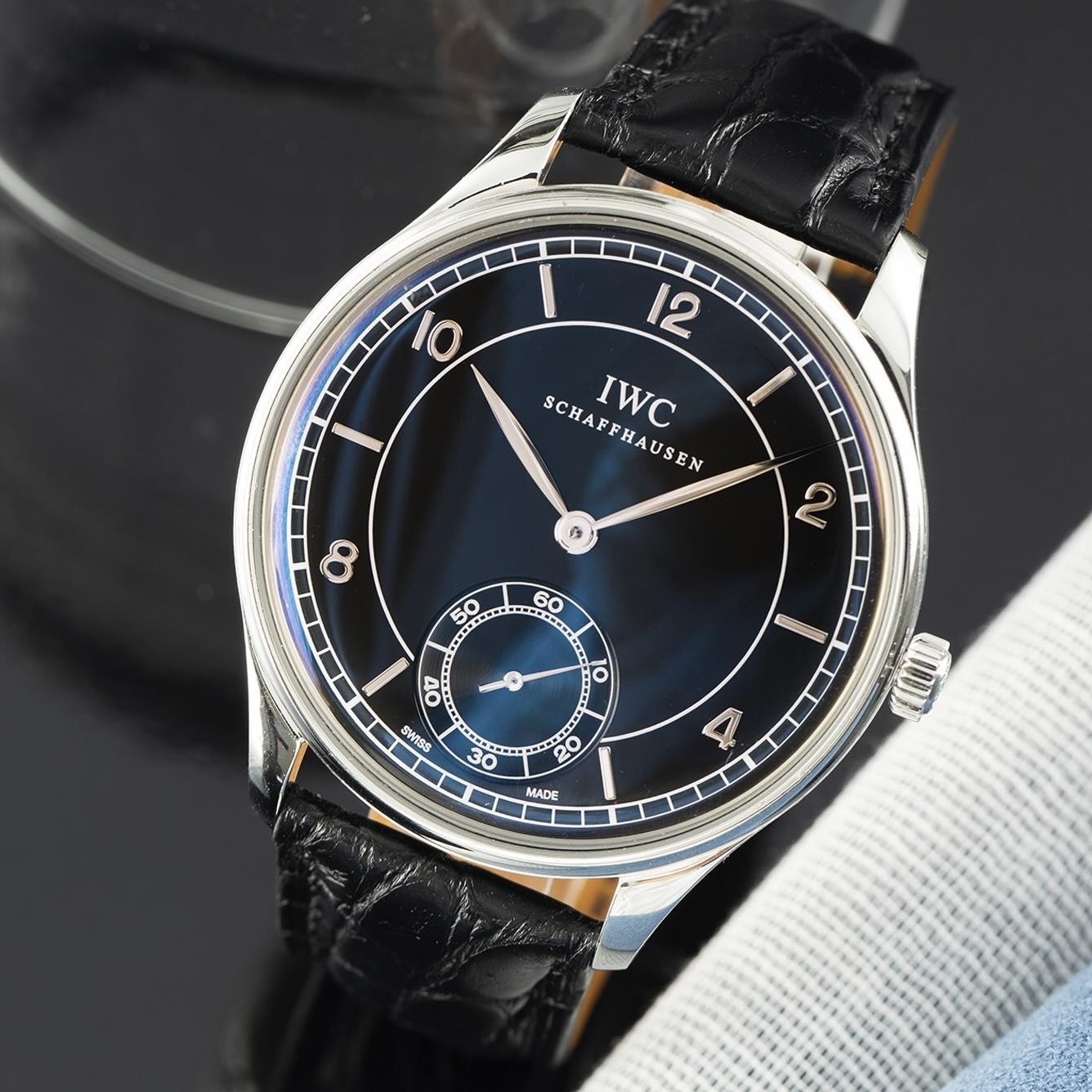

Housed in a 44mm stainless steel or platinum case with a slim 10mm profile and 30m water-resistance, the Portugieser Hand-Wound Vintage Collection Ref. IW544501 (steel) and Ref. IW544505 (platinum, limited to 500 pieces), with a small seconds sub-dial at 6 o’clock to complete the minimal yet elegant display, stayed true to the original’s essence and delivered the performance expected from a modern IWC.
2010 – Portugieser Grande Complication Ref. 3774
The IWC Portugieser Grande Complication Ref. 3774, introduced in 2010, brought the full breadth of IWC’s mechanical expertise into the Portugieser line. At 45.5mm in diameter and 16.5mm thick, the 30m water-resistant case, available in red gold or platinum, housed the extraordinary IWC-manufactured Calibre 79091. Derived from the reliable Valjoux 7750 base but completely reengineered and enhanced by IWC, the automatic Calibre 79091 featured 659 components, including 75 jewels. It operated at 28,800 vibrations/hour and delivered a 44-hour power reserve. It powered 20 distinct functions, making the watch one of the most complex ever produced by the brand.
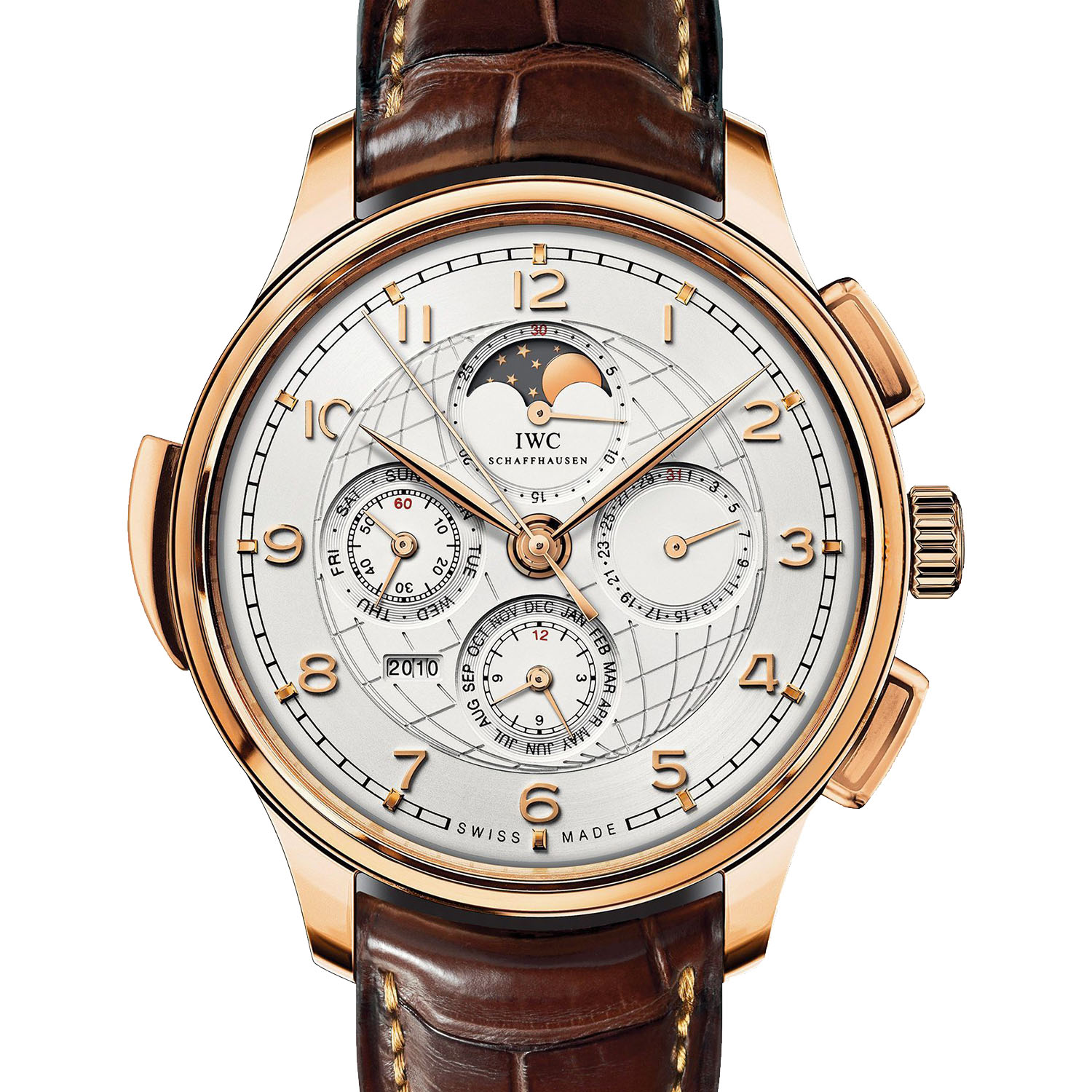

Among its complications were a perpetual calendar with a full four-digit year display, a moon phase with an accuracy deviation of one day every 122 years, and a chronograph. The perpetual calendar was mechanically programmed until 2499 and accounted for leap years automatically. A minute repeater complication was operated via a lateral slide on the left side of the case. Despite the complexity, the dial remained legible and balanced, with a refined finish, applied indices, and classical feuille hands. A discreetly engraved globe decorated the dial.
2011 – Portugieser Sidérale Scafusia Ref. 5041
Unveiled after a decade of research and development, the IWC Portugieser Sidérale Scafusia marked the most complex and ambitious timepiece ever produced by the Schaffhausen-based manufacture. A monumental entry into the realm of astronomical horology, the Sidérale Scafusia was not just a showcase of IWC’s technical prowess, but a fully bespoke, made-to-order timekeeping instrument. Each piece was individually configured for its owner’s precise geographical location, an essential factor for the watch’s primary purpose: to measure sidereal time and display a personalised celestial map.
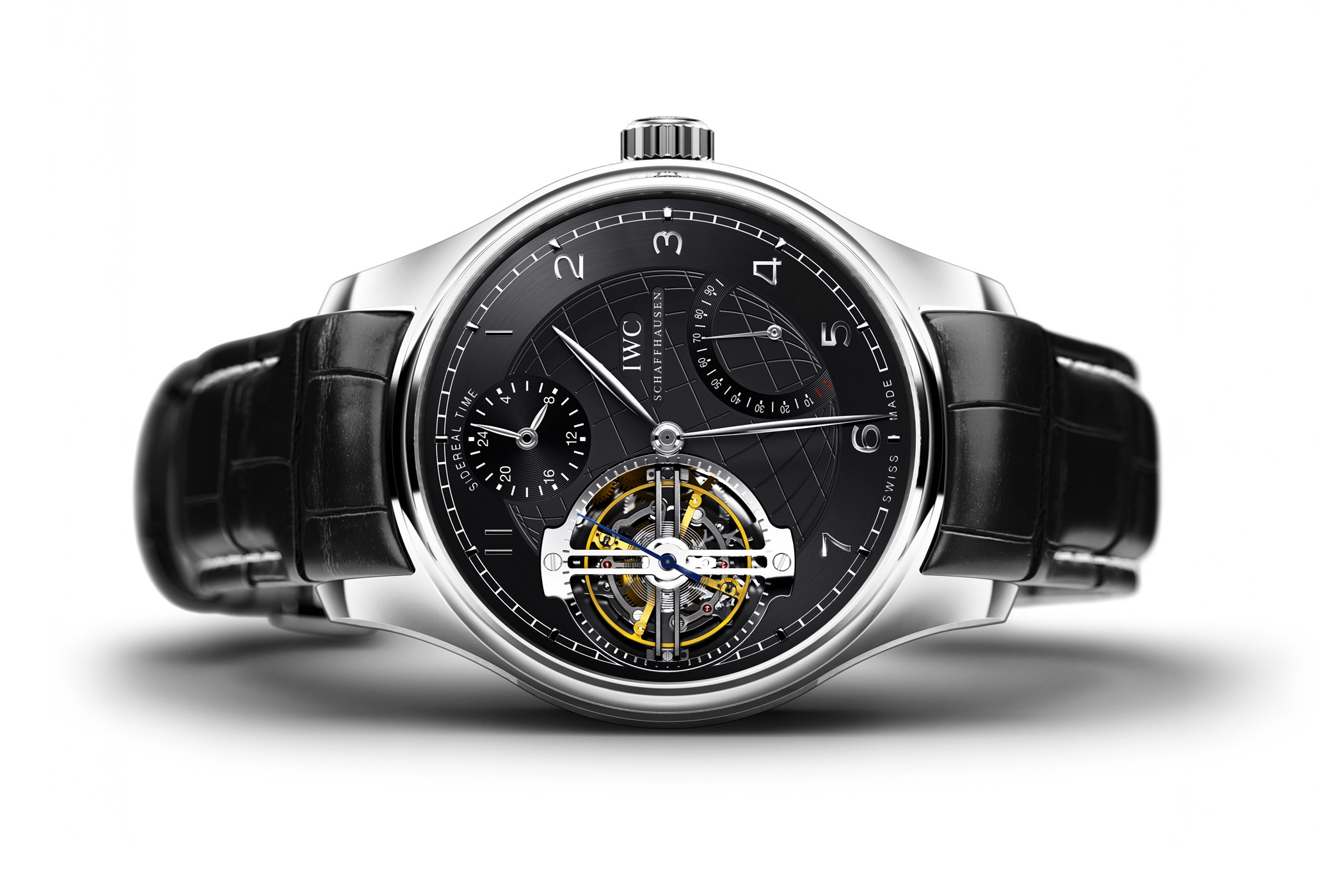

At the heart of the Sidérale Scafusia was the newly developed in-house Calibre 94900, a hand-wound movement with twin barrels providing a 96-hour power reserve. While the tourbillon at 9 o’clock with an integrated patented constant-force mechanism (with a dead-beat seconds hand on top) and a simplified perpetual calendar (with leap year display and absolute day of the year) demonstrated classical haute horlogerie, they were secondary to the astronomical focus of the watch. A sub-dial at 12 o’clock displayed sidereal time, a timekeeping system used by astronomers that tracks Earth’s rotation relative to fixed stars rather than the sun, using a 24-hour format with two hands for precision.
The watch’s reverse was even more technically astonishing. Under a sapphire crystal, a personalised celestial chart depicted the exact night sky as seen from the customer’s specific latitude and longitude. The sky chart could track the apparent movement of over 500 stars, complete with solar time, sunrise and sunset indications, equinoxes, solstices, and sidereal indications. Each map was tailored using high-precision astronomical software to ensure accuracy over the course of decades. Encased in a 46mm housing made of platinum or red gold, the Sidérale Scafusia fused astronomical science with traditional watchmaking in a manner rarely attempted, let alone accomplished; its complexity, exclusivity, and sheer technical audacity secured its place as a crown jewel and one of the most sophisticated wristwatches ever made.
2015 – Portugieser 75th Anniversary
In 2015, IWC celebrated the 75th anniversary of the Portugieser, and to mark the milestone of its most iconic watch, the company presented twelve new Portugieser models, some featuring minor refinements. The highlights included the new Automatic Reference 5007, the all-new Annual Calendar and the Hand-Wound Eight Days.
The IWC Portugieser Hand-Wound Eight Days “75th Anniversary” Edition 5102 was produced in two limited variants: 750 pieces in stainless steel and 175 in 18k red gold. Both versions featured a 30m water-resistant 43.2mm case, measuring 12.3mm thick, with a polished bezel and lugs, brushed case flanks with a domed sapphire crystal treated with anti-reflective coating on both sides. The highlight was the IWC-manufactured Calibre 59215, a large manually wound movement measuring 37.8mm in diameter and 5.6mm in thickness. It operated at a frequency of 28,800 vibrations per hour and incorporated a single mainspring barrel capable of delivering a power reserve of 192 hours (8 days). The calibre was visible through a sapphire caseback and featured Geneva stripes, perlage, and bevelled edges.
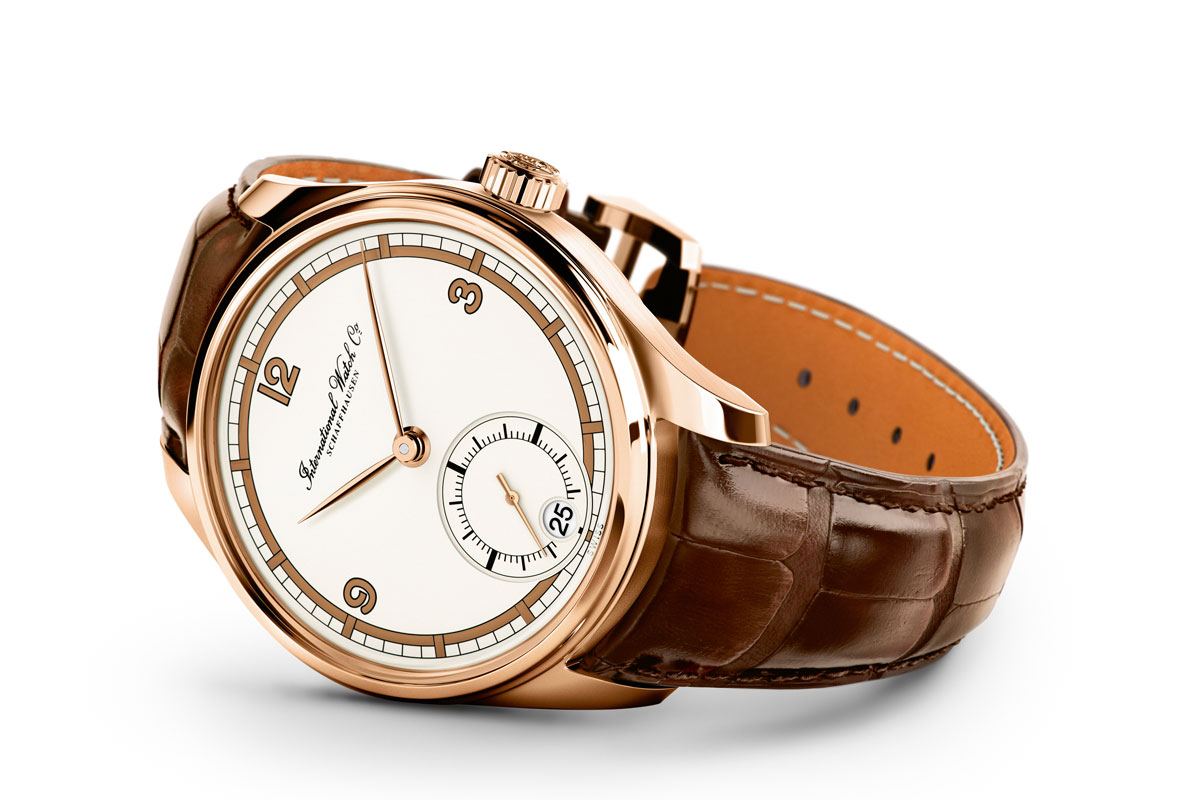

The dial layout adhered closely to the 1930s original: a railroad minute track, large Arabic numerals, and leaf-shaped hour and minute hands. A recessed small seconds sub-dial at 6 o’clock integrated a discreet round date aperture. The dial was offered in a matte black finish for the stainless steel version and a silvered finish for the gold model.
The IWC Portugieser Annual Calendar 5035 introduced the brand’s first in-house annual calendar complication, powered by the IWC-manufactured Calibre 52850. A small seconds sub-dial was placed at 9 o’clock, while a power reserve indicator was positioned at 3 o’clock. The main feature, however, was the annual calendar complication displayed through three arched apertures at 12 o’clock, indicating the month, date, and day. The calendar required adjustment only once a year, at the end of February and was fully settable via the crown.
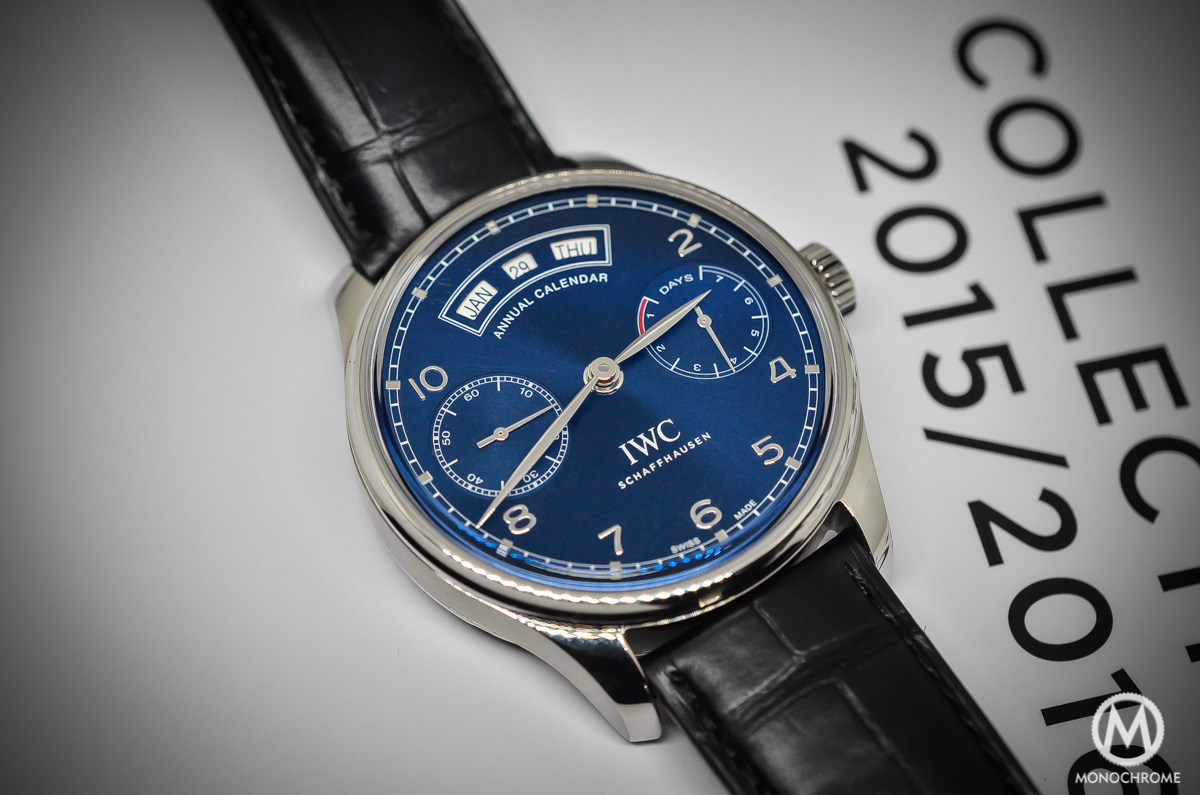

The case measured 44.2 mm in diameter and 15.3 mm in height, with a 30m water-resistance. A domed sapphire crystal with anti-reflective coating on both sides covered the dial, while a transparent sapphire caseback offered a view of the finely finished movement.
The IWC Portugieser Perpetual Calendar Digital Date-Month Ref. 3972 came in a 45mm case (available in red gold or platinum); the watch featured IWC’s in-house Calibre 89801, an automatic movement combining a flyback chronograph with a digital perpetual calendar. Unlike traditional calendar layouts, this model displayed the date and month via large digital windows at 3 and 9 o’clock, using dual-disc systems for enhanced legibility. Visible through the sapphire caseback is the Calibre 89801, built on an existing movement architecture.
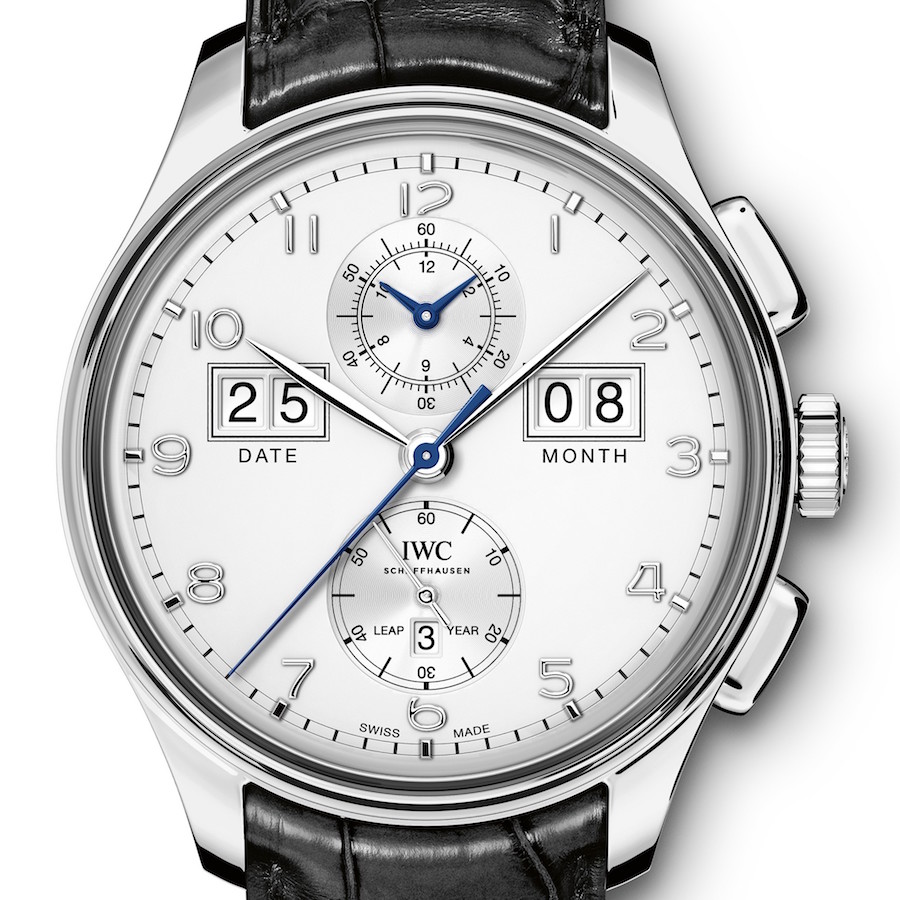

The IWC Portugieser Automatic 7 Days Ref. 5007 was a refined update of one of the brand’s cornerstone models. It maintained the essential characteristics that made the original Ref. 5000/5001 a modern classic and the iconic Portugieser design language, while introducing a significantly improved movement and subtle updates to the case and dial. The most significant evolution occurred internally; the new Automatic Ref. 5007 was powered by the in-house Calibre 52010, part of the newly developed 52000 series of movements. This calibre replaced the earlier 5000-series and was designed to improve performance and durability. The Calibre 52010 was upgraded with ceramic components for increased resistance to wear and tear. It most notably introduced twin mainspring barrels instead of the single barrel used in the Calibre 50011, resulting in a more stable torque curve across the full seven-day power reserve.
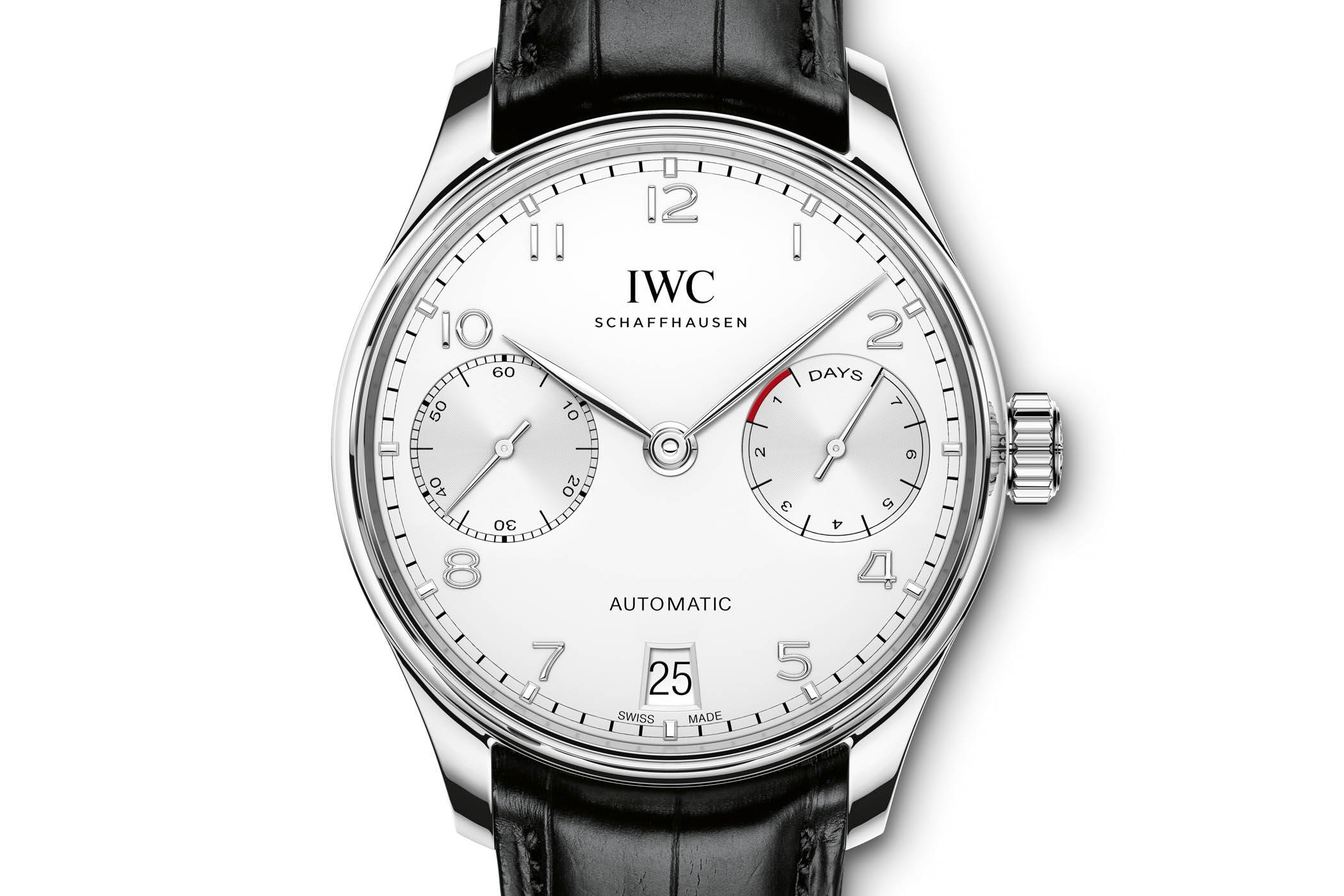

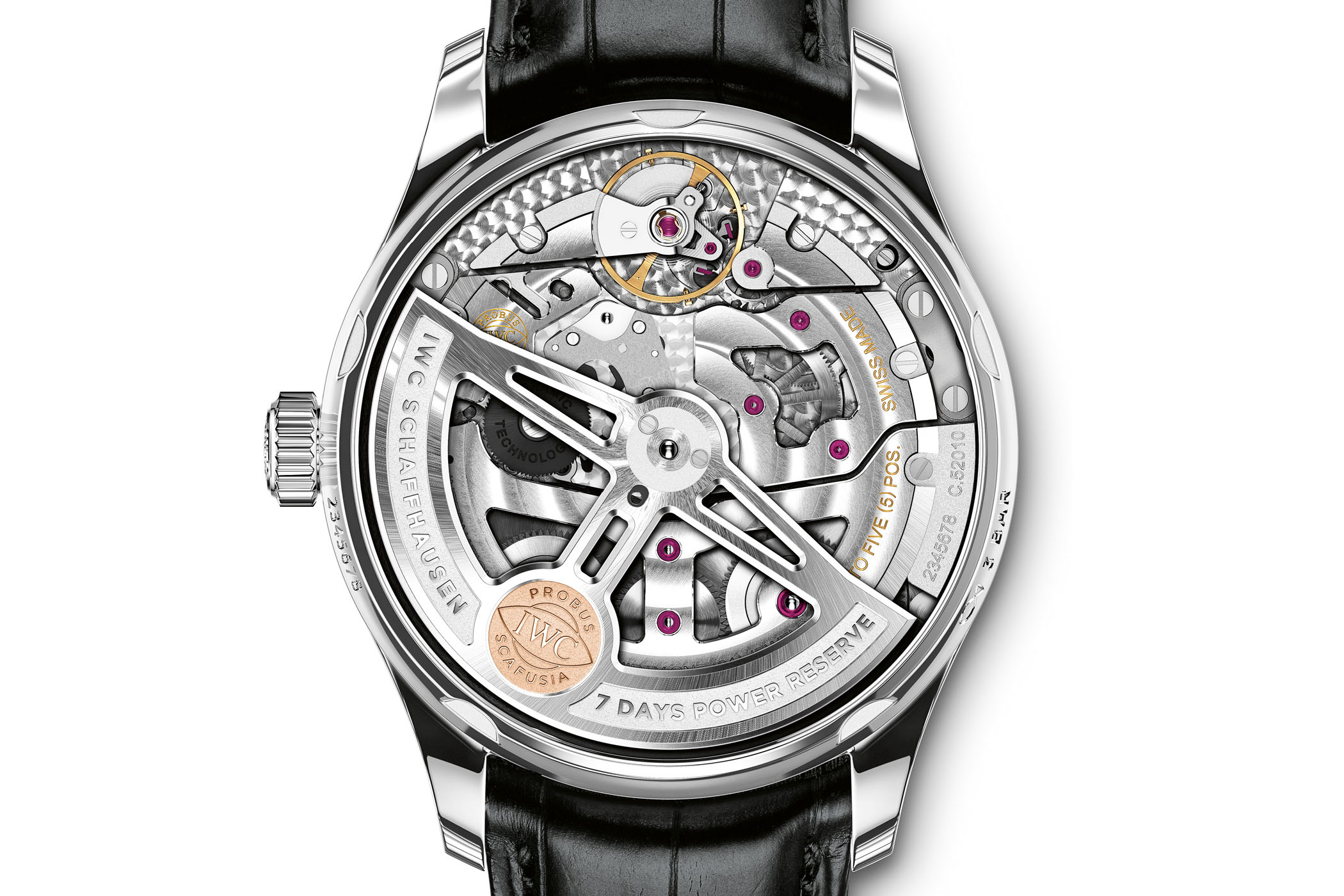

The case measured 42.3mm in diameter and 14.5mm in height, up slightly from the previous generation. The dial layout was virtually unchanged, preserving the iconic twin-register display. Several dial and case variants were launched, bridging robust engineering with refined aesthetics in a package that stayed true to its roots.
2018 – Portugieser Constant-Force Tourbillon Edition “150 Years” Ref. 5902
To mark its 150th anniversary in 2018, IWC Schaffhausen released the Portugieser Constant-Force Tourbillon Edition “150 Years,” a platinum-cased, 15-piece limited edition featuring one of the brand’s most technically advanced movements. The 46mm case stood 13.5mm tall, and the watch was powered by the in-house, hand-wound Calibre 94805, an evolution of the 94800. It combined a constant-force tourbillon and a highly precise single moon-phase display that required adjustment only once every 577.5 years.
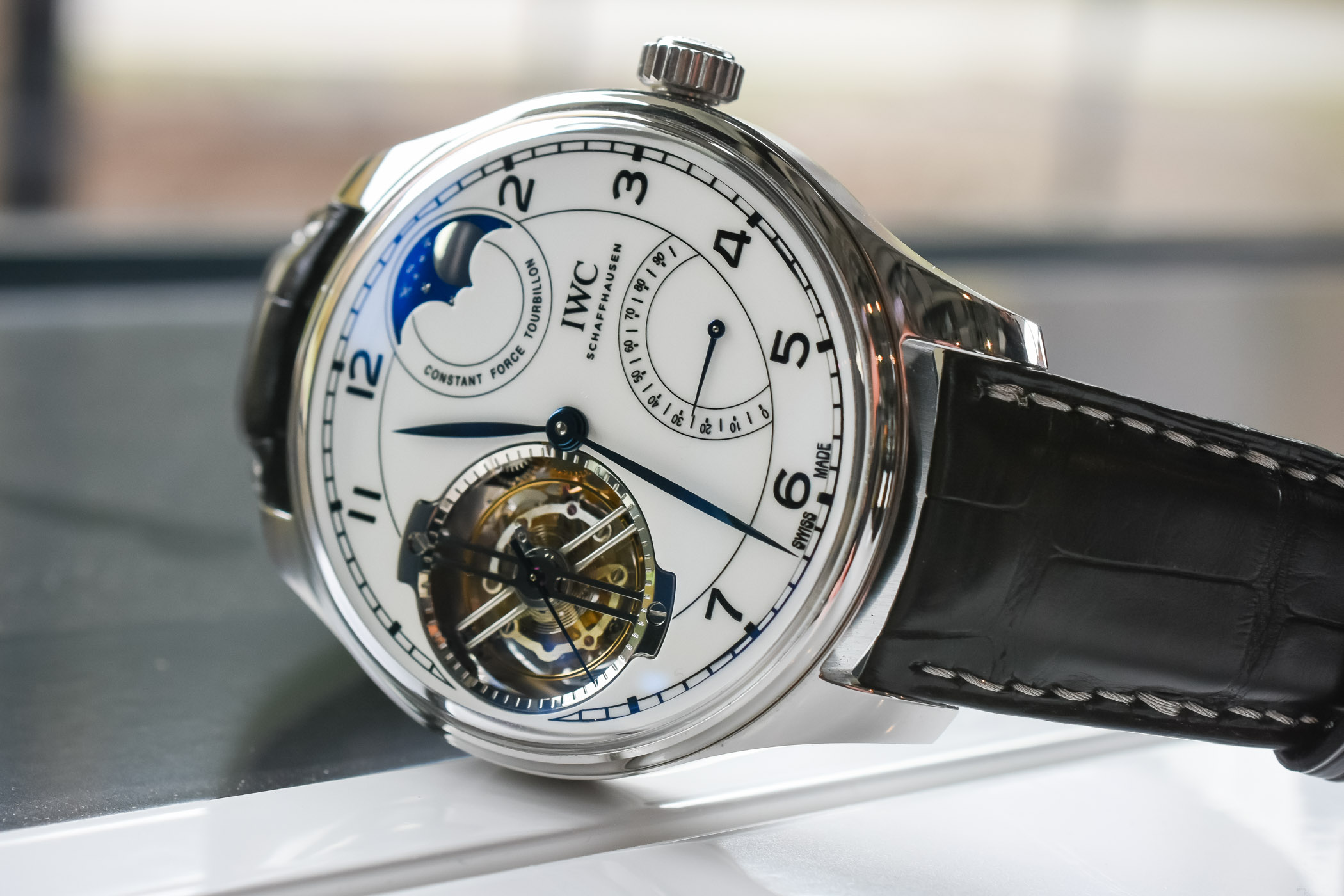

The calibre integrated two barrels to deliver a 96-hour power reserve, 48 hours of which operated in constant-force mode. A one-second remontoire mechanism ensured consistent torque to the escapement by using a secondary coiled spring that released energy to the escape wheel in even impulses. The oversized flying tourbillon at 9 o’clock (15.8mm diameter) was mounted under an openworked bridge and rotated in one-second steps, characteristic of the constant-force mechanism. The moon phase display at 1 o’clock was supplemented by a power reserve indicator at 4 o’clock.
2020 – Major revamp of the collection, new 40mm Automatic model, new Perpetual 42mm model
In 2020, IWC reintroduced a classic format to its most iconic collection with the launch of the Portugieser Automatic 40, reference IW3583, which balanced the historical appeal of the original 1939 design with a contemporary approach to size and mechanics, making it one of the most wearable and refined entries in IWC’s catalogue. Designed as a time-only model with a compact case and clean dial, this release returned to the original spirit of the Portugieser, functional, nautical-inspired precision timekeeping in an elegant form. While preserving the unmistakable DNA of the collection, this model brought updated proportions and modern mechanics for daily wear.


The case measured 40.4mm in diameter and 12.4mm in height, significantly more compact than typical Portugieser models. It retained hallmark design features such as a slim bezel, a large open dial, and a railroad-style minute track. The dial followed traditional Portugieser aesthetics with applied Arabic numerals, leaf-shaped hands, and a small seconds display at 6 o’clock. Available variants included silver-plated or blue sunray dials with gold-plated, blued, or rhodium-plated markers, depending on the case material and reference.
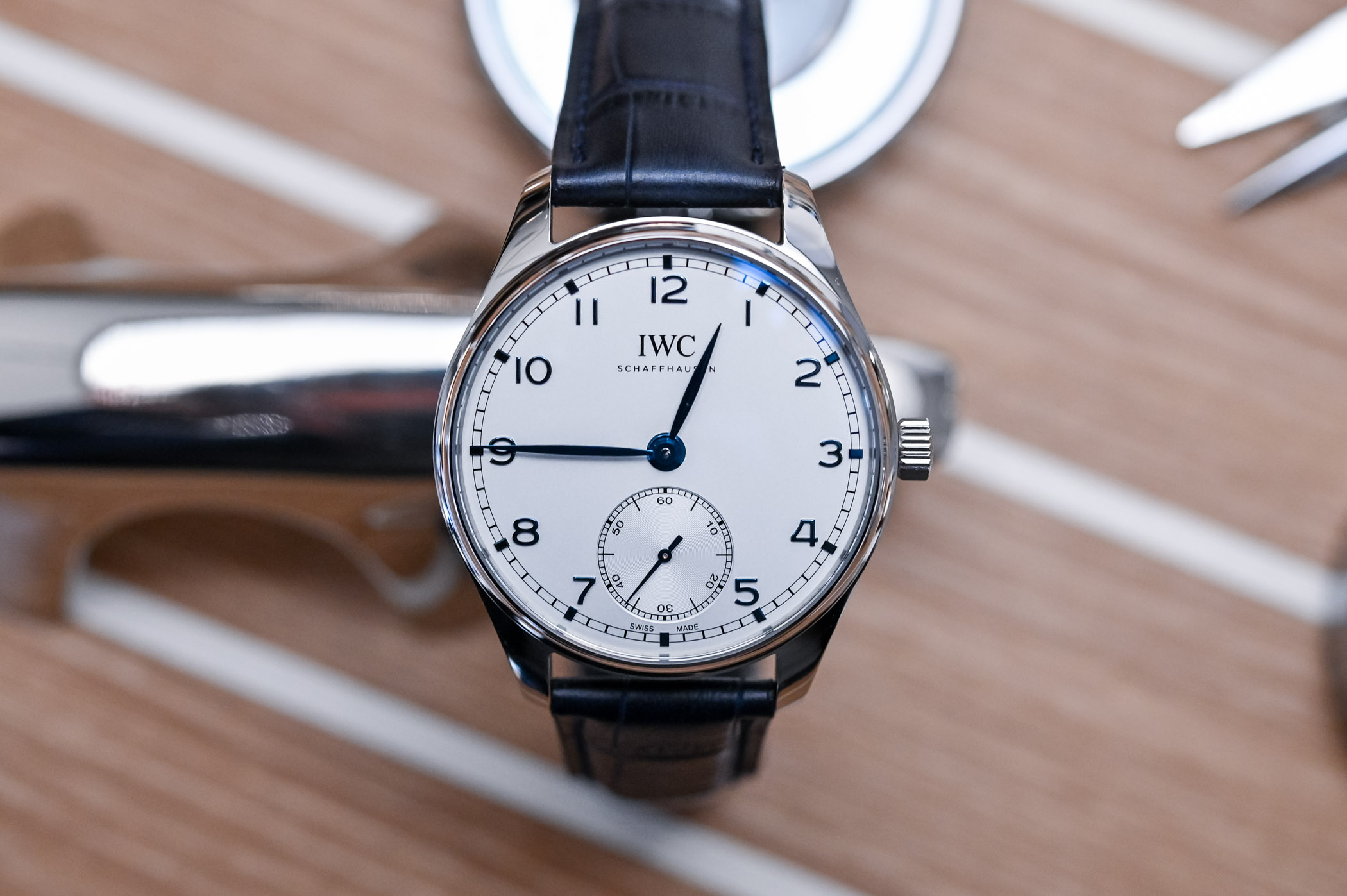

Powering the Portugieser Automatic 40 was the in-house Calibre 82200. This modern automatic movement featured IWC’s Pellaton winding system with ceramic components, a 60-hour power reserve, and a 28,800 vibrations/hour beat rate.
Next, IWC made a key technical upgrade to one of its most enduring models with the launch of the Portugieser Chronograph Ref. IW3716. While preserving the iconic design that had defined the Ref. 3714 since 1998, the new reference replaced the longstanding Valjoux-based movement with the manufacture Calibre 69355, marking a significant move toward full manufacture status for the Portugieser line.
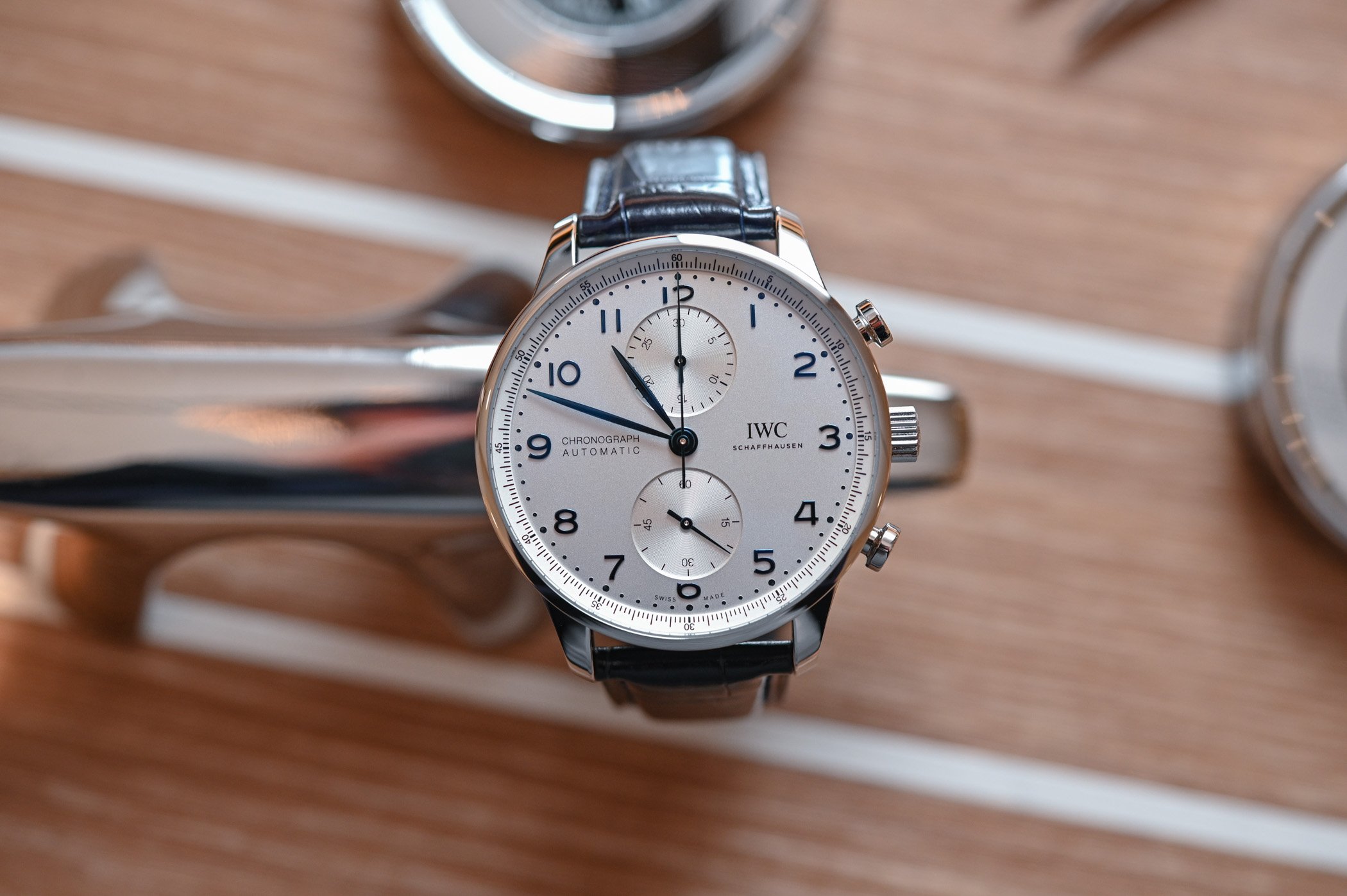

Visually, Ref. 3716 remained nearly identical to its predecessor. The case measured 41mm in diameter (slightly larger than the previous 40.9mm), with a thickness of 13.1mm, and retained the classic elements of the Portugieser Chronograph: a thin bezel, vertical sub-dials at 12 and 6 o’clock, applied Arabic numerals, leaf-shaped hands, and a symmetrical dial layout free of a date window. The polished and brushed surfaces, piston-style pushers, and domed sapphire crystal reinforced the familiar aesthetic.
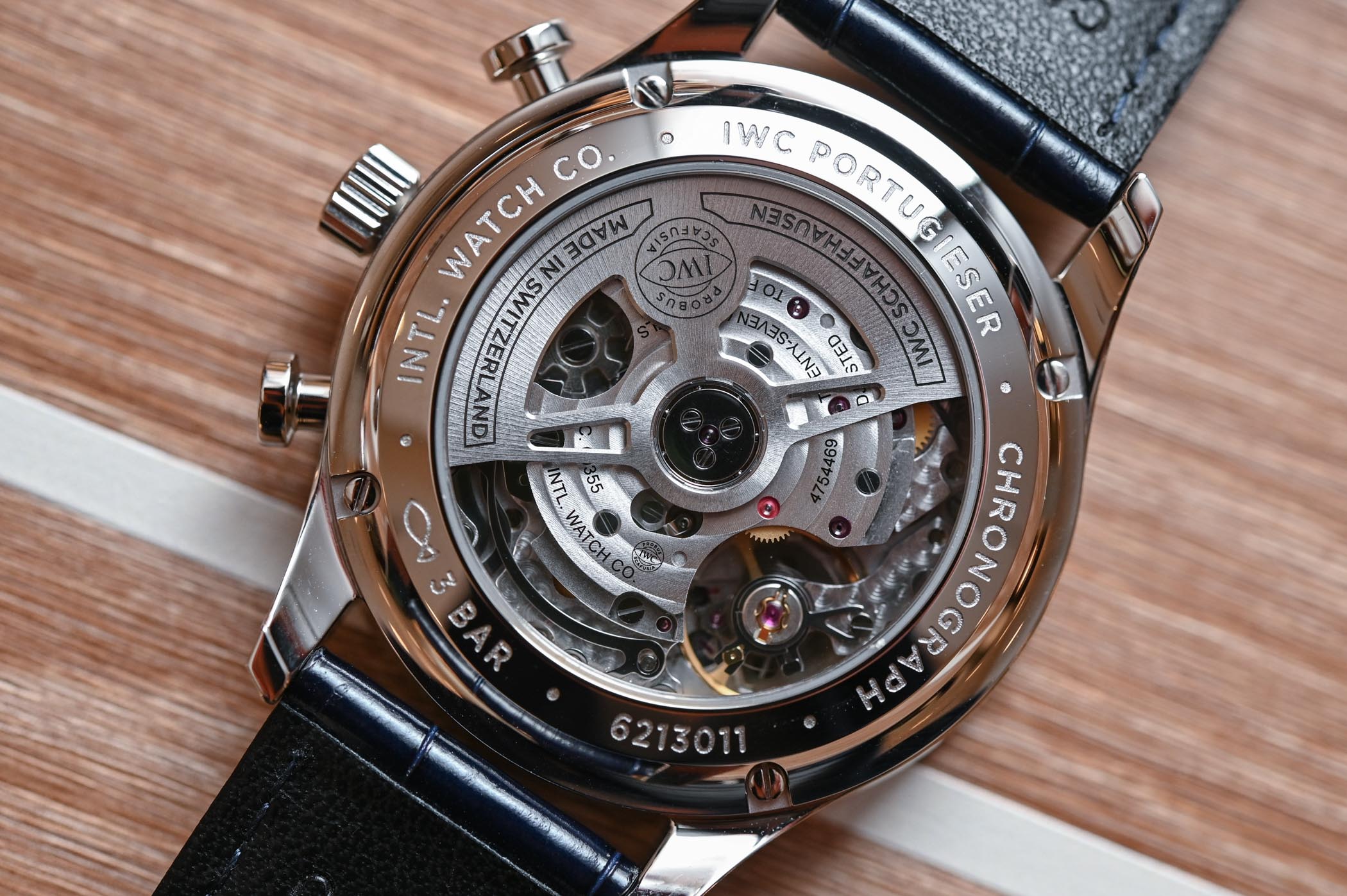

The main innovation lay in the movement. Replacing the modified ETA 7750-based Cal. 79350 was the Calibre 69355, part of the 69000-series chronograph family. This integrated automatic chronograph featured a column-wheel control mechanism and a bi-directional pawl-winding system derived from the brand’s Pellaton design. The Portugieser Chronograph IW3716 was introduced in six variations. Four were housed in stainless steel, with dial options including silver-plated (with gold or blue hands), black, and sunburst blue. Two models came in 18k 5N rose gold with a silver-plated or slate-grey dial.
In 2020, IWC also introduced a more compact and streamlined version of its iconic perpetual calendar: the Portugieser Perpetual Calendar 42 Ref. IW3442. This model retained the hallmark design codes of the Portugieser line while with a 42.4mm case diameter and a thickness of 13.8mm, it was noticeably smaller than the classic 44mm model yet still upheld the collection’s nautical-inspired presence.
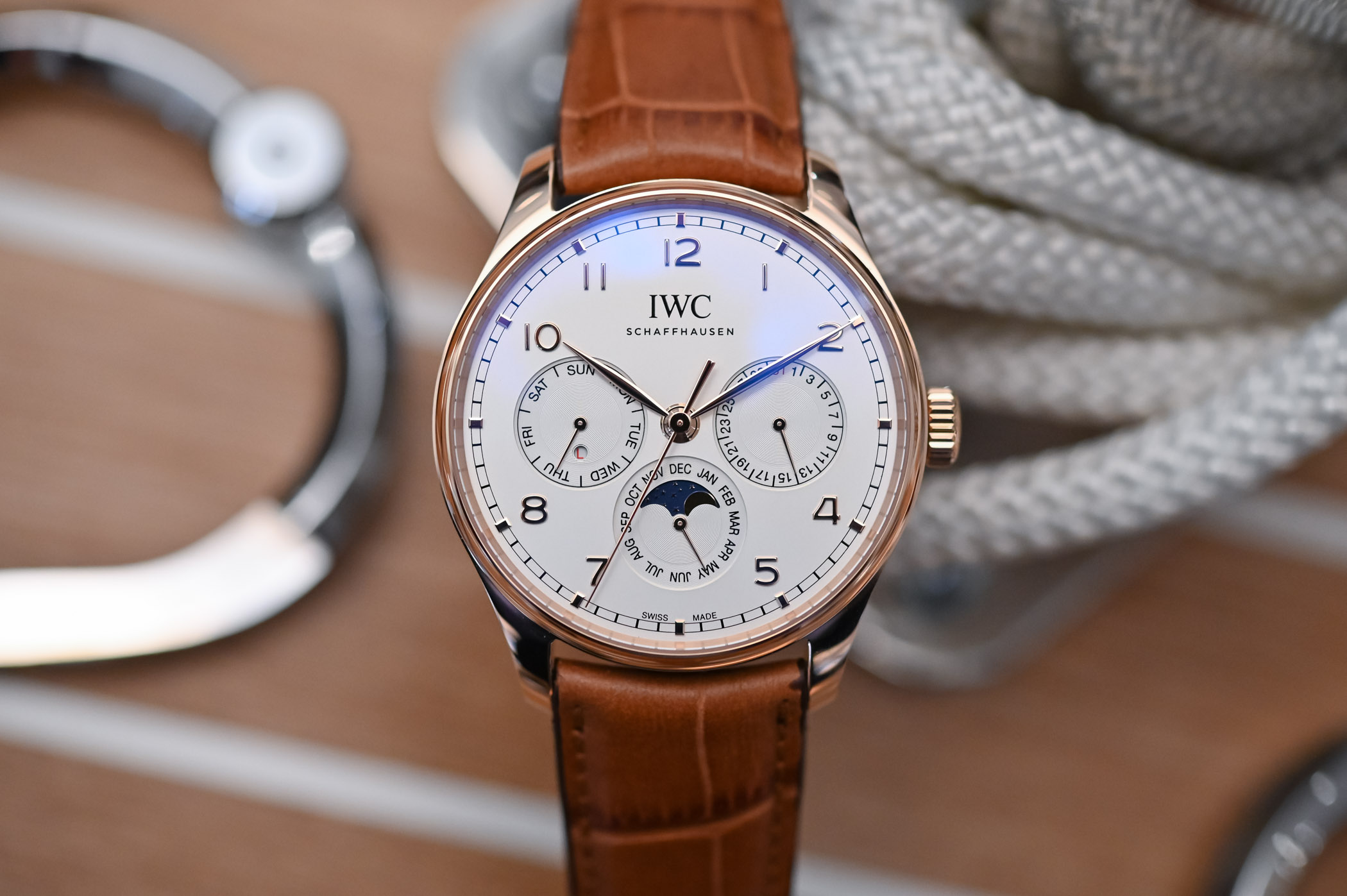

The Portugieser Perpetual Calendar 42 used the IWC-manufactured Calibre 82650, based on the robust 82000 series. This automatic movement featured the efficient Pellaton winding system with wear-resistant zirconium oxide ceramic components. Beating at 28,800 vibrations per hour, it delivered a power reserve of 60 hours. The perpetual calendar module, originally developed by Kurt Klaus, remained highly intuitive, with all indications, date, day, month, moon phase, and leap year, synchronised and adjustable via the crown.
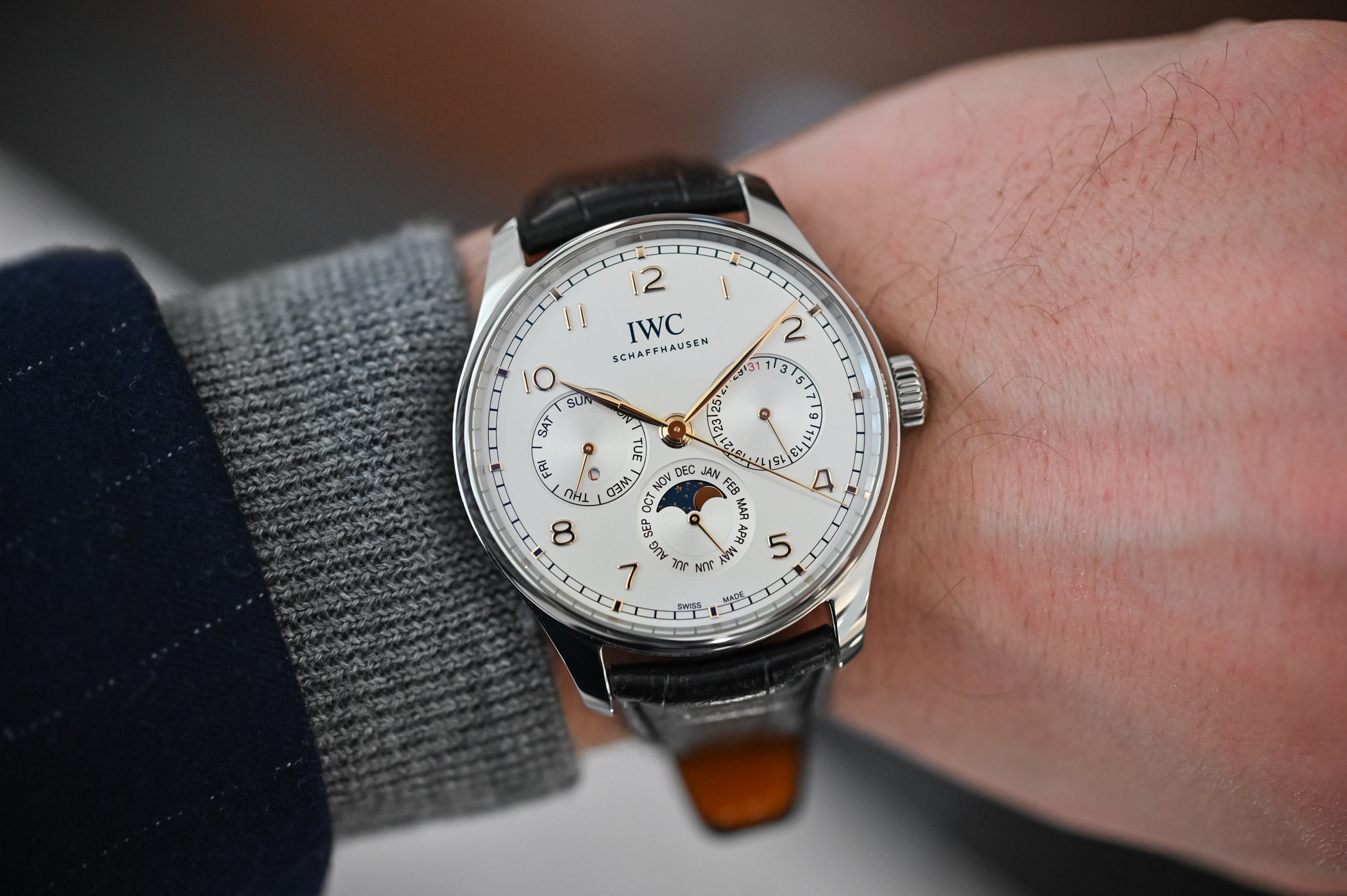

Compared to the larger version, the calendar layout was simplified. The moon phase display was moved to 6 o’clock and integrated into the month sub-dial, while the date and day appeared at 3 and 9 o’clock, respectively, alongside a small leap year aperture. The four-digit year display and small seconds were omitted. The watch was offered in two main versions: stainless steel and 18k 5N rose gold; a third variant in rose gold with a blue dial also joined the lineup.
2021 – Portugieser Hand-Wound Tourbillon Ref. 5458
The IWC Portugieser Hand-Wound Tourbillon IW545801 represented a refined addition to the Portugieser collection, a mix of classic aesthetics with a high-performance flying tourbillon in a new manual-winding movement. Designed as a slimmer, more accessible alternative to the brand’s more complex tourbillon offerings, the model followed the design direction set by the Automatic 40 and Perpetual Calendar 42, combining mechanical sophistication with compact proportions.
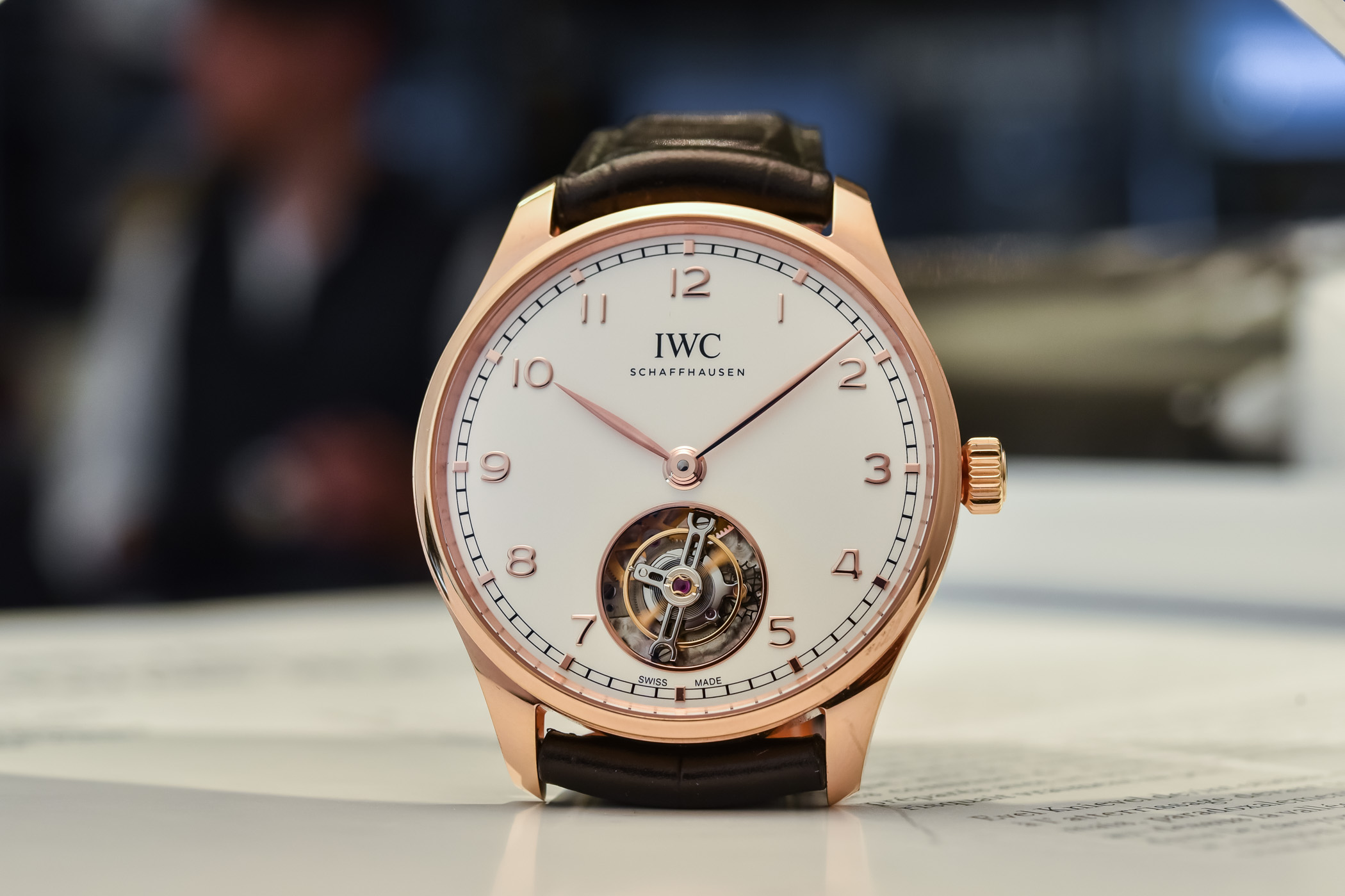

The case measured 42.4mm in diameter and 10.8mm in height, making it the thinnest Portugieser. It was crafted from IWC’s proprietary 18k Armor Gold, an enhanced red gold alloy with improved hardness and durability. The dial was silver-plated and classically styled, with applied 18k red gold Arabic numerals and leaf-shaped hands. The design was minimal, limited to hours, minutes, and a prominent one-minute flying tourbillon at 6 o’clock. This modern tourbillon featured a silicon pallet fork and escape wheel coated with IWC’s low-friction Diamond Shell technology. Uniquely, the mechanism also incorporated a hacking function, an uncommon feature for tourbillons. Powering the watch was the new Calibre 81905, a hand-wound movement explicitly developed for this model.
The current Portugieser collection (2024) and concluding notes
In 2024, IWC revealed quite a few updated Portugieser models: Perpetual Calendar 44 Ref. 5037, Automatic 40 and 42 models with new dials and cases, and the Yacht Club Moon & Tide became the first IWC watch to use a silicon hairspring. The new Portugieser Hand-Wound Tourbillon Ref. IW5459 was now accompanied by a 24-hour rotating globe to indicate night and day, powered by the new IWC Calibre 81925. However, 2024 will be remembered as the year when the brand introduced its Portugieser Eternal Calendar Ref. 5057.
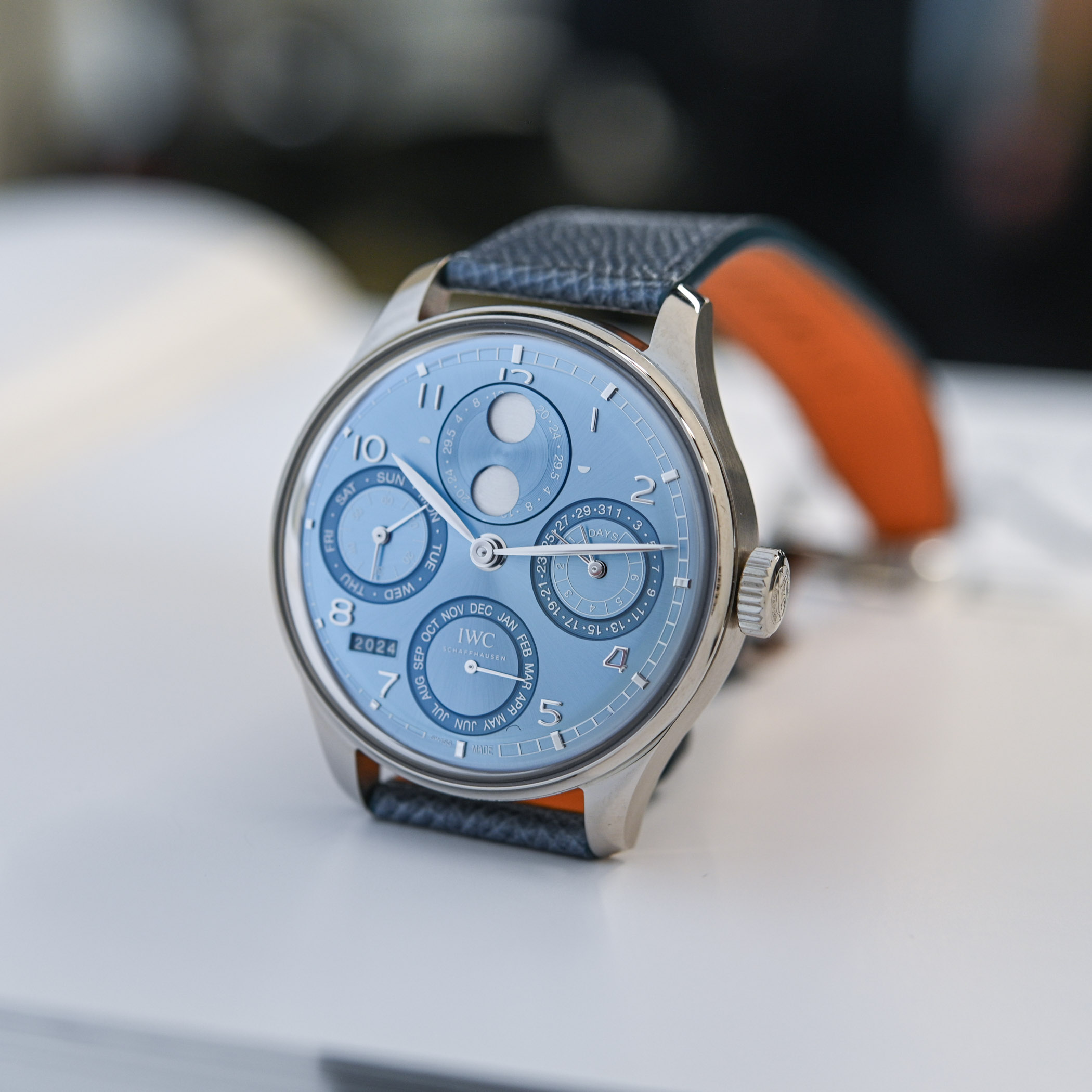

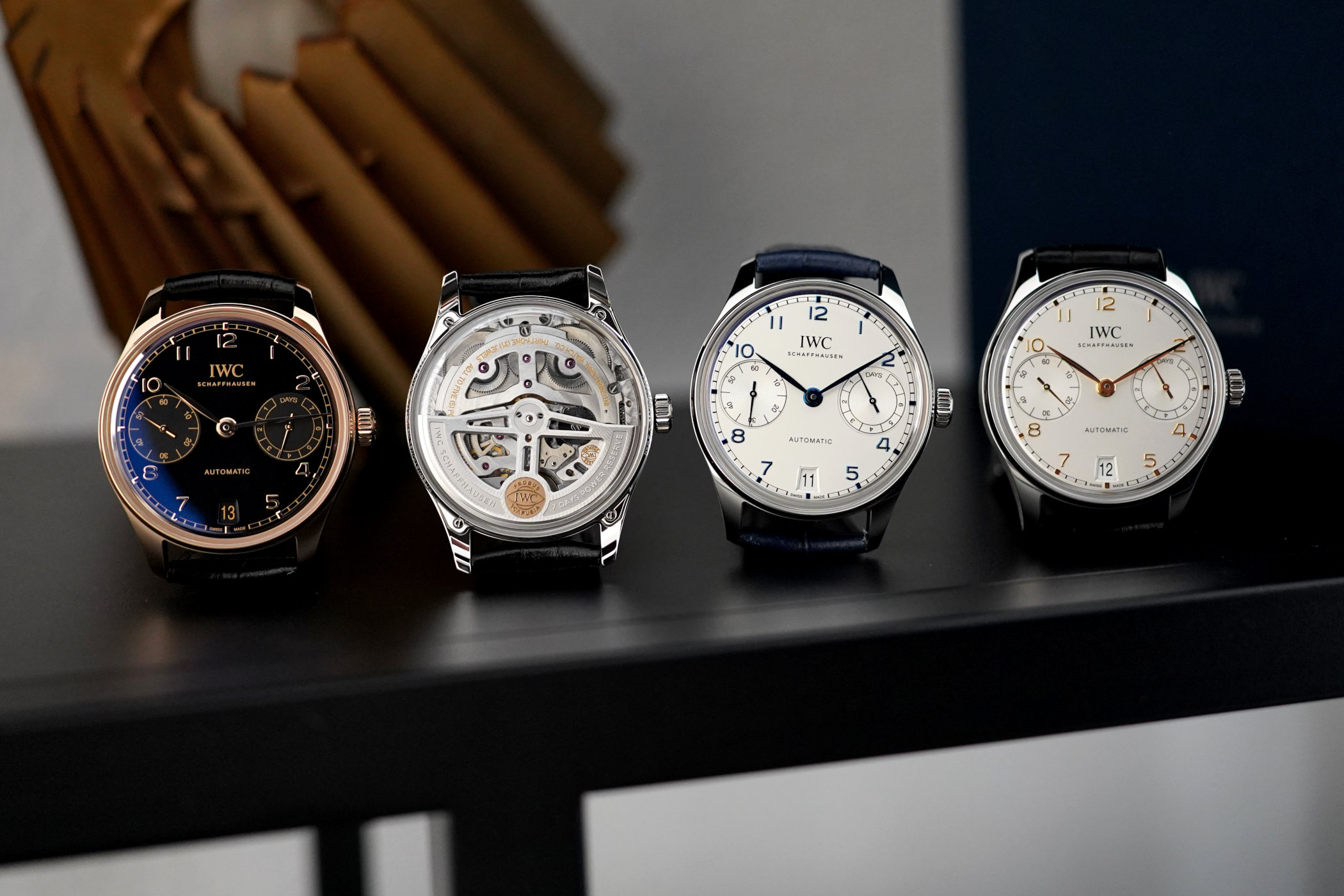

The IWC Portugieser Eternal Calendar marked another major technical achievement for the brand, its first secular perpetual calendar. Unlike conventional perpetual calendars requiring adjustment in centurial years like 2100, the Eternal Calendar accounted for the Gregorian calendar’s exceptions with a 400-year gear. This allowed the watch to correctly skip three leap years every four centuries, eliminating the need for adjustment until 3999. You can read all about it in this in-depth article.
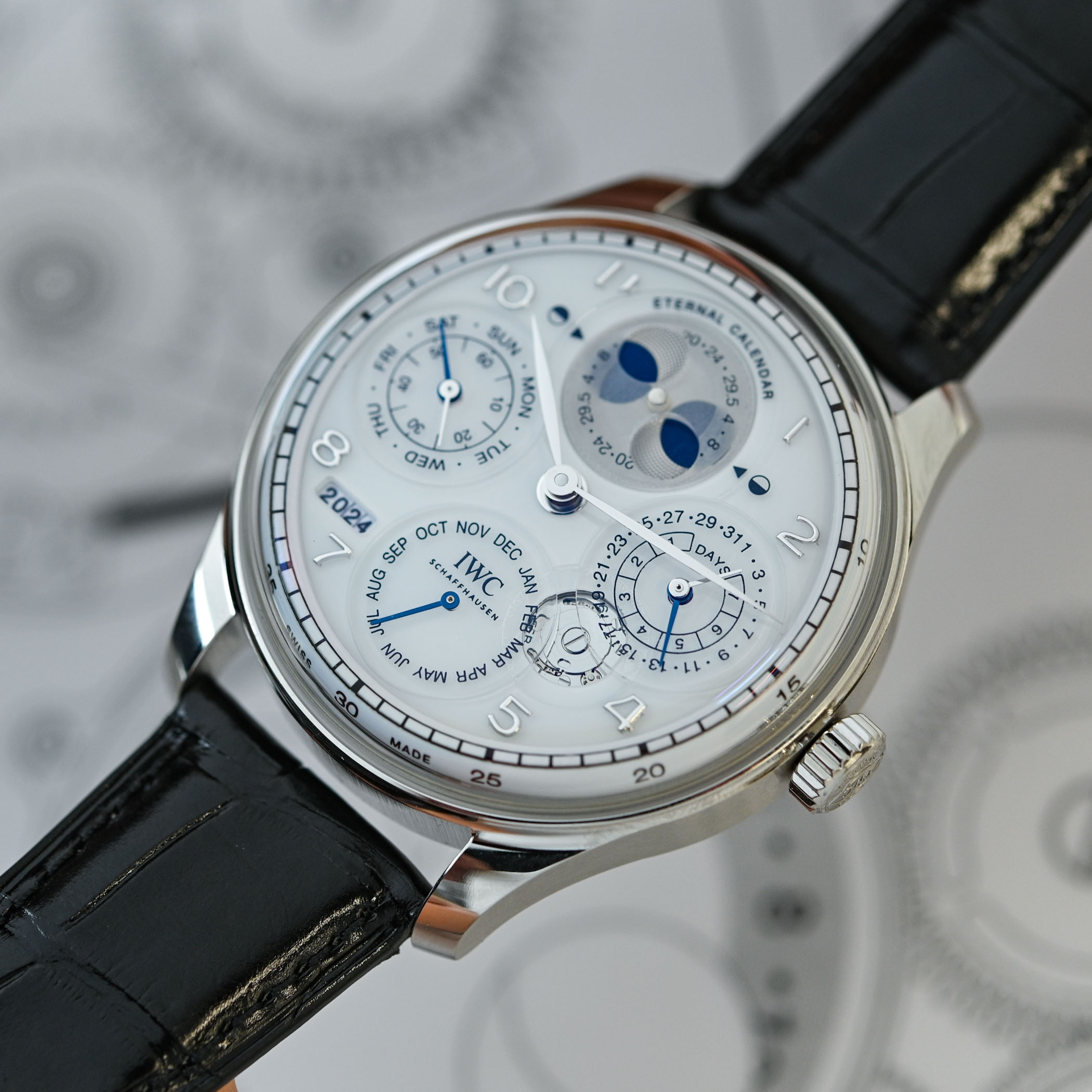

As of today, the IWC Portugieser collection comprises 58 references, which quite brilliantly bridge the gap between classic design and modern mechanics, offering refined simplicity and grand complexity. Over the decades, the Portugieser has proven remarkably adaptable without losing its identity. From elegant time-only models to grand complications such as the Perpetual Calendar, Constant-Force Tourbillon, and Sidérale Scafusia, the collection has maintained a design language rooted in clarity, symmetry, and precision. Whether housing classic Valjoux-based chronographs or in-house movements, every reference upholds the commitment to functional elegance and engineering excellence.
The collection’s modern renaissance, spanning achievements like the 7-day automatic Calibre 5000, integration of Kurt Klaus’s revolutionary perpetual calendar module, and the recent launch of the secular Eternal Calendar, has reaffirmed the Portugieser as IWC’s flagship. What began in 1939 as an oversized wristwatch with a pocket watch movement, a project to meet the needs of two Portuguese merchants, has evolved into a platform for some of IWC’s most celebrated horological achievements.
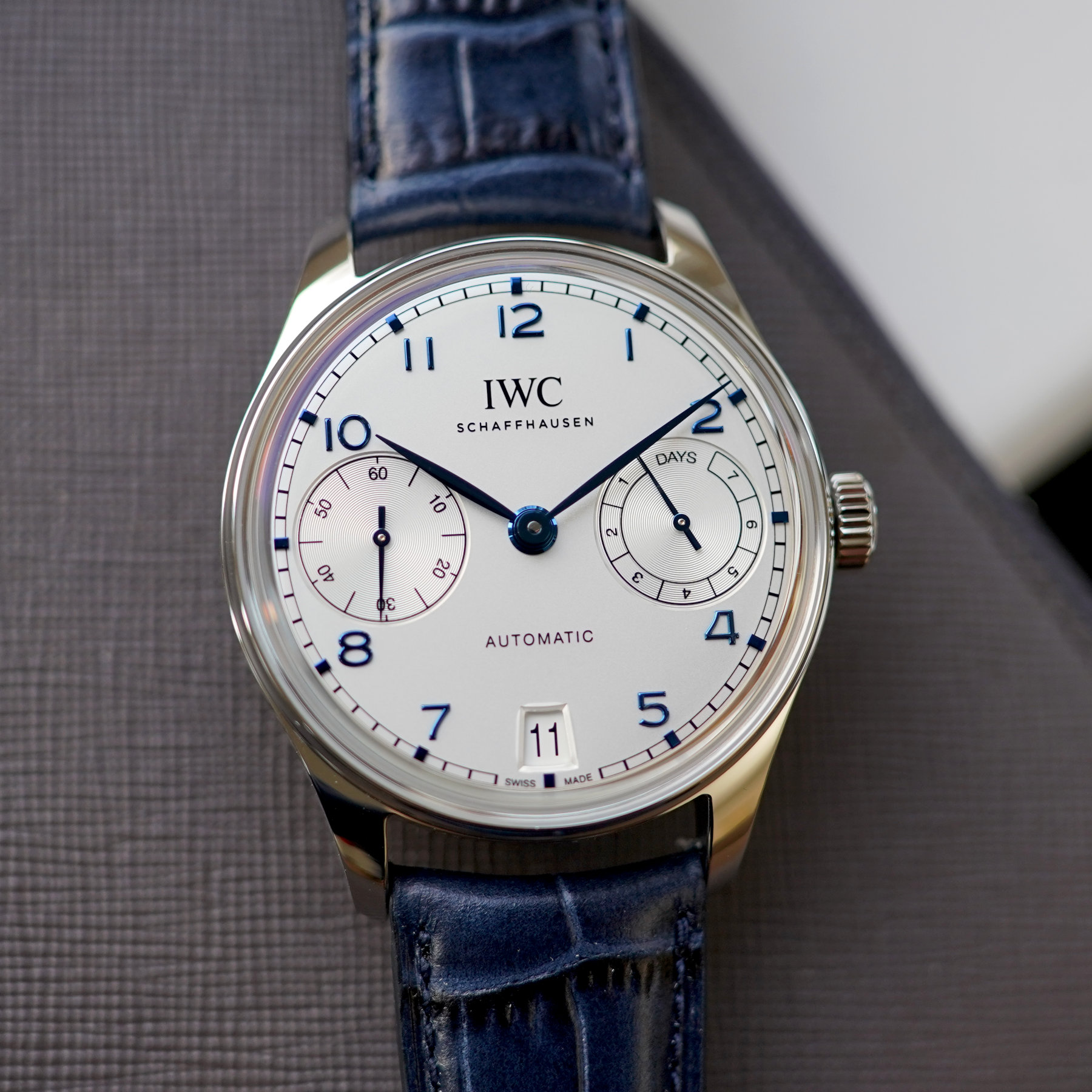

The Portugieser is a canvas for IWC’s past, present, and future innovations. Few collections in the industry can claim such a coherent yet diverse legacy, and we are happy to share the story with you. While not every reference since 1993 made it into this story, we hope to have included the most important ones.
https://monochrome-watches.com/complete-history-of-the-iwc-portugieser-collection-in-depth-evergreen/
